SSRS / komunistinė okupacija IV Sovietų okupacija
1940 m. nepriklausoma Latvijos valstybė nustojo egzistuoti dėl Latvijos okupacijos ir aneksijos Sovietų Sąjungos bei inkorporacijos į Sovietų Socialistinių Respublikų Sąjungą (SSRS).
Buvo panaikintos visos institucijos, užtikrinusios valstybės suverenitetą, įskaitant Užsienio reikalų departamentą, ginkluotąsias pajėgas ir pasienio apsaugą. Latvijos atstovybės užsienyje buvo uždarytos, o jų pastatus ir turtą perėmė SSRS. Armija ir pasienio apsauga buvo sumažintos, pakeisti karininkai ir vadai.
Sovietinė okupacija tęsėsi iki 1991 m.
Okupacijos metu įvyko du masiniai Latvijos gyventojų trėmimai – vienas 1941 m. ir vienas 1949 m., kurių metu žmonės buvo represuojami ir skleidžiama propaganda, be to, buvo vykdomos pinigų reformos.
Daugiau informacijos šaltinių
1. Sovietinė okupacija – Latvijos okupacijos muziejus (okupacijasmuzejs.lv)
2. Sovietų okupacija – Latvijos okupacijos muziejus (okupacijasmuzejs.lv)
Jūsų komentarai
Sveiki! Dėkojame už komentarą! Tokie faktai paminėti atitinkamos srities ekspertų parengtuose istoriniuose šaltiniuose. Jei turite kitų skaičių ir faktų pirmiau minėta tema, pasidalykite šia informacija su mumis, nurodydami šaltinį. Pagarbiai "Kaimo keliautojas"
Be to, sovietų lėktuvai retkarčiais darydavo klaidų, numesdami bombas ir raketas už bandymų aikštelės teritorijos ribų. Pavyzdžiui, 1967 metais Salduje nukrito trys bombos. Incidentai tęsėsi net antroje devintojo dešimtmečio pusėje. Žemai skrendančių orlaivių sukeltos smūginės bangos ne kartą išdaužė langus Saldaus vidurinėje mokykloje. Atsikratyti sąvartyno pavyko tik Rusijos kariuomenei pasitraukus 1993 m., kai taip pat buvo atkurta ir Zvardės parapija, kuri šiuo metu yra Saldus krašte. Latvijos okupacijų tyrimo draugijos sukaupti archyviniai duomenys rodo, kad sovietų okupacijos metais Latvijos TSR teritorijoje SSRS kariuomenės reikmėms iš viso buvo skirta 163 856 hektarai žemės (neįskaitant miestų), o šioje žemėje buvo likviduoti 1 335 ūkiai. lasi.lv Viesturs Sprūde, Lilija Limane / Latvijas Avīze
Susijusi laiko juosta
Susijusios vietos
Ventspilio 46-osios pakrantės gynybos baterijos ugnies korekcijos bokštas
Atkurtas 46-osios pakrančių apsaugos baterijos ugnies valdymo bokštas Ventspilyje yra Saulrietos gatvėje ir lankytojams prieinamas apžvalgos bokšto pavidalu. Šalia bokšto yra keturios artilerijos pabūklų pozicijos, ir tai vienintelė tokios geros būklės Antrojo pasaulinio karo pakrančių gynybos baterija Latvijoje. Lankytojai gali lipti bokšto laiptais į lauko apžvalgos aikštelę su vaizdu į jūrą. Šalia bokšto yra informacinis stendas su QR kodu. Naudodami QR kodą galite žiūrėti animaciją apie istorinius įvykius. Į bokštą veda nauja gatvė, didelė automobilių stovėjimo aikštelė ir medinis pėsčiųjų tiltas, einantis per šalia bokšto esančią saugomą gamtos teritoriją.
Šis karinis kompleksas buvo pastatytas 1939 m., žymint SSRS karinių bazių statybos Latvijoje pradžią. 46-oji pakrančių apsaugos baterija turėjo keturias pozicijas B-13 tipo pabūklams. Pirmąjį karinį mūšį ši baterija surengė 1941 m. birželio 24 d., kai Ventspilio uostą užpuolė vokiečių torpediniai kateriai, kurie baterijų ugnimi buvo atitraukti nuo Baltijos jūros krantų. Birželio 28 d. sovietų armija susprogdino pabūklus ir pasitraukė.
Žvaigždė - Irbenės kariniai pastatai
200 hektarų ploto teritorija kadaise buvo itin slapta karinė bazė, kurioje buvo įsikūręs 51429 karinis dalinys.
Olmano baterija Nr. 456 (sovietų karinė bazė „Krasnoflotska“)
Pirmosios pakrantės gynybos baterijos Irbės sąsiaurio gynybai buvo pastatytos po 1912 m., kai buvo patvirtintas Baltijos laivyno minų ir artilerijos gynybos pozicijų planas, kuriame buvo numatytos kelios pakrantės gynybos baterijos ir jūros minų statymas.
Irbės sąsiaurio pozicija buvo toliausiai į pietus, o jos užduotis buvo užblokuoti bet kokį priešo patekimą į Rygos įlanką. Pagrindinis dėmesys buvo skiriamas jūrinėms minoms, kurių dešimtys tūkstančių buvo padėti Irbės sąsiauryje Pirmojo pasaulinio karo metu Baltijos laivyno laivai. Tik 1916 m. Saremos salos pietiniame gale, Sorvės kyšulyje, pradėtos statyti pakrantės gynybos baterijos. Iš viso buvo pastatytos septynios baterijos, o 43-ioji baterija buvo aprūpinta 305 mm pabūklais. Latvijos Irbės sąsiaurio pakrantėje gynybos baterijų nebuvo pastatyta.
Net ir įkūrus Latvijos Respubliką, Latvijos armija ir karinis jūrų laivynas neįrengė artilerijos pozicijų Irbės sąsiauriui ginti.
Padėtis pasikeitė po 1939 m. spalio 5 d. Latvijos Respublikos ir SSRS savitarpio pagalbos pakto, kuris numatė Raudonosios armijos ir Baltijos karinio jūrų laivyno kontingento dislokavimą Kuržemėje. Sovietų Sąjungos planuose taip pat buvo numatyta sukurti pakrantės gynybos sistemą pagal 1912 m. planą su patobulinimais. Buvo numatyta pastatyti pakrantės gynybos baterijas Liepojos tvirtovės vietoje, naujas baterijas į pietus nuo Ventspilio (46-oji baterija) ir dvi baterijas siauriausioje Irbės sąsiaurio dalyje netoli Mikeltornio. Jau po Latvijos okupacijos ir aneksijos Baltijos karinio jūrų laivyno pakrantės gynybos planai buvo papildyti ir iki 1941 m. birželio mėn. buvo planuojama įkurti 207-ąją artilerijos diviziją su penkiomis baterijomis šiaurinėje Kuržemės dalyje. Mikeltornio apylinkėse turėjo būti įrengtos dvi baterijos – 40-oji baterija Lūžnoje su 130 mm B-13 pabūklais gelžbetoniniuose įtvirtinimuose ir 117-oji baterija Olmaniuose (vieta Latvijos armijos žemėlapiuose pažymėta Ķesteriais) su 152 mm MU-2 pabūklais. Kadangi 152 mm pabūklų kūrimas nebuvo baigtas, ant baterijos gelžbetoninių įtvirtinimų buvo pastatytos laikinos medinės platformos ir sumontuoti dar keturi 130 mm pabūklai. Abi baterijos buvo baigtos iki 1941 m. birželio mėn., tačiau kare prieš vokiečių 291-ąją pėstininkų diviziją baterijų nepavyko aptikti, todėl jų įgulos persikėlė į Saremos salą.
Antrojo pasaulinio karo pabaigoje Vokietijos armijų grupė „Kuršas“ gana rimtai svarstė galimus sovietų išsilaipinimus šiaurinėje Kuršo dalyje, ypač ištirpus ledui Suomijos įlankoje ir vakarinėje Estijos pakrantėje. Visoje Kuršo pakrantėje buvo dislokuotos savadarbės pakrantės gynybos baterijos. Sovietų Sąjungos 40-oji baterija „Gerate Batterie Sommer“, priklausanti 289-ajai artilerijos divizijai, su dviem 122 mm sovietinėmis haubicomis, buvo dislokuota gelžbetoninėse pozicijose netoli Lužnės. 117-osios baterijos pozicijų rajone buvo 530-osios artilerijos divizijos 2-oji baterija su trimis 152 mm sovietinėmis trofėjinėmis patrankomis, trimis 37 mm zenitiniais dronais, vienu 20 mm keturių vamzdžių zenitiniu dronu, dviem 75 mm prieštankinėmis patrankomis ir dviem minosvaidžiais apšvietimui.
Pasibaigus aktyviems karo veiksmams 1945 m. gegužę, SSRS pradėjo atkurti pakrantės gynybos sistemą Kuržemės pakrantėje. 1945 m. rudenį netoli Olmanių ūkio, kuris buvo pervadintas į „Krasnoflotskaja“, buvo dislokuota laikina 456-oji baterija su 152 mm Kane sistemos pabūklais.
1952 m. laikini baterijos pabūklai buvo pakeisti naujausiais 152 mm MU-2 ginklų sistemomis. Bateriją sudarė keturios gelžbetoninės pabūklų pozicijos, gelžbetoninis vadovavimo postas su tolimačio bokšteliu ir techniniai pastatai. Baterijos statyba buvo baigta 1958 m.
1958 m., išmontavus Lūžnios pakrantės gynybos bateriją, ją pakeitė mobili 130 mm SM-4-1 patrankų baterija Nr. 343. Mobiliosios patrankos neturėjo gelžbetoninių patrankų lizdų, tačiau buvo pastatytos kelios rąstų ir smėlio konstrukcijos.
343 baterija veikė iki septintojo dešimtmečio pradžios, o 456 baterija – iki 1975 m., kai buvo išsaugota. Baterijų pozicijose buvo dislokuoti S-125 oro gynybos raketų kompleksai, taip pat 10-asis pakrantės gynybos artilerijos-raketų pulkas su CP-2 „Sopka“ raketų kompleksais, o infrastruktūra buvo atitinkamai modifikuota.
Sovietų armija Olmanių ir Lūžnių baterijų infrastruktūrą Latvijos Respublikai perdavė 1993 m.
Buvęs sovietinės pasienio apsaugos stebėjimo bokštas Paviluostoje
Sovietinis pasienio apsaugos apžvalgos bokštas yra netoli Pietinio molo Paviluostoje. Buvęs sovietinis pasienio apsaugos apžvalgos bokštas, kuris buvo nenaudojamas nuo XX a. dešimtojo dešimtmečio pradžios, dabar tarnauja kaip apžvalgos aikštelė su 360 laipsnių kampu besisukančiu sausumos teleskopu. Iš jo atsiveria gražūs jūros ir laivų vaizdai, jį galima naudoti paukščių stebėjimui. Lipti į bokštą leidžiama tik vasaros sezonu dienos šviesoje. Kadangi bokšto laiptai yra gana statūs, lankytojai turėtų įvertinti savo sugebėjimus, sveikatą ir susijusią riziką. Apžvalgos bokštas ir apylinkės stebimos vaizdo kameromis. Žiemos sezonu bokštas lankytojams uždarytas.
Sovietų armijos automobilių kolekcija
Edgaras Kārklevalkas Dundagos rajone valdo svečių namus „Pūpoli“ ir jau daugiau nei 15 metų savo restauruotu sovietinės armijos sunkvežimiu GAZ-66 (iki 24 asmenų) ir UAZ-3151 (iki 6 asmenų) veda žmones į istorines ir edukacines keliones po šiaurinę Kuržemę (įskaitant buvusias karines teritorijas). Sovietinės armijos sunkvežimiai ir kita įranga eksponuojami aplink svečių namus esančioje teritorijoje.
Sovietų armijos apžvalgos bokštas (Karininkų kurganas)
„Karininkų kurganas“ yra mažiau nei už kilometro nuo Zvārdės bažnyčios griuvėsių. Kurganas sudarytas iš aplinkinių namų ir dvaro rūmų griuvėsių ir liekanų, kurios buvo suverstos buldozeriais. Ant kurgano pastatytas stebėjimo bokštas. Remiantis užrašu, dabartinis bokštas buvo pastatytas 1981 m. Bokštas buvo naudojamas bombų pataikymams registruoti. Mokomosiose bombose buvo sumažintas sprogstamosios medžiagos kiekis, todėl jų pataikymus reikėjo stebėti atidžiau. Nesprogusios bombos buvo nedelsiant neutralizuotos, tačiau ne visas pavyko rasti.
Šiandien čia galima pamatyti bokšto liekanas – plytų sienas. Kadangi užtvanka yra gana aukšta, giedrą dieną Mažeikiuose galima pamatyti net Lietuvos naftos perdirbimo gamyklą.
Slaptas sovietinis bunkeris Lygatnėje
Įsikūręs Lygatnės valsčiuje, Cėsių savivaldybėje, sovietinis slaptasis bunkeris yra 9 metrus žemiau Lygatnės reabilitacijos centro pastato ir gretimos teritorijos. Bunkeris atviras lankytojams ir siūlo ekskursijas su gidu, maitinimą bunkerio valgykloje, sovietinio stiliaus vakarėlius ir realybės žaidimą „Objektas X“. Bunkerio paskirtis buvo sudaryti minimalias būtinas sąlygas ilgalaikiam darbui Latvijos SSR Ministrų Tarybai, LTSR Komunistų tarybos vadovybei ir LTSR valstybinio planavimo komiteto vadovybei branduolinio karo grėsmės atveju. 2000 kvadratinių metrų ploto požeminis bunkeris buvo tvirčiausias autonominis statinys su visa reikalinga ir moderniausia tuo metu įranga, taip pat vienas strategiškai svarbiausių objektų sovietmečio Latvijoje branduolinio karo atveju. Teritorijoje yra saugoma požeminė darbo vieta (slėptuvė), sanatorijos tipo miegamasis blokas 250 žmonių, apsaugos patalpos ir 24 butų gyvenamasis namas aptarnaujančiam personalui. Visa autentiška požeminė įranga ir planai yra išsaugoti iki šių dienų. Svarbiausi objektai – autonominė elektrinė su dyzeliniais generatoriais ir kuro saugykla, oro valymo įranga su deguonies atsargomis, povandeninio laivo principu veikianti vandens tiekimo ir nuotekų sistema, telekomunikacijų įrenginys, galintis užtikrinti tiesioginį ryšį su Maskvos Kremliumi ir autonominį ryšį su visomis pagrindinėmis šalies tarnybomis, unikalus žemėlapis su istoriniais kolūkių pavadinimais, autentiška valgykla su tipiškais sovietmečio patiekalais, taip pat įvairūs sovietmečio atributai ir namų apyvokos daiktai.
Sovietų armijos raketų bazė Zeltiniuose
Buvusi sovietų armijos raketų bazė yra Medņukalnuose, Zeltinių valsčiuje, Alūksnės savivaldybėje. Ši branduolinių raketų bazė buvo ypač slaptas sovietų armijos karinis objektas, veikė Zeltiniuose, Alūksnės savivaldybėje, nuo 1961 iki 1989 m. Objekte buvo dislokuotos vidutinio nuotolio balistinės raketos P-12 (8K63) ir P12Y (8K63Y) su 4 paleidimo aikštelėmis. Jų skrydžio atstumas buvo 2200 kilometrų. Šiuo laikotarpiu armija spygliuota viela saugojo apie 300 ha plotą, esantį mažiau nei kilometro atstumu nuo nacionalinio regioninio greitkelio Sinole-Silakrogs P34. Gyvosios ir itin slaptos zonos išliko iki šių dienų. Betoniniai keliai veda į tuo metu nuo akių paslėptas vietas: angarus, paleidimo aikšteles ir slėptuves nuo bombų. Dešimčių hektarų plote išsidėstę įvairūs branduolinių raketų priežiūros ir aptarnavimo statiniai. Įrenginiai, tiekę autonominį elektros energijos, vandens ir šilumos tiekimą teritorijai, buvo sunaikinti pasitraukus kariuomenei. Kariuomenei pasitraukus, dalis įrangos buvo perduota vietos savivaldybei. Šiuo metu lankytojai gali apžiūrėti 20 ha buvusios raketinės bazės teritorijos, kurios pietvakarinė dalis yra turistų traukos objektas. Bazę aplankę turistai gali rinktis iš pagrindinės ekspozicijos apie raketinės bazės istoriją, esančios Zeltinių muziejuje, arba turistinio maršruto bazės teritorijoje. Draugų grupės iki 12 žmonių čia gali žaisti lazerinį žaidimą.
Salacgryvos pasienio apsaugos sargybos bokštas
Įsikūręs Salacgryvoje, šiaurės rytų kryptimi, 1 km nuo tilto per Salacos upę.
Sovietų armijos karinė bazė Salacgryvoje yra viena iš buvusių okupacinių pajėgų dislokacijos vietų. Salacgryvoje buvo dislokuotas oro gynybos dalinys. Jis buvo palyginti mažas ir tapo pirmuoju kariniu daliniu, 1992 m. palikusiu Latviją. Tuo metu Latvijoje vyko didelio masto plėšikavimas, kai Latvijos valstybė pasidavė Rusijos reikalavimams, kad okupacinė armija kuo greičiau paliktų teritoriją.
Po Antrojo pasaulinio karo Latvijos teritorijoje tęsėsi sparti ir ambicinga sovietų armijos karinių objektų statyba. Karinės bazės buvo tarsi valstybė valstybėje. Manoma, kad okupuota Latvija tapo labiausiai militarizuota vieta pasaulyje ir karo atveju būtų visiškai sunaikinta. Kriminaliniai nusikaltimai, imperinis požiūris ir atlaidumas ryškiausiai apibūdino sovietų armijos buvimą Latvijoje. Kruopščiai puoselėjamas mitas apie „laimingą gyvenimą sovietų Latvijoje“ ir sovietų armiją kaip „išvaduotoją“ iš tikrųjų buvo „gyvenimas ant parako statinės“. Atkūrus Latvijos nepriklausomybę, užsienio armija iš Latvijos pasitraukė tik 1994 m., tačiau dešimtys tūkstančių į pensiją išėjusių sovietų kariškių ir jų šeimų liko Latvijoje.
Šiandien galite aplankyti bazinę teritoriją.
Aizkrauklės istorijos ir meno muziejaus ekspozicija „Sovietmetis“
Minint Latvijos šimtmetį, 2018 m. lapkritį Aizkrauklės seniūnijos kultūros namuose pradėjo veikti Aizkrauklės istorijos ir meno muziejaus ekspozicija „Sovietmetis“ – didžiausia ekspozicija Baltijos šalyse, skirta XX amžiaus (1950–1980 m.) kultūriniam ir istoriniam paveldui. Ekspozicija išdėstyta per tris aukštus ir užima 1060 m2 plotą. Joje pristatomi įvairūs gyvenimo sovietmečiu aspektai: buitis, darbas ir laisvalaikis, švietimas ir kultūra. Pirmajame aukšte eksponuojami sovietmečio automobiliai. Atskirai įrengta biblioteka – Raudonasis kampelis. Įvairialypė ekspozicija kviečia susipažinti su sovietmečio kasdienybe ir butų interjeru – baldais, buities reikmenimis, indais, tekstilės gaminiais ir elektros prietaisais.
Kitos ekspozicijos erdvės skirtos emigracijai, sovietinių laikų represijoms, kasdieniam gyvenimui, medicinai, valstybės institucijoms, turizmui ir sportui, vaikystei bei švietimui. Galima apžiūrėti SSRS karinę atributiką ir uniformas.
Buvusi sovietų armijos raketų bazė „Raketnieki“
Buvusios sovietinės armijos bazės pastatai yra apgriuvusios būklės, tačiau toje vietoje yra automobilių trasa. Vietovę galima apžiūrėti pėsčiomis, tačiau reikalinga gera avalynė, apsauganti nuo purvo ir smėlio.
Sovietų Sąjungos pasienio apsaugos postas Jūrmalciems
Po Antrojo pasaulinio karo Latvijoje galiojo įvairūs draudimai pasienio ir pakrantės zonose. Nuo 1945 m. birželio 19 d. žvejams buvo paskirtos prieplaukos, aptvertos spygliuota viela, saugomos patrulių ir stebėjimo bokštų. 1946 m. rugsėjo 4 d. buvo įvestos draudžiamos pakrančių apsaugos zonos vakarinėje LTSR sienoje.
Jūrmalcų kaime yra buvęs pasienio kontrolės postas, bokštas ir paplūdimyje išdidžiai siūbuojantis traktorius! Kaip jis ten atsidūrė, verta paklausti vietinių gidų!
Pasakiškai graži ir įdomi vieta – ir su sovietmečio aura, ir su pajūrio žavesiu.
Zvārdės šaudykla ir buvusi sovietų karinė bazė „Lapsas“
Poligono aptarnavimo bazė yra maždaug 2 kilometrus į rytus nuo Strikių dvaro, prie Saldus-Auce kelio. Į pietus nuo Saldus yra buvęs sovietų karinės aviacijos taikinių poligonas (karinis dalinys Nr. 15439) Zvārdėje. Aerodromo teritorijoje yra keletas lankytinų vietų – Zvārdės ir Ķerklinių bažnyčių griuvėsiai, sugriautos Rītelių kapinės, aerodromo stebėjimo postas, vadinamasis „Karininkų kurganas“ ir buvusi aerodromo personalo bazė bei šaudykla „Lapsas“.
Zvārdės oro taikinių poligonui aptarnauti – taikiniams įrengti, pažeidimams taisyti, oro taikinių poligonui saugoti ir oro skrydžiams koordinuoti – reikėjo maždaug vienos kuopos dalinio. Iki Antrojo pasaulinio karo jis buvo įsikūręs namo, vadinamo „Lapsas“, vietoje. Pastačius aerodromą, buvo pastatytos kareivinės, transporto depo, skrydžių valdymo bokštas ir šaudykla mokomajam personalui.
Latvijai atgavus nepriklausomybę, čia veikė Zvārdės gynybos pajėgų mokymo centras, tačiau nuo 2007 m. ši vieta priklauso savivaldybei, o ją nuomoja keli medžiotojų kolektyvai. Buvusiose kareivinėse įrengta ekspozicija apie Zvardės parapijos istoriją.
Akmeņrago švyturys ir „Saratovo“ likimas
Akmeņrago švyturys yra Sakos valsčiuje, 10 kilometrų į pietvakarius nuo Paviluostos. Į švyturio viršūnę galima patekti spiraliniais laiptais, iš jos atsiveria vaizdas į jūrą ir aplinkinius miškus. Dabartinis 37 metrų aukščio švyturio bokštas buvo pastatytas 1921 m., o ankstesnis švyturys buvo sunaikintas per Pirmąjį pasaulinį karą.
Akmeņrago švyturys išsiskiria iš kitų Latvijos švyturių, nes yra vienoje pavojingiausių laivybai vietų visoje Baltijos jūros pakrantėje. Švyturio signalinis spindulys žymi uolėtą krantą, kuris šiaurės vakarų kryptimi tęsiasi maždaug dvi jūrmyles arba 3,7 kilometro į jūrą. Kranto gylis yra kiek daugiau nei du metrai. Švyturio vieta nepakito, tačiau pakrantė bėgant metams tolsta. Nors navigacijos šviesa čia yra nuo 1879 m., Akmeņrage įvyko keletas laivų avarijų. Žymiausia įvyko 1923 m. rugsėjį, kai į seklumą atsitrenkė Latvijos garlaivis „Saratow“. 1919 m. Saratovas trumpai buvo Latvijos laikinosios vyriausybės būstinė. Akmeņrage anksčiau buvo pasienio apsaugos postas, čia galima apžiūrėti sovietų armijos pastatus.
Sovietų armijos karinė bazė Paviluostoje – aktyvaus poilsio centras
Sovietmečiu čia buvo dislokuotas pasienio apsaugos dalinys, už kelių kilometrų miške buvo įsikūrę kiti sovietų armijos daliniai – ryšių karininkai ir žemė-oras raketų bazė. Atkūrus nepriklausomybę, čia buvo dislokuota Latvijos kariuomenė.
Buvusi sovietinės armijos karinė bazė dabar yra poilsio, laisvalaikio ir stovyklavimo centras – asmeniniam tobulėjimui, sąveikaujant su gamta ir aplinkiniais žmonėmis.
Poilsio ir apgyvendinimo vieta tiek turistinėms grupėms, tiek šeimoms. Kambariai, dušai, WC, laužavietės, erdvi erdvė pramogoms, gamtos garsai. Rezervuokite iš anksto telefonu +371 26314505.
Sovietų armijos miestelis Mežgarcieme
Buvęs sovietinės armijos miestelis yra Mežgarciems mieste, Adažių savivaldybėje, netoli P1 greitkelio. Tai buvo nedidelis miestelis, kuriame gyveno sovietinės armijos oro gynybos daliniai ir kuris buvo naudojamas kaip karinė mokymo bazė. Šalia miestelio pastatyti informaciniai stendai. Buvusios armijos bazės teritorija yra prieinama lankytojams. Mežgarciemso sovietinės okupacijos metu žemėlapiuose nebuvo. Ir nebuvo nieko, kas leistų manyti, kad čia buvo nedidelis miestelis, pastatytas sovietinei kariuomenei su oro gynybos pajėgumais. Po Antrojo pasaulinio karo Latvijos teritorijoje sparčiai pradėta statyti sovietinės armijos stotis. O šios armijos bazės buvo tarsi atskiros valstybės šalies viduje. Kariniai daliniai buvo beveik kiekvienoje Latvijos vietoje. Ypač privilegijuota visuomenės dalis buvo SSRS atsargos kariškiai ir jų šeimos, kuriems prioriteto tvarka buvo suteikta gyvenamoji erdvė. Daugelis rinkosi Latvijos miestus, nes gyvenimo lygis čia buvo aukštesnis nei kitur Sovietų Sąjungoje. Sovietinės armijos buvimui Latvijoje buvo būdingas nusikalstamas elgesys, imperialistinis požiūris ir nebaudžiamumas, rodantys abejingą režimo požiūrį į Latviją ir jos žmones. O kruopščiai puoselėjamas mitas apie laimingą gyvenimą sovietinėje Latvijoje ir sovietų armiją kaip išvaduotoją iš tikrųjų buvo tarsi gyvenimas ant parako statinės.
Adamo plieno mokykla
Mokyklos pastatas yra miesto centre, kairėje Ausekļa gatvės pusėje, šalia Valkos Janio Cimzės gimnazijos.
Pastatas, pavadintas mokytojo Adamo Tēraudo vardu, iš pradžių buvo mokykla, o jo statyba buvo baigta 1923 m. 1946 m. čia buvo įsikūręs armijos garnizono karinis štabas. Taip Valkos miesto centre buvo įkurtas karinis centras, o Valka tapo svarbiu SSRS armijos branduolinių ginklų objektu. Pastato teritorija buvo aptverta aukšta tvora ir vadinama miestu mieste, nes turėjo savo parduotuvę, ligoninę, katilinę ir net kavinę armijos poreikiams. Ant pastato stogo buvo uždėta sovietinės valdžios simbolika – raudona žvaigždė. Armija paliko šią vietą devintojo dešimtmečio pabaigoje, pasiimdama viską, ką galėjo panešti.
Šalia, už Adamo Plieno mokyklos ir požeminių bunkerių, yra Švedų (Šeremetjevo) pylimas. Dirbtinai sukurtas žemių pylimas buvo pastatytas Šiaurės karo pradžioje, apie 1702 m., siekiant apsaugoti Valką nuo švedų. Stačiausia pylimo siena yra nukreipta į Ērgemi, o kita pusė – į Auseklės gatvę.
Šiandien Adamo Steelo mokyklą galima apžiūrėti tik iš išorės.
Požeminiai bunkeriai Valkoje
Valkos bunkeriai yra Valkos miesto centre, kairėje Ausekļa gatvės pusėje, šalia Adamo Tēraudo mokyklos. Lankytojai bunkerius gali apžiūrėti tik iš išorės. Sovietų armijos bunkeriai Valkoje buvo vienos slapčiausių vietų Sovietų Latvijoje, prieinamos tik asmenims su specialiais leidimais. Nuo 1953 iki 1989 m. juose buvo įsikūręs Sovietų armijos strateginių raketų ryšių rezervas. Dideliais šešiolikračiais sunkvežimiais buvo pristatomi masyvūs gelžbetonio blokai bunkerių statybai. Baigus statyti, visi trys bunkeriai buvo uždengti žvyru, kad būtų galima papildomai sutvirtinti ir izoliuoti. Bunkeriuose buvo įsikūręs strateginių raketų ryšių rezervas, pavaldus Leningrado ryšių centrui. Iš šių bunkerių buvo valdomi silosai su armijos raketomis. Valkos ir Valgos apylinkėse buvo 20 tokių silosų. 1962 m. spalį, per Kubos raketų krizę, šios raketos buvo paruoštos kovai ir nukreiptos į Floridą. Pasak legendos, likus porai valandų iki paleidimo, jos buvo paleistos. Šalia Adamo Tēraudo mokyklos ir požeminių bunkerių yra Švedų (Šeremetjevo) įtvirtinimas. Dirbtinė žemių siena buvo pastatyta Šiaurės karo pradžioje, apie 1702 m., siekiant apsaugoti Valką nuo švedų. Stačiausia įtvirtinimo siena yra nukreipta į Ērgemės kaimą, o kita pusė – į Auseklės gatvę.
Valkos traukinių stotis
Valkos geležinkelio stotis yra Porukos gatvės gale, šalia nenaudojamų geležinkelio bėgių. Stoties pastatą galima apžiūrėti tik iš išorės, kur yra informaciniai stendai apie geležinkelio svarbą Valkoje ir Valgoje. Šalia stoties pastato yra atminimo akmuo, skirtas 1941 m. birželio 14 d. į Sibirą ištremtiems žmonėms. Stoties pastatas buvo pastatytas apie 1896–1897 m. Iš pradžių čia buvo nutiestos siaurojo geležinkelio linijos Valkos-Rūjienos-Pernu ruože. Pirmojo pasaulinio karo metu geležinkelis buvo smarkiai apgadintas. Nustačius valstybės sieną, Valkos geležinkelio stotis (Valka II) tapo pasienio stotimi. 1920 m. rugsėjo pabaigoje į Valką atvyko speciali Geležinkelių valdybos komisija. Komisija buvo įgaliota derėtis ir sudaryti sutartį su Estija dėl keleivių perkėlimo iš vienos valstybės stoties į kitą. Trikampiu išdėstytų Lugažių, Valkos ir Valgos stočių bėgiai buvo strategiškai svarbūs, nes leido šarvuotiems traukiniams apsisukti ir judėti priešinga kryptimi. Sovietmečiu SSRS armija naudojo šią stotį balistinėms raketoms Valkai pristatyti. 1941 m. birželio 13–14 d. naktį įvyko masinis Latvijos gyventojų deportavimas į SSRS gilumą. Daugiau nei 90 žmonių iš Valkos ir aplinkinių vietovių buvo susodinti į gyvulių vagonus ir deportuoti iš Valkos geležinkelio stoties be jokio teismo sprendimo, išankstinio įspėjimo ar paaiškinimų. 1944 m. rugsėjį stotį sunaikino besitraukianti vokiečių armija.
Latvijos kariuomenės vasaros stovykla Litenėje
Latvijos armijos vasaros stovykla Litenėje įsikūrusi miške, Litenės valsčiuje, netoli Pededzės upės. Litenės stovyklos ištakos siekia 1935 m., kai buvo pradėtas Latvijos armijos Latgalos divizijos vasaros stovyklos komplekso statyba. Nuo gegužės iki rudens Litenėje keli tūkstančiai kareivių mokėsi kovos taktikos ir šaudymo įgūdžių. 1941 m. vasarą Latvijos armijos karininkus Litenės armijos vasaros stovykloje suėmė Raudonosios armijos ir NKVD kariuomenės daliniai. Keletas karininkų buvo sušaudyti vietoje, kiti ištremti į Sibirą. 1941 m. birželio 14 d. mažiausiai 430 karininkų buvo suimti ir ištremti į Sibirą Litenės ir Ostroviečių stovyklose, esančiose maždaug už 10 kilometrų nuo Litenės. Vienintelis išlikęs istorinis stovyklos pastatas yra maisto sandėlis. Iš kitų pastatų išlikę tik pamatai. Yra apžvalgos aikštelė su Latvijos vėliava, suolai ir gerai prižiūrima laužavietė. Gynybos ministerijos ir Nacionalinių ginkluotųjų pajėgų remiant, buvo įrengta demilitarizuota patranka. Pastatyti informaciniai stendai. Su Litenės stovyklos įvykiais taip pat susijęs Skausmo sienos memorialas Litenės kapinėse. Latvijos armijos „YouTube“ kanale yra vaizdo įrašas pavadinimu „Litene, Latvijos armijos Katynė“.
Gulbenės apskrities istorijos ir meno muziejus
Įsikūręs netoli Vecgulbenės dvaro, Litenes gatvėje.
Antroje XX a. 5-ojo dešimtmečio pusėje Vecgulbenės dvaro oranžerijoje ir greta esančiame dvaro sodininko name buvo dislokuota sovietinės armijos dalinio Nr. 75568 radiolokatorių kuopa. Jos reikmėms buvo supilti lokatorių pylimai ir įrengti lokatoriai aerodrome (buvusiame Latvijos karinės aviacijos aerodrome). Devintojo dešimtmečio pabaigoje jie buvo perkelti į Beliavos valsčių. Sovietinė armija iš Gulbenės pasitraukė 1993 m.
Matoma aikštė, Litenes gatvėje – du dirbtinai iškilę kalvos.
Memorialas „Skausmo siena“
Litenės kapinėse randama meno kūrinių.
2001 m. birželio 14 d. Litenės kapinėse buvo atidengtas architektų Dinos Grūbės, Benitos ir Dainio Bērzinių, akmenkalių Ivaro Feldbergo ir Sandro Skribnovskio sukurtas memorialas „Skausmo siena“. Jis simbolizuoja 1941 m. žuvusių karių poilsio vietą. 1988 m. spalį buvusios Latvijos armijos vasaros stovyklos teritorijoje Sita siloje, Litenės parapijoje, rasti 11 karininkų, kuriuos 1941 m. birželį nužudė sovietų armija, pelenai. Nors jų tapatybės nustatyti nepavyko, 1989 m. gruodžio 2 d., po pašventinimo pamaldose Gulbenės evangelikų liuteronų bažnyčioje, jie buvo iškilmingai perlaidoti Litenės kapinėse.
11 baltų kryžių, atminimo lenta ir informaciniai stendai.
Nacionalinių partizanų atminimo vieta Sērmūkšyje
Sērmūkšuose yra vienas iš daugiau nei šimto partizanų kovų memorialų Latvijoje. Latvijoje yra daugiau nei šeši šimtai partizanų kovų vietų. Remiantis istoriniais įrodymais pastatytas Latvijos nacionalinių partizanų žeminė, kurioje lankytojai gali praleisti naktį beveik autentiškomis sąlygomis su medinėmis lovomis, apšvietimu žibalinėmis lempomis ir šildymo prietaisu, panašiu į tuos, kuriuos naudojo partizanai. Apsilankymą būtina užsisakyti iš anksto. Lemtinga akimirka Sērmūkšų nacionalinių partizanų grupei atėjo 1946 m. lapkričio 29 d., kai žuvo keturi grupės kovotojai: Janis Zīrāks, Reinholds Pētersons, Janis Pīlands ir Anna Zariņa. Alfrēdsas Suipe išgyveno, atlaikė tremtį, grįžo į Latviją ir sulaukė laisvos valstybės atkūrimo. Jis inicijavo idėją Sērmūkšuose įsteigti memorialinę vietą savo žuvusiems bendražygiams.
Paminklas Šiaurės Rytų nacionalinių partizanų vadui Pēteriui Supei – „Cinītis“
Pagerbiant nacionalinių partizanų vado Pēterio Supės atminimą, 2005 m. gegužės 28 d. Viliake buvo atidengtas jam skirtas paminklas. Jis stovi netoli Viliakos katalikų bažnyčios, karo metu iškastų apkasų pakraštyje, kur čekistai laidojo sušaudytus nacionalinius partizanus. Po P. Supės paminklu įdėta kapsulė su 386 žuvusių nacionalinių partizanų vardais, mūšių aprašymais ir medžiaga apie partizanų vadą. Akmenyje iškalti žodžiai: „Tau, Latvija, likau ištikimas iki paskutinio atodūsio“.
Paminklą suprojektavo Pēteris Kravalis.
Netoliese yra memorialas Latvijos laisvės kovotojams, žuvusiems Stompaku miške ir kitose mūšių vietose bei nužudytiems čekistų 1944–1956 m.
2008 m. birželio 20 d. dešinėje sienoje buvo atidengta granito lenta su trimis stulpeliais išdėstytais 55 žuvusių partizanų vardais.
Paminklas pastatytas toje vietoje, kur komunistinė okupacinė valdžia kadaise eksponavo nužudytų partizanų palaikus, siekdama įbauginti likusius gyventojus.
Ant greta esančios lentelės išgraviruoti padėkos žodžiai Pēteriui Supei ir Bronislavos Martuževos eilėraštis:
"Kelkis, Piteri Supe,
Siela, kovok kare!
Šiandien tavo kraujo auka,
Iškilo tarp žmonių.
Išeik ir gyvenk amžinai
Jaunystės stiprybėje ir energingoje
Jis plasnoja, plasnoja, plasnoja
"Kylančioje vėliavoje!"
Nacionalinių partizanų bunkeris – Miško broliai
Miško brolių bunkeris yra prie Rygos–Pskovo (A2) greitkelio, 76 kilometrus nuo Rygos ir 11 kilometrų nuo Cėsių. Latvijos nacionaliniai partizanai arba miško broliai buvo nedidelės, ginkluotos vietos gyventojų grupuotės, kurios nuo 1944 iki 1956 metų Latvijos teritorijoje kovojo savarankiškai prieš SSRS okupacinį režimą. Miškuose buvo priversti slėptis žmonės, kurie negalėjo arba nenorėjo gyventi Sovietų Sąjungoje. Iš viso Latvijoje veikė apie 20 193 miško broliai. Bunkeris buvo suformuotas remiantis buvusių miško brolių pasakojimais ir prisiminimais apie gyvenimą miškuose, slapstymąsi ir kovą už nepriklausomą Latvijos valstybę po 1945 metų. Bunkeryje eksponuojami ginkluotė ir namų apyvokos daiktai. Eksponuojami partizanų asmeniniai daiktai, ginklai ir nuotraukos. Gido pasakojimą papildo vaizdo įrašas iš interviu su miško broliais. Prie bunkerio yra vieta piknikui. Galima iš anksto užsisakyti ant laužo paruoštos sriubos arba mėgautis vakaru po atviru dangumi žiūrimu kino teatru prie laužo.
Gryvos miške vykusios nacionalinės ir sovietinės partizanų kovos ir atminimo vietos
Įsikūręs Gryvos miškų masyve.
Galima apžiūrėti šešis objektus, susijusius su nacionalinių ir sovietinių partizaninių kovų vietomis.
Gryvos miško masyve yra ne tik „Purvsalinių“ nacionalinių partizanų štabas, Baltasis kryžius nacionalinių partizanų bunkeryje ir kryžius pasipriešinimo judėjimo vadui Andrejui Roskošui, bet ir sovietinės partizanų brigados vado Artūro Baložo kapas, paminklas vadinamojoje Meitenių kalninėje, kur 1944 m. žuvo grupė jaunų sovietinės partizanų brigados partizanų, taip pat sovietinių partizanų paminklas su penkiakampe žvaigžde ir išgraviruotais žodžiais „Mes apsigaubėme savo adatomis“.
Objektus taip pat galima apžiūrėti važiuojant dviračiu 785 dviračių maršrutu „Istoriniai eilėraščiai Gryvos miškuose“ (maršruto ilgis 34 km, žvyrkeliai ir miško keliai). Žemėlapį galima atsisiųsti.
Nacionalinio partizanų būrio vado Andrejaus Roskošo atminimo paminklas (GPS 56.87399, 27.43524)
1997 m. rudenį Lielgryvos miške buvo atidengtas Baltasis kryžius nacionalinių partizanų grupės vadui Andrejui Roskošui.
Paminklas Artūrui Balodiui (GPS 56.872926, 27.478121)
Artūras Balodis buvo sovietų partizanas, A dalinio, dislokuoto Gryvos miško masyve, specialiųjų operacijų vadas. Jis žuvo per didelio masto „šukavimą“, kurį vykdė nacistinės Vokietijos okupantai. Jo bendražygiai žuvimo vietoje berže išraižė raides AB, kad jis nepamirštų. Po karo vietos istorikai rado pažymėtą beržą ir jo vietoje įrengė atminimo lentą.
Visiems žuvusiems Gryvos miškuose (GPS 56.863280, 27.47975)
Šį atminimo akmenį Gryvos miško masyve įrengė valstybės įmonė „Latvijas valsts meži“ pagerbiant partizanus, kovojusius už savo tėvynę. Šalia atminimo akmens yra žemėlapis-schema su partizanų štabų – lankytinų objektų nuorodomis. Taip pat įrengta poilsio zona. Netoliese yra nacionalinių partizanų gyvenvietės vieta, 1945–1947 m.
Nacionalinių partizanų gyvenvietė (GPS 56.863456, 27.481148)
Šioje vietoje buvo įsikūrusios nacionalinių partizanų, kovojusių su sovietų okupacija, gyvenvietės. Išliko atskirų bunkerių vietos, iš kurių vizualinės išvaizdos galima spręsti, kokio dydžio ir kokios formos buvo apkasai. Gryvos miškuose dar keletą metų po Antrojo pasaulinio karo veikė nacionaliniai partizanai, priešinęsi sovietų valdžiai.
Mergaičių kalnelis (GPS 56.858187, 27.521526)
1944 m. birželį nacistinės Vokietijos okupantai surengė didelio masto Gryvos miškų „šukavimą“, siekdami sunaikinti partizanus. Kareiviai apsupo Numernės kalno ūkio įmonę, kurią daugiausia sudarė jaunos merginos, ir visos buvo sušaudytos. Po šių tragiškų įvykių vietos gyventojai Numernės kalną pervadino Meitenių kalnu. Šioje vietoje pastatytas atminimo akmuo.
Alsvikių parapijos nacionaliniams partizanams skirtas atminimo akmuo „Čūskubirzyje“
Įsikūręs „Čūskubirž“, Alsvikių valsčiuje, Alūksnės savivaldybėje.
Atminimo akmuo atidengtas 2018 m. rugpjūčio 21 d. Akmenkalis Ainārs Zelčs.
Čia, miško masyve, išlikusi bunkerio vieta, kur 1947 m. birželį Latvijos nacionalinių partizanų asociacijos Generalinio štabo ryšių skyriaus viršininkas Antonas Circanas atvyko į susitikimą su Bruno Bukalderso vadovaujamais partizanų atstovais, siekdamas organizuoti ir palaikyti ryšius tarp atskirų nacionalinių partizanų grupių. Antono Circano tikslas nebuvo įgyvendintas, nes jis žuvo 1947 m. liepos 7 d. netoli Drustų.
Atminimo lenta Veclaicenės nacionaliniams partizanams bunkerio vietoje
Įsikūręs Veclaicenės valsčiuje, Alūksnės rajone.
Atidaryta 2019 m. spalio 4 d. Akmenkalis Ainārs Zelčs.
1953 m. kovo 13 d. Veclaicenės miškuose, netoli „Korulių“ namų, čekistai aptiko kruopščiai užmaskuotą bunkerį ir suėmė Bernhardą Ābelkoką ir Elmārą Tortūzą.
Bunkeryje buvo rasti ginklai: 2 vokiški šautuvai ir 95 šoviniai, 2 „Parabellum“ pistoletai ir 152 šoviniai.
1949 m. lapkričio 11 d. Čekos agentai sušaudė K. Dokti-Dokteniekus, o jo grupuotė iširo. Po išpuolio B. Ābelkoksas ir E. Tortūzis kurį laiką slapstėsi bunkeryje netoli „Maskalių“ namų, tačiau nuo 1951 m. pavasario, padedami Ilonos Ābolkalnos, įsikūrė bunkerį „Koruliuose“, kur gyveno iki suėmimo.
Bronislavos Martuževos poezijos klėtelė
Bronislavos Martuževos muziejus įsikūręs poetės vaikystės namų vietoje Indranų valsčiuje, Maduonos savivaldybėje. Muziejaus ekspozicija įrengta renovuotame tvarte, kuriame eksponuojami balso ir vaizdo įrašai iš Nacionalinio pasipriešinimo judėjimo, poetės darbo leidžiant pogrindinį žurnalą, taip pat kuriant eilėraščius ir dainas nacionaliniams partizanams. Bronislava Martuževa dalyvavo pasipriešinimo judėjime nuo pat jo įkūrimo. Lazdinės, Martuževos namai, kurie neišliko, taip pat buvo prieglobstis Latvijos nacionalinių partizanų asociacijos vadovui Pēteriui Supei ir jo bendražygiams. Poetė penkerius metus slapstėsi savo namų rūsyje, susitikinėjo su partizanais, rašė eilėraščius (įskaitant kūrinius, skirtus partizanams Pēteriui Supei, Viliui Tomui, Smilgos grupei, Laiveniekui, Salnui, Celmiņui, Bruno Dundurui ir kitiems), taip pat rašė dainas ir mokė jų partizanus. Dabar jos dainas dainuoja grupė „Baltie lāči“ (pažodžiui: „Baltieji lokiai“). 1950 m. kartu su Viliu Tomu pogrindyje buvo leidžiamas žurnalas „Dzimtene“ (pažodžiui: „Tėvynė“). Poetas ranka perrašė 11 žurnalo numerių, po 10 egzempliorių. Poetė, jos brolis, sesuo, motina ir Vilis Tomas buvo suimti 1951 m. Bronislava Martuževa iš Sibiro grįžo 1956 m. Pripažintas vietos ir šalies mastu, poezijos tvartą lanko tiek vietos gyventojai, tiek savivaldybės svečiai. Susipažinimas su poetės gyvenimu suteikia galimybę atrasti Latvijos likimą.
Paminklas žuvusiems Latvijos legiono kariams ir nacionaliniams partizanams
Įsikūręs Lubanos naujosiose kapinėse Indrani parapijoje.
Apžiūrėti galima žuvusių Latvijos legiono karių ir nacionalinių partizanų atminimo vietą.
Memorialas atidengtas 1992 m. liepos 25 d. Atminimo akmenį sukūrė Andris Briezis.
Prasidėjus Atbudimui, 1990 m. spalį žmogaus teisių grupės „Helsinkis 86“ narys Kārlis Doropolskis gavo valdžios leidimą pradėti perlaidoti 1944 m. vasarą Lubanoje žuvusius ir palaidotus Latvijos legionierius, taip pat vėlesniuose mūšiuose su sovietų okupacine kariuomene ir saugumo institucijomis žuvusius nacionalinius partizanus bendruose masiniuose kapuose, kurie buvo įrengti naujose Lubanos kapinėse. Iš viso masiniuose kapuose buvo palaidoti 26 žuvę legionieriai ir nacionaliniai partizanai.
Nacionalinės partizanų grupės „Jumba“ bunkerio atminimo vieta
Įsikūręs Ziemerso parapijoje, Valstybinio miško 66-ajame kvartale.
Memorialas buvo atidengtas 2020 m. liepos 10 d.
Antrajame Latvijos nacionalinio partizanų judėjimo etape, 1948 m. viduryje, nuo J. Bitāno-Liepačo būrio Mālupē-Bėjos valsčių teritorijoje atsiskyrė 4 asmenų grupė - Vikas Pētersis, Steberas Rolandas, Bukanas Ilgmārs ir Kangsepa Elvīra, kurie pradėjo savarankišką veiklą Ziemeros-Jaunlaicenės-Veclaicenės valsčiuose. Partizanų štabas buvo netoli Estijos sienos, netoli Rygos-Pskovo plento, ant kalvos, gerai įrengtame bunkeryje.
1950 m. kovo 2 d., čekistams aptikus bunkerį, partizanai pasislėpė iš riedulių pastatytame tvarte „Napke“ name Estijos pusėje. Po ilgų ir įnirtingų susišaudymų 1950 m. kovo 3 d. čekistams pavyko tvartą padegti. Ilgmārs Bukāns, Rolands Stebers ir Elvīra Kangsepa sudegė kartu su naujagime dukra. Pēteris Viks iššoko pro tvarto langą ir pasislėpė namo palėpėje, kur buvo rastas ir sušaudytas. Ūkis buvo sudegintas. Visų žuvusių partizanų kūnai buvo išvežti į Alūksnę. Kovotojų žūties vietoje 1990-ųjų pradžioje buvo pastatytas atminimo ženklas. Elvyros Kangsepos dukra, gimusi degančiame tvarte, buvo vardu Liesma.
Nacionalinių partizanų būstinė gamtos draustinyje „Stompakų pelkės“ (Stompaku purvi)
Antrojo pasaulinio karo metais Stompakų pelkėje buvo viena didžiausių nacionalinių partizanų būstinių Baltijos šalyse. Šiandien ši teritorija priklauso Stompakų gamtos draustiniui. Pelkių salose esančią gyvenvietę galima pasiekti pažymėtu pėsčiųjų taku.
1945 m. pradžioje Stompakų pelkėje buvusioje nacionalinių partizanų būstinėje gyveno 350–360 žmonių, iš jų – 40 50 moterų. Joje buvo 24 gyvenamieji bunkeriai – pusiau į žemę įkasti statiniai, kuriuose galėjo gyventi 3–8 žmonės. Būstinėje taip pat veikė kepykla, požeminė bažnyčia ir trys antžeminės pašiūrės arkliams. Partizanai rengė išpuolius prieš okupacinio režimo pareigūnus.
1945 m. kovo 2–3 d. čia vyko Stompakų mūšis – didžiausias nacionalinių partizanų susirėmimas Latvijoje. Būstinėje buvusius 350–360 partizanų puolė NKVD 143-asis šaulių pulkas ir vietinio stribų (rus. „isterbiteli“) bataliono kovotojai – iš viso 483 vyrai. Mūšis truko visą kovo 2 dieną. Kovo 3-iosios naktį partizanams pavyko ištrūkti iš būstinės ir pasitraukti į ankstesnės bazės vietą. Mūšyje žuvo 28 partizanai, o NKVD neteko 32 karių.
Šiuo metu Stompakų būstinės vietoje yra atkurti trys bunkeriai – bažnyčia, štabas ir gyvenamasis bunkeris, taip pat 21 bunkerio vieta. Įrengti informaciniai stendai apie būstinę ir mūšį. Galima užsisakyti ekskursijas su gidu.
Vesetos partizanų žeminė ir atminimo vieta „Baltasis kryžius“ (Baltais krusts)
Vesetos partizanų žeminė ir atminimo vieta „Baltasis kryžius“ yra Vesetos užliejamos pelkės teritorijoje.
Po Antrojo pasaulinio karo Vietalvoje veikė vadinamoji Parupo partizanų grupė. Jai vadovavo Richardas Parupas (1914–1946), buvęs vokiečių kariuomenės 15-osios latvių divizijos seržantas. Karo metais jis dalyvavo nacionalinių partizanų veikloje Jėkabpilio ir Maduonos apylinkėse. Per neilgą gyvavimo laikotarpį Parupo grupė surengė daugiau kaip dvidešimt ginkluotų susirėmimų su tuometės Vidaus reikalų ministerijos daliniais.
Čekistų pulkininko Kotovo ataskaitoje savo vadovybei Rygoje teigiama, kad dėl šios grupės veiklos sovietinės valdžios įsitvirtinimas Jekabpilio ir Maduonos rajonuose buvo paralyžiuotas. Parupo vadovaujami nacionaliniai partizanai surado ir sunaikino kelis tremiamųjų sąrašus, taip išgelbėdami daugelio žmonių gyvybes. Kadangi atviroje kovoje nacionalinių partizanų būrio sunaikinti nepavyko, Saugumo komitetas į jį infiltravo keturis čekistų specialiosios grupės narius. 1946 m. liepos 2 d. naktį šie agentai nušovė dešimt būrio partizanų, tarp jų ir Richardą Parupą.
Nužudytųjų palaidojimo vieta nežinoma, tačiau Rygos brolių kapinėse įrengta jiems skirta atminimo lenta. Prie Vesetos partizanų žeminės stovi paminklas „Baltasis kryžius“ – 3 m aukščio baltas kryžius su lenta, kurioje iškalti 1946 m. liepos 2 d. žuvusių partizanų vardai ir pavardės.
Paminklas pasipriešinimo judėjimo dalyviams Stompakyje
Įsikūręs 15 km nuo Balvių, Viljakos kryptimi, dešinėje kelio pusėje.
Matomas atminimo ženklas.
2011 m. rugpjūčio 11 d., minint Latvijos laisvės kovotojų atminimo dieną, Balvu–Viliako plento pakraštyje priešais Stompakų pelkę buvo atidengtas pasipriešinimo judėjimo dalyvių memorialas, skirtas Pēterio Supės tautinių partizanų, žuvusių 1945 m. kovo 2 ir 3 d. mūšiuose, atminimui. Liepos pabaigoje į paminklo pamatus buvo įkasta kapsulė su žinia ateities kartoms. Kapsulėje įdėtas dokumentas su 28 tautinių partizanų, žuvusių 1945 m. kovo 2 ir 3 d. mūšiuose, vardais ir pavardėmis.
„1945 m. vasarį Stompakų pelkės salose, kurias žmonės pradėjo vadinti Stompakų pelkės salelėmis, 2 km nuo Balvų–Viliakos plento, buvo įkurta didžiausia Latvijoje nacionalinė partizanų stovykla, kurioje 22 apkasuose gyveno 360 žmonių. Tarp jų buvo ir legionierių, kurie, legiono divizijai atsitraukiant, su visais ginklais buvo pasilikę tėvo namuose. Siekdami sunaikinti partizanus, 1945 m. kovo 2 d. dviejų Čekos batalionų kareiviai kartu su naikintojais, kurių ginkluotėje taip pat buvo keturi minosvaidžiai, puolė apkasus. Kovos tęsėsi visą dieną, partizanai atkakliai priešinosi, o puolėjai patyrė didelių nuostolių, todėl negalėjo užimti stovyklos ir sunaikinti partizanų. Mūšyje žuvo arba nuo sunkių sužalojimų mirė ir 28 Stompakų pelkės gyventojai. Kitą naktį partizanai mūšiu „praėjo apgultis ir liko nenugalėtas“ prasiveržė pro stovyklas – taip rašė Zigfrīds.“ Apdovanojimų skyriaus Nacionalinio pasipriešinimo judėjimo dalyvių reikalų komisijos pirmininkas Berkis rašo apie Stompako mūšį.
Privati ekspozicija „Abrenės kambariai“ (Abrenes istabas)
Privati ekspozicija „Abrenės kambariai“ įsikūrusi Viliakos mieste, istoriniame pastate. Iš pradžių šis pastatas stovėjo senosios Marienhauzeno turgaus aikštėje. Vėliau čia veikė butai, biurai, įvairios parduotuvės, o Antrojo pasaulinio karo metais – latvių savigynos štabas, gestapas ir čekistų būstinė. Ekspozicijose pristatomi įvairūs Viliakos ir jos apylinkių istorijos laikotarpiai bei įvykiai nuo 1920 iki 1960 metų – kai miestelis priklausė Jaunlatgalės, vėliau Abrenės apskričiai. Tarp eksponatų – Stompakų pelkės partizanų štabo daiktai, pasakojantys apie nacionalinį pasipriešinimą Latgaloje, taip pat dokumentai ir fotografijos iš Nepriklausomybės kovų laikotarpio. Naujausioje ekspozicijoje lankytojai gali susipažinti su kadaise garsia motokroso trasa „Baltasis briedis“
Atminimo vieta „Bitanos bunkeriai“
Įsikūręs Mālupės valsčiuje, Alūksnės sav.
Atminimo akmuo atidengtas 2017 m. spalio 13 d. Akmenkalis Ainārs Zelčs.
1945 m. rugpjūčio 24 d. Latgaloje, Dubnos miškuose, buvo įkurta Latvijos nacionalinė partizanų asociacija (LNPA), kurios tikslas buvo atkurti 1918 m. Latvijos Respubliką. Siekiant geriau koordinuoti partizanų grupių veiklą, buvo įsteigti regioniniai štabai. Bejos, Mālupės ir Mārkalnės valsčiuose veikusios nacionalinės partizanų grupės susijungė į „Priedolainės“ sektorių. Regioniniam štabui vadovavo Janis Liepacis. Kiekviename regioniniame štabe buvo įsteigti propagandos skyriai. Vienas iš jų, vadovaujamas Janio Bitāna, buvo įkurtas Mālupės valsčiaus miškų masyve. Čia, bunkeryje, nuo 1946 iki 1948 m. buvo spausdinami penki Latvijos nacionalinės partizanų asociacijos spaudos leidiniai: „Mazais Latvis“, „Liesma“, „Auseklis“, „Māras Zeme“ ir „Tautas Sargs“. Alūksnės gimnazijos jaunimo pasipriešinimo judėjimas „Dzimtenes Sili“ dalyvavo informacijos rengime ir skleidime.
Atminimo akmuo Ilzenėje, prie „Sarvių“ ir „Melių“ namų.
Įsikūręs Ilzenės valsčiuje, Alūksnės savivaldybėje.
Atminimo akmuo atidengtas 2018 m. rugsėjo 28 d. Akmenkalis Ainārs Zelčs.
Šių Ilzenės valsčiaus namų gyventojai nuo 1944 m. rudens rėmė Voldemaro Andersono („Vec“) vadovaujamus nacionalinius partizanus, kurių bunkeris buvo netoliese, miško tankmėje. 1945 m. lapkričio 23 d. bunkerį apsupo NKVD kareiviai. Mūšyje žuvo devyni kovotojai. Po mūšio buvo rasti 2 kulkosvaidžiai, 14 automatinių šautuvų, 11 šautuvų, 10 pistoletų, 3500 šovinių, 45 granatos, 4 žiūronai. Voldemaro Andersono grupės sunaikinimas buvo suplanuotas Čekos agentūros byloje „Grandinė“ („Цепь“).
Grupę sudarė Voldemaras Pāvelsas Andersons („Vecais“), Gastonsas Dzelzkalējs, Voldemaras Tonnis, Centis Eizāns, Osvalds Kalējs, Jānis Koemets, Stāvais („Polis“), Voldemārs Rappa, Eduards Rappa, Elmārs Rappa (liko gyvas).
Trėmimams naudotas galvijinis vagonas – muziejus Skrundos geležinkelio stotyje
1941 m. birželio ir 1949 m. kovo mėn. trėmimams atminti Skrundos geležinkelio stotyje pastatytas atminimo akmuo ir keturašis vagonas, kuris taip pat tarnauja kaip trėmimams skirtas muziejus. Tai pirmasis vagono tipo muziejus Latvijoje, kuriame nuolat eksponuojamos iš Skrundos stoties ištremtų žmonių nuotraukos, laiškai, atsiminimai, dokumentai ir įvairūs daiktai. Skrundos stotis buvo tremtinių surinkimo vieta ir viena iš trijų regiono stočių, į kurią buvo atvežti žmonės iš Skrundos ir Kuldygos apylinkių. 1941 m. iš čia į Krasnojarsko kraštą Sibire buvo ištremta pirmojo atkurtos Latvijos Respublikos prezidento Gunčio Ulmanio šeima.
Deportacijų pagalba sovietai susidorojo su nacionalinių partizanų šalininkais ir tuo pačiu metu baugino likusius kaimo gyventojus, versdami juos stoti į kolūkius.
Pasiplaukiojimas laivu „Zezer“ Ciecerės ežere
Kelionės pramoginiu laivu „Zezer“ Ciecerės ežeru netoli Brocėnų metu galėsite klausytis audiogido ir kapitono pasakojimų apie Ciecerės ežerą ir Brocėnų miestą prie jo krantų, Antrojo pasaulinio karo įvykius prie Ciecerės ežero, apkasus abiejose ežero pusėse ir Ąžuolų salą, taip pat tankų maršrutą, vedantį palei apžvalgos bokštą ir tanką, kuris, kaip teigiama, yra nuskandintas ežere. Audiogidas pateikiamas latvių, lietuvių, anglų ir rusų kalbomis. Kelionė trunka 1 valandą 15 minučių.
Privati karinių daiktų ir siuvimo mašinų kolekcija
Vienintelė Latvijoje siuvimo mašinų kolekcija, kurioje yra daugiau nei 200 skirtingų siuvimo mašinų iš ikikario ir sovietmečio laikotarpio, kurios atliko tiesioginį vaidmenį karinės aprangos gamyboje ikikario ir karo metais. Kolekcijos kūrėjas - Juris Beloivans.
Sovietinių kareivių kapinės „Tuški“
Raudonosios armijos 130-ojo Latvijos ir 8-ojo Estijos šaulių korpuso karių broliškos kapinės yra apie 350 metrų į pietvakarius nuo Blīdenės-Remtės kelio. Pavadinimas kilęs nuo Tuški ūkio, kuris buvo 400 m į pietus nuo kapinių.
1945 m. kovo 17 d. prasidėjo paskutinis Raudonosios armijos bandymas Kuržemėje. 308-oji Latvijos šaulių divizija puolė į pietvakarius ir vakarus nuo Tuškių sodybos ir per tris kovos dienas kirto Blīdenės-Remtės kelią aukštumų 142,2 rajone ir pasiekė Jaunāsmuižos-Mezmalių liniją. Mūšių metu žuvę kareiviai buvo palaidoti keliose mažose kapinėse netoli Ķėkių, Vērotojų, Jaunāsmuižos ir kitur.
Septintojo dešimtmečio pabaigoje, Sovietų Sąjungai pradėjus minėti Antrojo pasaulinio karo aukas, į šiaurę nuo Tuškų sodybos griuvėsių buvo įkurtos naujos kapinės, kuriose buvo planuojama perlaidoti visus Pilsblidenės ir Kaulačių apylinkėse žuvusius karius. Iš tikrųjų perlaidojimas buvo dalinis, nes labai dažnai žuvę kariai likdavo savo pirminėse kapavietėse, o Tuškų brolių kapinėse būdavo perrašomi tik jų vardai. Tuškų brolių kapinėse taip pat galima rasti 8-ojo Estijos šaulių korpuso karių, kurių pagrindinės karo laikų kapinės buvo dabartinių Pilsblidenės kapinių vietoje, vardus.
Taip pat yra paminklas Jakobui Kunderai, 8-ojo Estijos šaulių korpuso kareiviui, kuriam skirtas objektas „Kunderos taškai“. Iškart po mūšio Jakobas Kundera buvo palaidotas dabartinėse Pilsblidenės kapinėse, o vėliau perlaidotas Tuškų brolių kapinėse.
Paroda „Kovos už laisvę XX amžiuje“ Jėkabpilio istorijos muziejuje
Įsikūręs Krustpilio pilyje
Paroda „Kovos už laisvę XX amžiuje“
Sovietinės represijos. Sunkūs prisiminimai. Sėdėdami čia, klubo kėdėje, turite galimybę pasiklausyti Jėkabpilio gyventojo Ilmāro Knagio knygos „Buvo tokie laikai“ ištraukų. Ant vienos iš kambario sienų bejausmiškai, tarsi titrai po filmo, slenka į Sibirą ištremtų piliečių sąrašas. Ten pat, sename televizoriuje, galite žiūrėti mėgėjišką vaizdo įrašą apie Lenino paminklo pašalinimą Jėkabpilyje. Lankytojus domina ne tik turinys, bet ir techninės galimybės – kaip šis filmas buvo sukurtas sename televizoriuje.
Jekabpilio istorijos muziejuje galima pasiklausyti muziejaus specialistų parengtų paskaitų arba užsiregistruoti į ekskursiją: Jekabpilis ir jo apylinkės Pirmojo pasaulinio karo metu, Jekabpilis 1990 m., Barikadų metas, 1949 m. trėmimai – 70, Jėkabpiliečiai – Lačplėšio karo ordino kavalieriai ir kt.
Vidutinė paskaitų trukmė – 40 minučių. Informacijos ir registracijos į paskaitas teirautis telefonu 65221042, 27008136.
Jekabpilio istorijos muziejus įsikūręs Krustpilio pilyje. 1940 m., Latviją prijungus prie SSRS, Krustpilio pilyje buvo dislokuota 126-oji šaulių divizija. Antrojo pasaulinio karo metu pilyje buvo įsikūrusi vokiečių ligoninė, o po 1944 m. rugpjūčio mėn. – Raudonosios armijos karo ligoninė. Po karo Krustpilio pilyje ir gretimuose dvaro pastatuose buvo įsikūrę 16-ojo tolimojo nuotolio žvalgybos aviacijos pulko ir 15-osios sovietinės armijos oro armijos centriniai sandėliai.
Vainodės oro bazė
Vainodės aerodrome vis dar yra 16 sovietmečio orlaivių angarų ir 1800 m ilgio kadaise 2500 m ilgio tako atkarpa. Aerodromą galima aplankyti tik iš anksto užsiregistravus. Vainodės aerodromas buvo įkurtas Latvijos nepriklausomybės metais kaip vienas iš Latvijos aviacijos lopšių, o vėliau tapo vienu didžiausių karinių aerodromų Baltijos šalyse. 1916 m. buvo pastatyti du angarai Vokietijos armijos dirižabliams. Dirižabliai buvo naudojami žvalgybai rinkti ir Rusijos armijos pozicijoms bombarduoti. Vėliau Rygos miestas įsigijo dirižablių angarus ir panaudojo jų stogo konstrukcijas Rygos centrinio turgaus paviljonams pastatyti. 1940 m. gegužę į Vainodę persikėlė 31-asis Raudonosios armijos greitųjų bombonešių aviacijos pulkas ir pradėta standartizuoto betoninių plokščių tako statyba. 1944 m. vasaros pabaigoje nebaigtu aerodromu naudojosi įvairūs vokiečių aviacijos daliniai, tačiau Antrojo pasaulinio karo pabaigoje tą patį aerodromą naudojo Raudonosios armijos aviacijos daliniai, kovoję su vokiečių armijos grupuote „Kurzeme“. Po Antrojo pasaulinio karo Sovietų Sąjungos oro pajėgos Vainiodėje buvo dislokuotos iki 1992 m.
Pilsbidenės dvaras
Dvaro rūmai buvo pastatyti klasicistinio stiliaus XIX a. 3-ajame dešimtmetyje. Po žemės reformos dvaro kompleksas buvo nuomojamas privatiems asmenims, tačiau nuo 1932 m. atiteko Liaudies gerovės ministerijai.
6. Per įnirtingus Didžiojo Kuršo mūšio mūšius jis buvo naudojamas ir kaip atramos postas, ir kaip ligoninė.
1945 m. kovo 17 d. prasidėjo paskutinis Raudonosios armijos bandymas pulti Kuršą. Vokiečių 24-osios pėstininkų divizijos daliniai gynėsi Pilsblīdenės dvaro komplekso apylinkėse. 1945 m. kovo 18 dvarą iš pietų puolė 43-iosios gvardijos Latvijos šaulių divizijos 121-asis šaulių pulkas, tačiau nesėkmingai. Iš vakarų puolė 7-osios Estijos šaulių divizijos 300-ojo šaulių pulko 1-asis batalionas, o dienos pabaigoje 3-iojo gvardijos mechanizuotojo korpuso 35-oji tankų brigada Blīdenės-Remtės kelyje prisijungė prie 249-osios Estijos šaulių divizijos 917-ojo šaulių pulko 1-ojo bataliono.
Kovo 19-osios naktį 19-osios Latvijos SS Grenadierių divizijos 43-iasis Grenadierių pulkas atvyko į Blīdenės stoties apylinkes ir kontratakavo, siekdamas atsiimti Pilsblīdenės dvaro gyvenamąjį pastatą. Tačiau po naktinės tankų atakos stotyje įsitvirtino Raudonosios armijos estų ir latvių daliniai.
1959 m. pilyje kilo gaisras. Nuo 1961 iki 1986 m. gyvenamajame pastate veikė senelių namai. 1986 m. pilį vėl sunaikino gaisras. Nuo to laiko pilis stovi tuščia ir apgriuvusi.
Dvaro rūmus supa 24 hektarų parkas, kuris dabar apaugęs. Parke yra apie 37 nevietinių medžių ir krūmų rūšių plantacijos, jis yra saugomas valstybės. Parkas neprižiūrimas, o aplinka apaugusi.
Priekulės karių kapinių memorialinis ansamblis
Priekulės karių kapinių memorialinis ansamblis yra Liepojos-Priekulės-Skodos kelyje ir yra didžiausia Antrojo pasaulinio karo sovietų karių laidojimo vieta Baltijos šalyse. Čia palaidota daugiau nei 23 000 sovietų karių. Operacija „Priekulė“ buvo vienas įnirtingiausių mūšių Kuržemės tvirtovėje, vykęs nuo 1944 m. spalio iki 1945 m. vasario 21 d. Priekulės mūšis 1945 m. vasarį truko septynias dienas ir naktis be perstojo ir pareikalavo daug aukų abiejose pusėse. Iki Priekulės karių kapinių pavertimo memorialu čia buvo pastatytas paskutinis iškilaus latvių skulptoriaus K. Zālės (1888–1942) paminklas, skirtas Alojos nepriklausomybės kovoms atminti. Nuo 1974 iki 1984 m. 8 ha Priekulės karių kapinės buvo paverstos memorialiniu ansambliu, skirtu Antrojo pasaulinio karo žuvusiems. Jį suprojektavo skulptorius P. Zaļkalne, architektai A. Zoldners ir E. Salguss bei dendrologas A. Lasis.
Memorialo centre stovi 12 m aukščio statula, vadinama „Tėvyne“, o žuvusiųjų vardai iškalti granito plokštėse. Iki Latvijos nepriklausomybės atgavimo Pergalės diena buvo plačiai švenčiama kasmet gegužės 9 d.
Nygrande dvaro tvartas
Nygrandės kraštotyros saugykla yra Nygrandės kaime, dvaro tvarte, šalia Nygrandės pradinės mokyklos, ir yra prieinama iš anksto susitarus.
Saugyklos karo istorijos skyriuje įrengta paroda apie Antrąjį pasaulinį karą ir originalius daiktus bei dalis, rastus šioje vietovėje po karo ir vėlesniais metais. Taip pat galite sužinoti pasakojimų ir pamatyti nuotraukų apie Nygrande ir jos apylinkes iš Nepriklausomybės karo, Antrojo pasaulinio karo ir pokario laikotarpio, taip pat apie gyvenimą kolūkyje sovietmečiu.
Parodoje ypatinga vieta skirta vietos rašytojui Jėkabui Janševskiui ir jo kūrybai, taip pat veikia paroda, kurioje pristatomas tradicinis dvaro gyvenimas ir baldai. Nygrandės dvaro tvarte taip pat eksponuojama mamuto iltis, rasta Nygrandės mieste.
Ylės nacionalinių partizanų bunkeris
Bunkeris yra Zebrenės seniūnijoje, Ylės girininkijoje, išsukus iš kelio P104 Bikstai–Aucė.
Ylės nacionalinių partizanų grupė, kuriai vadovavo Karlis Krauja, susikūrė 1947 m. Grupės vadu buvo išrinktas V. Ž. Brizga (slapyvardis K. Krauja). 1948 m. spalį ši grupė susijungė su lietuvių nacionalinių partizanų grupe. Kraujos grupė veikė Jelgavos apskrityje, joje buvo 27 nacionaliniai partizanai. 1948 m. spalį Jelgavos apskrities Lielaucės valsčiuje, netoli Ylės girininkijos, 300 m į šiaurę nuo sodybos „Priedaiši“, Kraujos grupė įsirengė požeminį bunkerį. Jo bendras ilgis, įskaitant slaptus priėjimus, buvo 45 metrai. Aplink bunkerį buvo išdėliota 70 nuotoliniu būdu valdomų minų. Bunkeryje buvo įrengta krosnis, šulinys, tualetas ir sandėlis.
1949 m. kovo 17 d. bunkeryje buvę 24 partizanai stojo į savo paskutinį mūšį su 760 Valstybės saugumo ministerijos (čekistų) karių. Po mūšio 9 partizanai buvo suimti, o 15 žuvo, iš jų – 8 latviai ir 7 lietuviai.
1992 m. krašto apsaugos kariai kartu su Dauguvos vanagais atkūrė susprogdintą bunkerį. Toje vietoje pastatytas Baltasis kryžius, paminklinis akmuo ir granito stela.
Bunkerio viduje yra krosnelė, stalas ir siauri gultai, ant kurių miegojo partizanai. Prie bunkerio yra informacijos stendai, paminkliniai akmenys su partizanų vardais ir pavardėmis.
Skrundos dvaras ir Skrundos lokatoriaus ekspozicija
Skrundos dvare įrengta ekspozicija apie Skrundos radarą (Skrundos radijo lokacijos stotį) ir Latvijos liaudies fronto veiklą Skrundoje. Skrundos radijo lokacijos stotis, pravarde „Kombināts“ (Gamykla), buvo SSRS raketų ankstyvojo perspėjimo sistema vakariniame sektoriuje. Vietovė „Skrunda-2“ buvo specialus miestas (V/ч 18951), įkurtas 5 km nuo Skrundos Kuldygos kryptimi SSRS kariuomenės reikmėms. Iš čia veikė radaro stotis „Dnepr“ ir buvo statoma nauja, modernesnė stotis „Darjal“. Statybos buvo sustabdytos, o radaro stotis „Darjal“ susprogdinta 1995 m. gegužės 4 d. Laikantis tarptautinio susitarimo, radaro stotis „Dniepras“ buvo uždaryta 1998 m. rugpjūčio 31 d.
Mērsrago švyturys ir buvęs pasienio sargybinis
Mērsrago švyturys yra Mērsrago kaime, apie 1 km į šiaurę nuo kaimo centro. Švyturys buvo pradėtas eksploatuoti 1875 m. Tai 18,5 m aukščio laisvai stovintis, cilindro formos, kniedėmis sutvirtintas geležinis bokštas, kurio apatinė dalis sustiprinta gelžbetoniniais kontraforsais. Signalinio žibinto aukštis – 21,3 m. Viršuje aplink bokštą yra geležinis balkonas, paremtas konsolėmis. Švyturio bokštą pagamino „Sotera, Lemonier & Co“ Paryžiuje, todėl šis švyturys dažnai vadinamas „prancūziškuoju“. 1944 m. pabaigoje šalia švyturio buvo dislokuota Vokietijos armijos 1003-ioji artilerijos divizijos baterija su 60 cm prožektoriais. 1945 m. gegužę nacistinės Vokietijos vyriausioji vadovybė planavo perkelti į šią vietovę 15-ąją Latvijos SS grenadierių diviziją, tačiau šie planai žlugo, nes Latvijos kareiviai pasidavė Vakarų sąjungininkams. Netoli Mērsrago švyturio išlikę pastato, kuriame SSRS laikais sovietų pasieniečiai turėjo didelį, ištraukiamą prožektorių jūrai apšviesti, liekanos. Šalia švyturio yra paukščių stebėjimo bokštelis. Ekskursijas reikia užsisakyti iš anksto susisiekus su Mērsrago turizmo informacijos centru.
Mazirbės pasienio apsaugos bokštas
Sovietinis pasienio apsaugos postas buvo įsikūręs pastate, kuriame anksčiau buvo jūreivystės mokykla, o šalia jo yra gerai išsilaikęs sovietinis pasienio sargybos bokštas. Antrasis sargybos bokštas yra tiesiai ant kranto, šalia automobilių stovėjimo aikštelės. Šie sargybos bokštai primena sovietų okupaciją ir laikus, kai Mazirbė buvo uždara pasienio zona, o civiliai gyventojai krante buvo leidžiami tik specialiai tam skirtose vietose ir tik dienos metu. Šis pasienio sargybos bokštas yra vienas geriausiai išsilaikiusių tokio tipo objektų Latvijos pakrantėje. Tačiau į jį lipti pavojinga.
Mazirbės jūreivystės mokykla
Šiame komplekse esantis sovietinis pasienio apsaugos bokštas yra vienas geriausiai išsilaikiusių tokio tipo Latvijos pakrantėje. Deja, pastatų būklė prasta, toje vietoje yra šautuvų užtaisymo/iškrovimo aikštelė, taip pat išgelbėta įvaža ir apkasų fragmentai.
Pakrančių apsaugos postas buvo įsikūręs buvusiame Jūrų mokyklos pastate. Posovietiniu laikotarpiu dalyje pastatų buvo siūlomas apgyvendinimas.
Antrasis sovietinės pasienio apsaugos bokštas yra apie 400 m nuo paplūdimio, bet, deja, yra apgriuvusios būklės. Tačiau Mazirbės laivų kapinės yra ne toliau kaip 500 m nuo paplūdimio bokšto Sīkrago kryptimi.
Liepojos pakrantės gynybos baterija 23
Baterija yra tarp Tobago ir Marine gatvių, jūros link.
Pagal 1939 m. spalio 5 d. pasirašytą Latvijos Respublikos ir SSRS „bazių sutartį“, Kuržemėje turėjo būti dislokuotas beveik 25 000 Raudonosios armijos ir Baltijos karių kontingentas. Iki 1941 m. kovo mėn. Latvijoje, Irbės įlankos, Saremos ir Liepojos gynybos sektoriuose, buvo įkurtos Baltijos šalių karinio jūrų laivyno bazės, kurias sudarė pakrantės gynybos baterijos.
Liepojos pakrantės gynybos sektorių sudarė 208-oji artilerijos divizija su dviem 130 mm B-13 patrankų baterijomis (Nr. 23 ir Nr. 27) ir viena 180 mm bėginių patrankų baterija. 23-iosios baterijos statyba prasidėjo 1939 m. lapkritį ir buvo baigta 1941 m. gegužės 17 d., iš dalies panaudojant Liepojos tvirtovės 2-osios baterijos gelžbetoninius įtvirtinimus. 23-iąją bateriją sudarė keturios gelžbetoninės patrankų pozicijos pakrantėje, vadovavimo postas ir stebėjimo (atstumo matavimo) bokštas kopų miške. Atstumo matavimo pozicijos buvo išdėstytos gelžbetoniniuose bokštuose, siekiant užtikrinti geresnį matomumą ir kartu išlaikant paslėptą vietą pušyne.
1 ir 2 patrankų pozicijos yra pajūryje ir iš dalies eroduotos, o 4 patrankų pozicija geriausiai matoma kopose. 23-iąją bateriją 1941 m. birželio 27 d. susprogdino sovietų kareiviai, traukiantis iš Liepojos.
Po Antrojo pasaulinio karo 23-ioji baterija buvo pervadinta į 636-ąją ir ginkluota tais pačiais 130 mm B-13 pabūklais, tačiau 1954 m., greta 1941 m. bokšto, ugnies valdymui buvo pastatytas naujas šaudymo bokštas. 1963 m. buvo išardytos visos Liepojos pakrantės gynybos pabūklai.
Atkūrus Latvijos nepriklausomybę, 2-osios baterijos rajonas priklauso Gynybos ministerijai.
Du bokštai yra labai arti vienas kito – vos 10 m atstumu. Keturios pabūklų pozicijos buvo išdėstytos dešinėje nuo abiejų bokštų, iš tikrųjų pakrantėje. Pabūklus aptarnavusių personalo gelžbetoninis bunkeris dabar nuplaunamas bangų ir turi išplautus pamatus, pasvirusius ir pasvirusius į jūrą.
Sedos kultūros paveldo (1953–1990 m.) ekspozicija ir stalininė architektūra
Sedos miestas iš pradžių buvo statomas kaip darbininkų kaimas, kartu su 1953 m. durpių gamyklos statyba. Durpių gamykla buvo paskelbta Visasąjunginio komjaunimo šoko statybos projekto dalimi, į kurią atvyko jaunimas iš visos Sovietų Sąjungos. Tai apibrėžė kaimo charakterį ir veidą. 1954 m. Sedai buvo suteiktos darbininkų kaimo teisės. 1961 m. darbininkų kaimas buvo pavadintas miesteliu. 1991 m. lapkričio 14 d. miestelis su kaimo vietove įgijo Sedos miesto su kaimo vietove statusą. Sedos kultūros namuose eksponuojama kultūros ir istorijos paveldo ekspozicija. Parodų salėje esančiose stenduose pristatoma Sedos apylinkių raidos istorija, pradedant istoriniu laikotarpiu, kai Salāniečių ūkio valda driekėsi per Sedos miesto teritoriją, iki miesto statybos. Parodoje pateikiami pasakojimai apie miesto kūrimosi priežastis ir procesą, Sedos durpių gamyklos istoriją ir kiti dokumentiniai įrodymai. Kalbant apie pagrindinį turinį, parodoje daugiausia eksponuojama istorinė archyvinė medžiaga: protokolai, sprendimai ir įsakymai. Siekiant padėti lankytojams geriau suprasti šį istorijos laikotarpį, parodoje įrengtas „vadovų kabinetas“, kuriame eksponuojami to meto daiktai. Parodą taip pat vizualiai papildo sovietmečio namų apyvokos daiktai, kurie eksponuojami kartu su įvairiais dokumentiniais įrodymais.
Tirzos parapijos kraštotyros muziejuje eksponuojama SSRS laikotarpio istorinių įrodymų paroda.
Paroda, įsikūrusi buvusio kolūkio dispečerio kambaryje, buvo atidaryta 2005 m. Lankytojai kviečiami patirti SSRS atmosferą interaktyviose pamokose: aptarti sovietmetį, kurti legendas apie istorinius įrodymus, dalyvauti choriniame dainavime, šokti „letkius“, gaminti popierinius lėktuvėlius ir člapuškas, taip išgyvenant pertrauką mokykloje, taip pat mėgautis kilavu bandelėmis ir liepžiedžių arbata.
Pasakojimai ir istoriniai įrodymai apie tradicijas, senovinius amatus ir iškilius vietos žmones.
Prašome užsisakyti vizitą iš anksto!
Suaugusiesiems: 2,00 Eur
Studentams, pensininkams: 1,00 Eur
Ekskursija su gidu iki 6 žmonių (1-1,5 val.): 6,00 Eur
Ekskursijos su gidu daugiau nei 6 asmenims (1–1,5 val.): 1,00 Eur asmeniui
Antrojo pasaulinio karo vokiečių armijos bunkeris
Jis buvo įsikūręs netoli namo „Brankšoje“, javų lauke.
2021 m. rugsėjo 2 d., vadovaujant Saulkrastų krašto istorijos entuziastui Andriui Grabčikui, bendradarbiaujant su žemės ūkio paskirties žemės nuomininke Ines Karlova, Antrojo pasaulinio karo metu Siguldos gynybos linijoje buvusiame vokiečių armijos bunkeryje buvo atlikti kasinėjimo darbai.
„Nuo bunkerio pastatymo praėjo 77 metai, patyrę ir sovietų armijos puolimą, ir per jį važiavusią žemės ūkio techniką. Tik prieš 3 metus jis iš dalies sudužo sunkiosios technikos smūgiams. Kad grindys nepasemtų vandens, buvo įrengta drenažo sistema su vandens kaupimo rezervuaru prie įėjimo, kuris prireikus buvo nusausinamas. Bunkerio grindys sumūrytos iš 10 cm skersmens apvalių rąstų ir buvo uždengtos šiaudais. Šis bunkeris nėra vienas iš didžiausių, bet jo visiškai pakanka maždaug 6 žmonėms. Šis bunkeris ne vienintelis šioje teritorijoje, bet vienas iš nedaugelio, kuris yra gerai išsilaikęs.“ – taip apie bunkerį pasakoja Andris Grabčikas.
Paskelbus informaciją internete, iš istoriko ir Saulkrastų dviračių muziejaus savininko Janio Seregino gautos 2 nuskenuotos istorinės nuotraukos su užrašu „29.08.44, Saulkrastai, Vidrižų valsčius“ ir komentaru: „Nuotraukos gautos iš Saulkrastų moters, kuri dabar jau mirusi. Pasak jos, Saulkrastuose apsigyveno pabėgėliai iš Pskovo ir Leningrado sričių, kuriuos vokiečiai išvijo iš namų atsitraukimo metu. Jie buvo įdarbinti kasant apkasus gynybos linijoje netoli Ķišupės. Vienoje iš nuotraukų matyti miške dirbantys žmonės. Tokiu būdu buvo gauti rąstai, kuriuos dabar galime matyti bunkeryje netoli Brankšų. Antroje nuotraukoje matyti, kaip jie šeriami paskirstymo punkte arba prie namo įrengtoje virtuvėje. Manau, kad tai Brankšų malūnas.“
Bunkeris išliko nuo Antrojo pasaulinio karo laikų Siguldos gynybos linijoje.
Bunkerio vieta pirmą kartą buvo ištirta 2021 m. balandžio mėn., tačiau dėl aukšto gruntinio vandens lygio kasimo darbai negalėjo būti atliekami.
Bunkeris buvo įrengtas žemės ūkio paskirties žemėje ir, atlikus iškasimus bei tyrimus, buvo užpiltas taip, kad netrukdytų žemės ūkio darbams.
Raudonosios armijos kalinių filtracijos stovykla Griezėje ir Griezės bažnyčia
Griežė yra Latvijos ir Lietuvos pasienyje, kur Vadakstės upė įteka į Ventą. Griežės bažnyčia buvo pastatyta 1580 m., tačiau parapija egzistavo dar iki 1567 m. Bažnyčia buvo kelis kartus perstatyta – 1769 m., 1845 m., o 1773 m. buvo įrengti pirmieji vargonai. Dėl įvairių priežasčių prarastas ir altorius, ir du varpai.
Bažnyčios sode yra kapinės, kuriose palaidoti bažnyčiai priklausę žmonės ir didikai. Vienas iš jų – „Grieze“ vargonininkas Friedrichas Barisas ir jo žmona Šarlotė, kuriems priešais bažnyčios zakristiją pastatytas paminklas. Pietinėje bažnyčios pusėje palaidoti 32 švedų kareiviai, žuvę Didžiajame Šiaurės kare. Kapinėse taip pat yra 110 vokiečių kareivių, žuvusių Pirmajame pasauliniame kare, kapai, kuriems 1930 m. pastatytas paminklas.
Antrojo pasaulinio karo metu bažnyčia nukentėjo, kai 1944 m. spalio pabaigoje fronto linija buvo ištempta palei Ventos upę, o Griezės bažnyčios apylinkėse buvo dislokuota vokiečių 225-oji pėstininkų divizija. Kai 1944 m. lapkričio 19 d. sovietų 4-oji smogiamoji armija pradėjo atakas per Ventos upę, keli artilerijos sviediniai pataikė į bažnyčios pietinę sieną, o bažnyčios bokštas buvo smarkiai apgadintas.
Po armijų grupės „Kurzeme“ kapituliacijos Raudonosios armijos Leningrado fronte į nelaisvę pateko 284 171 žmogus. 7493 buvo Raudonosios armijos kareiviai, paleisti iš vokiečių nelaisvės. Į nelaisvę pasidavė 48 vokiečių generolai. Remiantis armijų grupės „Kurzeme“ kapituliacijos metu pateiktais dokumentais, kareivių skaičius buvo apie 185 000. Likę iš beveik 100 000 filtruotinų žmonių buvo Kuržemės civiliai gyventojai ir sovietiniai pabėgėliai, nes 1945 m. gegužės 10 d. Sovietų Sąjungos Leningrado frontas įsakė filtruoti visus vyrus nuo 16 iki 60 metų amžiaus.
Raudonojoje armijoje, skirtingai nei kitų šalių ginkluotosiose pajėgose, karo belaisvių patikrą, apsaugą, priežiūrą ir priežiūrą vykdė ne armijos daliniai, o vidaus reikalų organai – Valstybės saugumo liaudies komisariatas. Pagrindinė filtracijos užduotis buvo aptikti SSRS ir sovietų okupuotų šalių piliečius, dalyvavusius karo veiksmuose Vokietijos pusėje. Buvo tiriami paimti į nelaisvę vokiečių kareiviai, siekiant nustatyti galimus karo nusikaltimų vykdytojus.
Nuo 1945 m. gegužės 10 d. iki birželio 17 d. netoli Griezės bažnyčios buvo įsikūrusi karo belaisvių filtracijos stovykla. Stovykla tikriausiai čia buvo įsikūrusi todėl, kad Griezės bažnyčia buvo netoli pagrindinių kelių. Apylinkėse vis dar aiškiai matomos duobės žemėje, kuriose kaliniai šaltomis naktimis slėpdavosi nuo šalčio, prisidengdami kuo tik pavykdavo. Šiuo laikotarpiu Raudonoji armija padarė didelę žalą bažnyčios interjerui (visi suolai buvo pašalinti – „karo reikmėms“, apgadinta sakykla, sunaikinti vargonai ir kt.). Pačiame bažnyčios pastate buvo įrengta skalbykla.
Paskutinės pamaldos bažnyčioje įvyko 1950 m., ir parapija nustojo egzistuoti. Po parapijos iširimo, vėliau prižiūrint Latvijos gamtos ir paminklų apsaugos draugijai, bažnyčia nebuvo suremontuota. Tačiau pastatas po stogu stovėjo iki septintojo–septintojo dešimtmečių. Bažnyčia buvo apgadinta per 1961 m. audrą, o 1968 m. likusius interjero elementus išgelbėjo Rundalės rūmų darbuotojai.
Nuo 2003 m. grupė bendraminčių iš Rygos parapijų dalyvauja bažnyčios tvarkymo ir restauravimo darbuose. Iki šiol bažnyčios sienos yra konservuotos, o bokštas restauruotas.
Tremtinių memorialinis ansamblis „Kryžiaus kelias“
Memorialinis ansamblis yra Skolas gatvėje ir Šv. Agatos Kalnininkės Romos katalikų bažnyčioje.
Memorialinį ansamblį sudaro keturi stilizuoti vežimai, kiekvienas skirtas skirtingam tremties laikotarpiui. Vežimų stogai simbolizuoja namus. Ansamblio viduryje yra altorius ir kryžius. Paminklas skiriasi nuo kitų, nes primena, kad Latvijos piliečiai buvo deportuoti ne tik 1941 m. birželio 14 d. ir 1949 m. kovo 25 d. Deportacijos vyko ir tarp šių datų. Paminklas suprojektuotas taip, kad jame išgraviruotų vardų sąrašas galėtų būti pildomas tęsiant tyrimus.
Memorialinį ansamblį sukūrė vietos menininkė ir kraštotyrininkė Maija Eņģele.
Liepojos tvirtovės vidurinis fortas ir paminklas Raudonosios armijos kariams
Pavojingiausia imperatoriaus Aleksandro III uosto puolimo kryptis buvo iš rytų tarp Tosmarės ir Liepojos ežerų, kur buvo 2,5 km pločio sausumos sąsiauris. Sausumos juostai ginti buvo pastatyti trys įtvirtinimai. Pietiniame Tosmarės ežero krante buvo kairysis redutas, šiauriniame Liepojos ežero krante – dešinysis redutas, o tarp redutų – Vidurinis fortas. Vidurinis fortas buvo rimčiausias Liepojos tvirtovės įtvirtinimas, tačiau jis nebuvo iki galo užbaigtas, o artilerija buvo dislokuota tik 1908 m.
Būtent Viduriniame forte rimčiausi mūšiai vyko 1915 m. balandį, kai puolė vokiečių kariuomenė, 1919 m. lapkritį per Latvijos armijos mūšius su Vakarų Rusijos išlaisvinimo armija ir 1941 m. birželį, kai Liepoją puolė vokiečių šarvuočių 291-oji pėstininkų divizija.
1941 m. birželį, prasidėjus karo veiksmams tarp nacistinės Vokietijos ir Sovietų Sąjungos, Sovietų armijos Liepojos garnizoną sudarė Liepojos jūrų bazės ir Raudonosios armijos daliniai. Liepojos jūrų bazę sudarė minų tralerių, torpedinių katerių ir povandeninių laivų divizijos, įskaitant buvusius Latvijos karinio jūrų laivyno laivus ir povandeninius laivus. Pakrantės gynybą vykdė 23-ioji ir 27-oji artilerijos baterijos su 130 mm pabūklais ir 18-oji geležinkelio artilerijos baterija su 180 mm pabūklais, kurias dengė dvi Zenito artilerijos divizijos. Bazėje taip pat buvo keli sapierių, remonto, ryšių ir mokymo daliniai, iš viso apie 4000 kareivių, kuriems vadovavo 1-ojo laipsnio kapitonas M. Klevenskis. Iš Raudonosios armijos dalinių garnizoną sudarė 67-oji šaulių divizija (be 114-ojo šaulių pulko ir vienos artilerijos divizijos), kuriai vadovavo generolas majoras N. Dedajevas. Iki karo veiksmų pradžios divizijoje buvo apie 9000 kareivių. Liepojos aerodrome buvo dislokuotas 143-asis naikintuvų aviacijos pulkas su 68 įvairių tipų lėktuvais. Be to, Liepojos rajone veikė 12-asis pasienio apsaugos dalinys.
Mūšiai Liepojos tvirtovėje prasidėjo 1941 m. birželio 24 d. ankstų rytą. Nepaisant sovietų pralaimėjimų, birželio 25 d. vokiečių daliniams nepavyko pralaužti Liepojos tvirtovės pylimo. Kovos Liepojoje baigėsi birželio 27 ir 28 d., kai sovietų daliniai bandė prasiveržti į šiaurę.
Liepojos muziejaus paroda „Liepoja okupacinių režimų laikais“
Liepojos muziejaus paroda „Liepāja okupaciniais režimais“ yra įsikūrusi Liepojoje, Klāva Ukstiņa g. 7/9.
Paroda apima laikotarpį nuo 1939 iki 1991 m., dvigubos sovietų ir vokiečių okupacijos metu. Liepojos gyventojai buvo vieni pirmųjų Latvijoje, patyrusių Antrojo pasaulinio karo pradžią, ir vieni paskutiniųjų, kuriems karas baigėsi tiek tiesiogine, tiek simboline prasme.
Tik žlugus SSRS devintojo dešimtmečio pabaigoje atsirado galimybė atkurti Latvijos nepriklausomybę. Svarbų vaidmenį šiame procese atliko Latvijos liaudies frontas, kurio paroda, atidaryta 2001 m. sausio 21 d., įrengta buvusioje Liepojos miesto skyriaus būstinėje. Liepojos Liaudies fronto skyrius buvo antras pagal dydį po Rygos skyriaus, turėdamas 13 000 narių. Būtent iš čia 1991 m. sausio mėn. barikadų metu buvo organizuojami savanorių autobusai, vežantys ginti Rygos vietas. 1991 m. rugpjūčio 23 d., Molotovo-Ribentropo pakto dieną, buvo išardytas Lenino paminklas, sovietų valdžios simbolis mieste. Vėlesniais metais iš jo Vokietijoje buvo pagaminta 500 bronzinių varpų – praeities epochos suvenyrai. Vienas iš šių varpų taip pat eksponuojamas.
Antrasis pasaulinis karas ir sovietų okupacija Liepojoje baigėsi tik 1994 m., kai iš miesto paliko paskutiniai SSRS įpėdinės Rusijos kariai.
Muziejus reguliariai rengia temines savo kolekcijos ir meno kūrinių parodas, taip pat paskaitas ir susitikimus su istorikais ir naujausios Latvijos istorijos liudininkais. Šiuo metu muziejaus pastatas renovuojamas, o ekspozicija atnaujinama.
Vokietijos armijos pakrančių apsaugos prožektorių aikštelė Ūsyje ir pasienio apsaugos postas Kolkoje
Kolkos kyšulyje nebuvo planuojama jokios karinės infrastruktūros, išskyrus kelis jūrinius švyturius, kurie buvo atstatyti per ilgą laiką – prieš Pirmąjį pasaulinį karą, Pirmojo arba Antrojo pasaulinio karo metu. Siauriausioje Irbės sąsiaurio dalyje, tarp Sirvės pusiasalio ir Mykolo bokšto švyturio, buvo suplanuotos pakrantės gynybos baterijos.
Vieninteliai karinio pobūdžio įtvirtinimai atsirado 1944 m. pabaigoje, kai Vokietijos armijų grupė „Šiaurė“ ruošėsi atremti galimus sovietų Baltijos laivyno išsilaipinimus. 1945 m. pavasarį, ledui atsitraukus, dvi 532-osios artilerijos divizijos baterijos gynė pakrantę ties Kolkos kyšuliu. 7-oji baterija su keturiomis 75 mm patrankomis ir trimis 20 mm zenitinėmis patrankomis. 8-oji baterija su keturiomis 88 mm minosvaidžiais, trimis 20 mm minosvaidžiais ir 81 mm minosvaidžiu. Priešdezertyrinį pėstininkų garnizoną sudarė vienas garsiausių Vokietijos karinio jūrų laivyno pakrantės gynybos dalinių – 531-osios artilerijos divizijos 5-oji kuopa. Nors pavadinimu tai buvo artilerijos dalinys, pagal dislokaciją tai buvo pėstininkų dalinys, kuris savo karą pradėjo 1941 m. birželį prie Liepojos. Tuomet dalinys buvo dislokuotas Suomijos įlankos salose, o vėliau dalyvavo kovose Saremos saloje. Divizijos likučiai buvo pertvarkyti į vieną kuopą ir, sustiprinti septyniais prieštankiniais ir trimis 20 mm priešlėktuviniais pabūklais, dislokuoti Kolkos kyšulyje.
Sovietų jūrų desanto operacija niekada neįvyko, o vokiečių daliniai kapituliavo 1945 m. gegužę.
Karinė infrastruktūra Kolkos kyšulyje pradėta kurti po Antrojo pasaulinio karo, kai čia buvo dislokuoti sovietų pasienio apsaugos postai ir Kolka, kaip ir visa Kuržemės pakrantė nuo Mērsrago iki Lietuvos sienos, tapo uždara zona.
Vokiečių armijos betoninis bokštas (prie paplūdimio)
Eidami 200 m Odžu kalno šlaitu taku, galite pamatyti keletą su Pirmuoju pasauliniu karu susijusių objektų – senus betoninius patrankų pamatus iš. Šalia paplūdimio, lygiagrečiai miško takui palei Rodžas taką, stovi nebaigtas statyti betoninis apžvalgos bokštas. Tikslus šio objekto panaudojimas nežinomas. Po pagrindu įrengtos nišos šaudmenims. Tarp pušų taip pat matomos gilios duobės, buvę apkasai.
Kai kurie objektai tikriausiai datuojami Antrojo pasaulinio karo pabaiga, kai šioje vietovėje buvo dislokuotos vokiečių pakrantės gynybos baterijos. Karinio jūrų laivyno 532-osios artilerijos divizijos 4-oji baterija buvo ginkluota keturiais 88 mm pabūklais, trimis 37 mm pabūklais, viena 20 mm keturvamzde patranka ir vienu 50 mm minosvaidžiu apšvietimui naktį. Rochaso žiotyse dislokuoti du 45 mm prieštankiniai pabūklai. Miesto įgulą sudarė 64-ojo ir 109-ojo sapierių batalionų daliniai.
Ķerklinių bažnyčios griuvėsiai
Kerklinių bažnyčios griuvėsiai yra apie 5 kilometrus į šiaurės vakarus nuo Kokmuižos, netoli Kerklinių ežero. Bažnyčią 1641 m. pastatė Kerklinių dvaro savininkas Heinrichas fon Dönhoffas (Derkartas). Originali medinė bažnyčia buvo pakeista akmeniniu pastatu, po kuriuo buvo įrengti kapai Dönhofų, o vėliau Kleistų šeimų mirusiesiems. Kapai jau buvo sunaikinti per 1905 m. riaušes, tačiau 1949 m. karstai iš kapų buvo perkelti į bažnyčią. Bažnyčia buvo Kuržemės baroko stiliaus pavyzdys – jos drožinius sukūrė Kuldygos ir Liepojos medžio drožėjai. Nors dvaro ir bažnyčios savininkai įvairiais laikais susidūrė su finansinėmis problemomis, per savo gyvavimo laikotarpį bažnyčia buvo kelis kartus rekonstruota. Ji taip pat nukentėjo per Pirmąjį pasaulinį karą, po kurio parapija 1929 m. atstatė mūrą, o 1934 m. pridėjo vargonus. Deja, per Antrąjį pasaulinį karą bažnyčia buvo apgadinta ir didelė jos dalis buvo prarasta, todėl reikia pagirti, kad iki bažnyčios atstatymo 1933 m. daugelis unikalių baroko skulptūrų buvo nufotografuotos, suinventorizuota ir netgi atsidūrė Paminklų valdybos archyve. Įkūrus sąvartyną ir iškeldinus gyventojus, bažnyčia niekada nebuvo restauruota. Šiandien matomos bažnyčios sienos ir bokštas.
Paminklas žuvusiems Gulbenės parapijos didvyriams už Latvijos laisvę
Įsikūręs istoriniame Gulbenės centre, priešais Gulbenės evangelikų liuteronų bažnyčią.
Paminklas 1905 m. neramumų aukoms, Gulbenės bendruomenės nariams, žuvusiems Pirmajame pasauliniame kare ir Latvijos nepriklausomybės kare, bei Malienos tribunolo aukoms atminti. Paminklą suprojektavo E. Ābeltīns, o 1929 m. jis buvo atidengtas priešais Gulbenės evangelikų liuteronų bažnyčią. Po Antrojo pasaulinio karo ant paminklo buvo pastatyta penkiakampė žvaigždė, o ant jo pagrindo – bronzoje nutapytas gipsinis sovietų kareivio atvaizdas, o už paminklo įrengtos žuvusių sovietų kareivių kapinės. Kai 1969 m. Spārytės parke buvo atidarytos naujos Antrajame pasauliniame kare žuvusių sovietų kareivių kapinės, žuvusiųjų palaikai buvo perkelti į jas, tačiau paminklo vieta sulyginta su žeme. 1989 m. rudenį buvo iškasti paminklo pamatai ir išnešta kapsulė su tekstu, kuri juose buvo įmūryta 1928 m. Paminklas buvo restauruotas 1992 m. (skulptorius O. Feldbergs).
Nuo 1918 m. gruodžio 24 d. iki 1919 m. gegužės 31 d., kai 1-asis (4-asis) Valmieros pėstininkų pulkas išvadavo Gulbenę iš bolševikų, bažnyčioje veikė Malienos (Vecgulbenės) revoliucinis karo tribunolas ir Darbininkų klubas. Jo veikla pasižymėjo griežtais sprendimais ir dideliu mirties bausmių skaičiumi, dažnai už smulkius nusikaltimus – buvo ištirtos 349 bylos, kuriose kaltinami 606 asmenys.
Matoma memorialinė skulptūra.
Raudonosios armijos kapinės
Įsikūręs Parko gatvėje 1B, Lubanoje, Maduonos savivaldybėje.
Memorialas Antrajame pasauliniame kare žuvusiems Raudonosios armijos kariams
Originali Raudonosios armijos karių laidojimo vieta 1944 m. buvo nustatyta pačiame Lubanos centre – Oskaro Kalpakos, Tiltos ir Bažnyčios gatvių sankryžoje. Vėliau, 1961 m., kai eismas suintensyvėjo ne tik mieste, bet ir artimiausioje jo aplinkoje, laidojimai buvo perkelti, o žuvusiųjų palaikai perlaidoti prie Aiviekstės upės (dabartinė Stacijos ir Parko gatvių sankryža, Aiviekstės kryptimi). Šioje vietoje palaidota iš viso 450 Raudonosios armijos karių, o paminkle yra lentelės su šioje laidojimo vietoje palaidotų Raudonosios armijos karių vardais.
Barkavos brolių kapinės
Įsikūręs tarp Brīvības ir Parka gatvių, šalia Barkavos kultūros namų, Barkavos valsčiuje, Madonos rajone.
Atminimo vieta Antrajame pasauliniame kare žuvusiems Darbininkų ir valstiečių raudonosios (sovietinės) armijos kariams. Palaidoti: 1980 m. – 659 (visi žinomi ir pažymėti); 1984 m. – 667 (661 žinomas ir pažymėtas) kariai.
Rusijos Federacijos ambasada, bendradarbiaudama su Maduonos savivaldybe, atliko ir atliks keletą sovietinės armijos karių broliškų kapų rekonstrukcijos darbų Maduonos savivaldybėje, įskaitant ir Barkavos parapiją.
Madonos brolių kapinės
Maduonos Brolių kapinės yra Parko kalvoje, netoli Pumpuru gatvės. Iš Pumpuru gatvės į kapines veda betoniniai laiptai, o iš Parko gatvės – takas.
Paminklas buvo atidengtas 1947 m.
Masiniame kape palaidoti keli tūkstančiai žuvusių sovietų kareivių. Ant piliakalnio stovėjęs obeliskas neišliko.
Rusijos Federacija surinko ir patikslino informaciją apie šiuose kapuose ilsisi karių vardus ir pavardes, o kapų rekonstrukcija buvo baigta 2021 m. Rekonstrukcijos metu žuvusių karių vardai buvo iš naujo išgraviruoti ant marmurinių plokščių, išdėstytų ant memorialinių sienų.
Palaidoti: 1959–1946 m.; 1980–1941 (visi žinomi ir pažymėti); 1984–1979 (3943 žinomi ir pažymėti) kareiviai, 1 partizanas, 2 sovietiniai aktyvistai. PSV: M. A. Ivasikas (1919–1944).
Paminklas žuvusiems už Tėvynę 1918–1920 m.
Įsikūręs Rīgas gatvės pusėje, priešais Krustpilio pilį.
Jėkabpilyje, dešiniajame Dauguvos krante, buvo pastatytas paminklas „Žuvusiems už Tėvynę 1918–1920 m.“, o pasiūlymą pastatyti paminklą Nepriklausomybės kare žuvusiems kariams 1923 m. birželio 12 d. pateikė Latvijos brolių kapinių komiteto Krustpilio skyrius. Paminklui sukurti Krustpilio parapijos valdyba 1923 m. lapkričio 12 d. perdavė Brolių kapinių komitetui akmeninę caro Aleksandro II paminklo dalį prie parapijos valdybos pastato, kur paminklas buvo pastatytas baudžiavos panaikinimo garbei. Latvijos vidaus reikalų ministerija leido Krustpilio Brolių kapinių komiteto Krustpilio skyriui rinkti aukas. Iš viso buvo paaukota 2400 latų, trūko 1200. Juos tikėtasi gauti paminklo atidarymo dieną surengtame turguje ir vakarėlyje.
Paminklo projektas buvo patikėtas architektui Aleksandrui Birzniekui. Architekto planai buvo sukurti paminklą iš vietinės medžiagos – dolomito smeigių. Paminklo tūrį sudarė du koncentriniai, masyvūs dolomito smeigių mūro pusapskritimiai, iš kurių išorinis buvo žemesnis Dauguvos pusėje, įpjautas į krantą ir suformavo terasą. Jo centre buvo raudonų plytų ugninis kryžius. Pagrindinio pusapskritimio centre, kaip altorius, buvo pastatytos granito plokštės su užrašu: „Žuvusiems už Tėvynę 1918–1920 m.“ ir vaizduojančia kylančią saulę virš Dauguvos bangų, įrėmintomis latviškais ženklais. Centrinę paminklo dalį sudarė skulptoriaus V. Treijaus sukurta žuvusio kareivio kaukė. Laikinasis Latgalos artilerijos pulko vadas pulkininkas leitenantas Jākobsonsas leido paminklo statybai naudoti aikštę dešiniajame Dauguvos krante priešais Krustpilio pilį su sąlyga, kad aikštė liktų Latgalos artilerijos pulko nuosavybe.
1925 m. Latvijos brolių kapinių komiteto Krustpilio skyrius sudarė sutartį su verslininku V. Treija iš Rygos dėl paminklo statybos Krustpilyje. 1925 m. liepos 26 d. buvo padėti paminklo pamatai. 1925 m. rugsėjo 27 d. Krustpilio gyventojams – šventa diena. Paminklas buvo atidengtas ir jį pašventino Krustpilio parapijos liuteronų klebonas K. Skujiņšas. Dalyvavo karo ministras R. Bangerskis, Latgalos artilerijos pulko vadas pulkininkas Kire, generolas K. Berkis ir kt. Paminklui statyti buvo panaudoti 11 kubinių kalkakmenio smeigių, kurie buvo sulaužyti netoli Asotės.
Šeštajame dešimtmetyje paminklas „Žuvusiems už Tėvynę 1918–1920 m.“ buvo iš dalies sunaikintas – nugriauta viršutinė dalis – senovės Latvijos kareivių kaukė, ištepti užrašai, sunaikintas ugninio kryžiaus ženklas. Savo ruožtu, jau Trečiojo atgimimo pradžioje Latvijos liaudies fronto (LTF) Krustpilio skyriaus aktyvistai pirmosiose LTF rajonų konferencijose priimtoje rezoliucijoje įtraukė reikalavimą atkurti paminklą Krustpilyje. Jau 1989 m. lapkričio 11 d. paminklo vietoje buvo surengta atminimo akimirka, kurios metu jekabpiliečiai pagerbė savo Lāčplėšius.
1992 m. pradžioje pradėti paminklo restauravimo darbai. Cėsių komunalinės įmonės gamykloje gaminami reikiamo dydžio ir formos granito gabalai. Granitas apdirbtas pagal E. Nīmanio ir V. Treikmanio brėžinius. Paminklo restauravimo techninę priežiūrą atlieka architektė Māra Steķe. Rygoje skulptorė Inta Berga išliejo paminklo bronzines dalis. Visi darbai buvo finansuojami iš Jekabpilio miesto lėšų. Restauruotą paminklą 1992 m. lapkričio 18 d. pašventino tuometinis Jekabpilio ir Krustpilio evangelikų liuteronų parapijų dekanas Modris Plāte ir Jekabpilio katalikų parapijos kunigas Jānis Bratuškinas.
Jis buvo atidengtas Krustpilyje 1925 m. rugsėjo 27 d. Paminklą suprojektavo architektas Aleksandras Birzenieksas. Ant paminklo iškaltas užrašas „Už tuos, kurie krito net už Tėvynę 1918–1920 m.“. Paminklą 1941 m. iš dalies nugriovė sovietų okupacinė valdžia, o apie 1950 m. – visiškai sunaikino. Paminklas buvo restauruotas 1992 m. lapkričio 18 d.
Remtės dvaro rūmai ir parkas
Remtės dvaro pilis (vok. Remten) – dvaras, esantis Remtėje. Remtės dvaro pastatai ir parkas yra nacionaliniai paminklai. Dvare įsikūrusi Remtės pradinė mokykla. Remtės dvaro rūmai buvo pastatyti 1800 m. Berlyno klasicizmo stiliumi tuometiniam dvaro savininkui grafui Karlui Medemui.
Antrojo pasaulinio karo pabaigoje Remtės dvare ir jo apylinkėse buvo dislokuota Vokietijos armijos grupės Latvijos legiono 19-oji divizija.
Virgos dvaro antikvarinių daiktų saugykla
Virgos dvare saugoma antikvarinių daiktų kolekcija. Čia galite susidaryti įspūdį apie kuršius Vartajaus upės pakrantėse ir Virgoje, Virgos dvarą ir baronų Noldų šeimą, taip pat apie Antrojo pasaulinio karo ir sovietinio kolūkio laikus Virgoje. Galite ne tik apžiūrėti eksponatus, bet ir pasiklausyti pasakojimų lankytojams įdomiomis temomis.
Virgos dvaras taip gerai atlaikė 1944/1945 m. vykusį Kuržemės katilo mūšį, kad paprastas pasivaikščiojimas po buvusio dvaro teritoriją leidžia pajusti senovės dvelksmą ir buvusių dvaro gyventojų buvimą. Poilsio akimirka prie Švedijos karaliaus Karolio XII atminimo ženklo „Karolio batas“ arba specialiai įrengtoje poilsio vietoje netoli Virgos tradicijų namų bus naudinga ne tik poilsiui, bet ir priminimui, kad Karolis XII 1701 m. žiemą praleido būtent čia – Virgoje.
Buvusiame dvaro tvarte, dabar įsikūrusiame Vietos gyventojų kultūros ir buities tradicijų namuose, galite išsinuomoti pirtį ir kambarius bet kokioms šventėms, įskaitant vestuves.
Auksinių žuvelių istorijos saugykla
Įsikūręs Zeltinių valsčiuje, Alūksnės savivaldybėje.
Dėl apsilankymų būtina susitarti iš anksto.
Galimybė keliauti laiku. Įvairių armijų uniformos, „raudonasis kampelis“, kasdieniai daiktai pasakoja apie neseną sovietinį ir ikisovietinį gyvenimą Latvijoje. Mokyklos klasė – skirtingų laikų mokinių gyvenimo liudininkė. Tiems, kurie patyrė šiuos laikus, – galimybė pasilikti prisiminimuose, jaunajai kartai – pamatyti pasaulį kitaip. Zeltinių muziejus buvo įkurtas 2007 m. kaip sovietinio paveldo saugojimo vieta.
Čia taip pat galite sužinoti apie pastoriaus Ernsto Glikso įkurtos mokyklos istoriją, vietos kaimo gyventojų gyvenimo istorijas ir informaciją apie kaimo gyventojo Edgaro Liepinio gyvenimą.
Siūloma ekskursija po sovietų armijos raketų bazę.
Parodos, kurias galima apžiūrėti:
„Neseniai praėję laikai“ (įvairių armijų uniformos, „raudonas kampas“, namų apyvokos daiktai);
„Vietinių kambarys“ (ikisovietinis gyvenimas),
„Mano mokykla Zeltiniuose“ (mokyklos klasė – skirtingų laikotarpių mokinių gyvenimo liudininkė).
„Šiaurės žvaigždė – Edgaras Liepiņš“, sukurtas Latvijos Nr. 1 pokštų karaliaus gerbėjų dėka. Zeltiniai yra Edgaro Liepinio gimtinė.
Apsilankymo mokestis:
2,00 EUR; studentams, senjorams 1,00 EUR;
Prašome susitarti dėl vizito telefonu: +371 25745577.
Darbo valandos
Pirmadieniais–antradieniais – nedirbame
Trečiadienis - 9:00-17:00
Ketvirtadieniais–penktadieniais – nedirbame
Šeštadienis - 9:00-17:00
Sekmadienis – nedirbame
Privati karinė kolekcija Mundigciems mieste
Privati karinė kolekcija Mundigciemse. Aivaras Ormanis jau daugelį metų kolekcionuoja istorinius objektus – karines uniformas, uniformas, maskuojamuosius drabužius, ryšio priemones, namų apyvokos daiktus, apsaugos priemones iš įvairių laikotarpių ir šalių, datuojamus Antruoju pasauliniu karu, sovietų armija ir nepriklausomos Latvijos atkūrimu.
Šiuo metu kolekcija nėra gerai prižiūrima, o eksponatai saugomi buvusiame kolūkio tvarte.
Ezerės kraštotyros saugykla „Muitas Nams“
Ezerės muitinė yra Ezerėje, netoli Saldaus-Mažeikių plento, Latvijos ir Lietuvos pasienyje. 1945 m. gegužės 8 d. šiame pastate buvo pasirašytas vadinamojoje „Kuršo kišenėje“ apsuptų Vokietijos armijos dalinių „Kurzeme“ (Kurlandas) kapituliacijos aktas. Manoma, kad Antrasis pasaulinis karas iš tikrųjų baigėsi Ezerėje. Muitinėje yra ekspozicija, kurioje aprašomi Antrojo pasaulinio karo pabaigos įvykiai, ir eksponatai, kuriuose išsamiai aprašoma Ezerės parapijos istorija nuo seniausių laikų iki šių dienų. 1945 m. gegužės 7 d. rytą Leningrado fronto vadas maršalas L. Govorovas išsiuntė armijų grupės „Kurzeme“ vadovybei ultimatumą sudėti ginklus. Kapituliacijos aktą susijusios šalys pasirašė gegužės 8 d., jame išsamiai aprašyta perdavimo tvarka, ginklų surinkimo punktai, pateiktini dokumentai ir informacija bei kitos praktinės priemonės.
Karostos Šv. Nikolajaus stačiatikių jūros katedra
Šv. Nikolajaus stačiatikių Jūros katedra yra vizualinis ir dvasinis Karostos akcentas, ryškus kontrastas su šalia pastatytais aukštybiniais surenkamaisiais namais. Bažnyčia buvo suprojektuota ir pastatyta pagal XVII a. rusų stačiatikių cerkvių principą – su vienu centriniu ir keturiais šoniniais kupolais.
Imperatoriui Aleksandrui III projektuojant uosto kompleksą, jau buvo numatyta reprezentacinė katedra, tačiau iš pradžių prioritetas buvo teikiamas uosto infrastruktūrai. Nuo pat pradžių uosto ligoninės teritorijoje veikė laikina stačiatikių cerkvė.
Jūrų Šv. Nikolajaus katedros statyba pradėta 1900 m. pagal architekto Vasilijaus Kasjakovo projektą, kuris buvo labai panašus į kitus to meto Rusijos imperijos sakralinius pastatus. Katedra buvo pašventinta 1903 m. rugpjūčio 22 d., joje dalyvavo Rusijos imperatorius Nikolajus II su šeima. Iki 1915 m. katedroje vykdavo visi Rusijos armijos ir karinio jūrų laivyno iškilmingi renginiai, įskaitant 2-osios Ramiojo vandenyno eskadrilės tarnybą 1904 m., prieš jai išplaukiant į Tolimuosius Rytus, kur ji buvo sunaikinta Cušimos mūšyje.
Po 1915 m., kai Liepoją okupavo vokiečių kariuomenė, katedra išlaikė savo sakralinį statusą ir iš dalies savo įrangą, joje vykdavo retos pamaldos.
Latvijos armijai įgulus Liepojoje Karostos teritorijoje, katedra toliau veikė kaip stačiatikių bažnyčia iki 1934 m., kai ji buvo paversta liuteronų bažnyčia Liepojos garnizonui. Bažnyčia buvo perdažyta, įskaitant kryžių pakeitimą, ir trys pagrindinės konfesijos – liuteronų, katalikų ir stačiatikių – galėjo joje laikyti pamaldas. Katedroje buvo išsaugotas vienas stačiatikių altorius, o XX a. 4-ojo dešimtmečio pabaigoje liuteronų pamaldoms buvo įrengti VEF pagaminti elektriniai vargonai.
1939–1941 m., sovietų karinės bazės metu, katedra prarado sakralinį statusą, o Antrojo pasaulinio karo metu pastatu taip pat naudojosi įvairūs vokiečių daliniai.
Po Antrojo pasaulinio karo sovietų karinio jūrų laivyno bazės vadovybė katedroje įkūrė motinų klubą, o pastatas buvo pritaikytas naujai funkcijai.
1991 m. rugsėjį, dar veikiant Rusijos Federacijai, katedra buvo atkurta ir išsaugota iki istorinio pavadinimo bei perduota Stačiatikių bažnyčiai. Pirmosios pamaldos įvyko 1991 m. gruodžio 19 d. Šv. Nikolajaus garbei. 2016 m. rugsėjį buvo pašventinti restauruoti katedros varpai.
Raudonosios armijos karių memorialinė vieta „Pieta“ Nykracės savivaldybėje
Sovietinių karių kapinės yra Skrundos–Embutės–Priekulės kelyje, aukštumoje tarp dviejų upių – Dzeldos pietuose ir Kojos šiaurėje. Jose palaidota daugiau nei 3000 žuvusiųjų.
Antrojo pasaulinio karo mūšiai
Raudonoji armija pradėjo puolimo operaciją nuo 1944 m. spalio 27 d., dabar žinomą kaip 1-asis Kurlando batalionas, kurios tikslas buvo sunaikinti vokiečių armijų grupę „Šiaurė“, vėliau pervadintą „Kurlandu“. Iki lapkričio 5 d. sovietų 61-oji armija ir dalys 6-osios gvardijos armijos bei 4-osios smūginės armijos pasiekė Zeldo upę, o kai kurie 5-osios gvardijos tankų armijos daliniai užėmė tiltų galvutes šiauriniame upės krante. Prieš kitą puolimą 1-ojo Baltijos fronto 2-oji gvardijos armija buvo perkelta į šį sektorių, kad pasiektų Skrundos-Liepojos geležinkelio liniją. Įvykdžius pradinę invaziją, puolimą Kuldygos link tęsė 5-oji gvardijos tankų armija.
Antrojo Kuršo mūšio pradžią atidėjo oro sąlygos ir jis prasidėjo tik lapkričio 19 d. Didžiausius pasiekimus Raudonoji armija pasiekė netoli dabartinių Brolių kapinių, o iki lapkričio 24 d. vakaro 1-asis ir 60-asis šaulių korpusai užėmė plakadarmą šiauriniame Koj upės krante. Tačiau Raudonosios armijos sėkmė tuo ir baigėsi. Vokiečių armijų grupė „Šiaurė“ numatė sovietų atakų kryptį ir čia sutelkė atitinkamas pajėgas, įskaitant dvi tankų divizijas.
1944 m. lapkričio 26 d. vakarą Raudonosios armijos atakos buvo sustabdytos ir iki Antrojo pasaulinio karo pabaigos nebuvo bandoma sunaikinti vokiečių pajėgų Kurše. Vėlesniuose mūšiuose buvo siekiama užkirsti kelią vokiečių armijos evakuacijai iš Kuršo.
Ryto kapinės
1953 m. SSRS gynybos ministerijos prašymu šioje vietovėje įkūrus aerodromą, Zvārdės bažnyčia, Kerklinių bažnyčia ir Ritelių kapinės iš tikrųjų buvo aerodromo centre – šalia dirbtinio aerodromo su privažiavimo keliais ir gynybinėmis pozicijomis, kurį kaip taikinį naudojo sovietų pilotai. Lėktuvai čia skrido iš aerodromų Latvijoje ir kitur Sovietų Sąjungoje. Per mažiau nei 40 metų bažnyčia, kapinės, buvęs dvaras ir dešimtys aplinkinių pastatų virto griuvėsiais. Šiandien šia vieta rūpinasi Saldaus Martyno Liuterio bažnyčia. Apylinkės vis dar užterštos nesprogusiais sprogmenimis, todėl vaikščioti nuo kelių gali būti pavojinga.
Barbarizmas savo viršūnę pasiekė 1988 m., kai buvo buldozeriu nuverstos Rītelių kapinės su jų kapais ir paminklais.
1990 m. liepos 21 d., per vieną pirmųjų Latvijos gyventojų reikalavimų, kad SSRS armija paliktų Zvārdės teritoriją, Salduse įvyko protesto mitingas, po kurio žmonės vyko į Rītelių kapines. Mitingo dalyviai buvo įleisti į sąvartyną, jie šiek tiek sutvarkė kapines ir iškasė baltus kryžius.
Sąvartynas buvo naudojamas iki 1992 m., ir net 1992 m. kovo mėn. dėl nežinomų priežasčių jame sudužo iš Lielvārdės pakilęs lėktuvas. Latvijos gynybos pajėgos pradėjo išminuoti šią vietą 1993 m. gegužę, pasitraukus Rusijos armijai. 2008 m. Zvārdės gyventojai Rītelių kapinėse pastatė atminimo akmenį „Atleiskite, kad jūsų negelbėjome“.
Liepojos tvirtovės pietinis fortas ir paminklas N. Dedajevui, Raudonosios armijos 67-osios šaulių divizijos vadui
Liepojos tvirtovės Pietinis fortas yra pietvakarinėje Liepojos dalyje, tarp Klaipėdos gatvės ir paplūdimio.
Buvo planuojama pastatyti fortą imperatoriaus Aleksandro III uosto apsaugai iš pietų, du kilometrus nuo pietinės miesto sienos. Fortas turėjo būti tarp Liepojos ežero ir jūros, į vakarus nuo Perkūno upės žiočių, o gelžbetoninius įtvirtinimus sutvirtinti grioviu. Nors įtvirtinimai buvo beveik visiškai baigti, ginkluotė dar nebuvo dislokuota. Pastatyti rūsiai buvo naudojami kaip sandėliai tiek Pirmojo, tiek Antrojo pasaulinio karo metu. XX a. 3-ajame ir 4-ajame dešimtmečiuose įtvirtinimų teritorijoje buvo įsikūrusios įvairios gamyklos. Skirtingai nuo Viduriniojo forto ir Ravelino, Pietinis fortas niekada nedalyvavo kare, nes visuose karuose užpuolikai buvo apgulę Liepojos ežero rytinę pakrantę ir bandė įsiveržti į Liepoją tarp Tosmarės ir Liepojos ežerų.
Į šiaurę nuo Pietinio forto yra didžiausios Liepojos kapinės – Centrinės. Pietinėje kapinių dalyje yra Raudonosios armijos kapinės, kuriose perlaidoti Liepojos apylinkėse žuvę sovietų kariai, tarp jų ir 67-osios šaulių divizijos vadas generolas majoras Nikolajus Dedajevas, vadovavęs Liepojos gynybai 1941 m. birželį.
Mazbānīčio takas Šiaurės Kuržemėje
Mažbānīte Šiaurės Kuržemėje vadinamas traukinys, kuris 1916–1963 m. 600 mm pločio siaurojo geležinkelio bėgiais vežė keleivius ir krovinius. Tai Pirmojo pasaulinio karo laikų karinės istorijos palikimas, kuris kadaise atliko svarbų vaidmenį visos Šiaurės Kuržems, o ypač Lyvių žvejų kaimų, kultūriniam ir ekonominiam klestėjimui, užtikrindamas susisiekimą tarp gyvenviečių ir suteikdamas darbo vietų.
Gamtos takas veda iš Mazirbės į Sīkragą buvusiu Stendės–Ventspilio siaurojo geležinkelio keliu, arba, kaip sako vietiniai – mazbānīšos keliu. Geležinkelio tiesimas pradėtas 1916 m. ir veikė iki 1963 m. Siaurojo geležinkelio linija jungė Ventspilio uostamiestį su pakrantės žvejų kaimais, Dundagu ir dideliu geležinkelio mazgu Stendėje, taip prisidėdama prie regiono ekonominio ir kultūrinio klestėjimo tarpukariu.
Sovietų Sąjungos laikais pakrantė buvo „Uždara zona“, todėl pakrantės kaimai buvo ekonomiškai izoliuoti, o jų gyventojų skaičius mažėjo. Naujai pastatytų slaptų karinių objektų buvimas taip pat prisidėjo prie to, kad septintajame dešimtmetyje buvo sustabdytas geležinkelių eismas.
Takas turi trumpą 15 km ilgio žiedą ir ilgą 19 km ilgio žiedą.
GPX žemėlapis pasiekiamas čia:
https://www.kurzemesregions.lv/projekti/turisms/unigreen/dabas-takas/mazbanisa-dabas-taka/
23-iosios Kranto baterijos pirmasis tolimatis (1941 m.)
Tolimačiai (datuojami 1941 m.) yra kopos pušyse, vos už 10 m nuo kito bokšto, pastatyto 1954 m. Kranto baterijos 1-oji ir 2-oji patrankų pozicijos yra pajūryje ir iš dalies eroduotos, o 4-oji patrankų pozicija geriausiai matoma kopose. Pabūklus aptarnavusių personalo gelžbetoninis bunkeris dabar nuplautas bangų ir turi išplautus pamatus, pasvirusius ir pasvirusius į jūrą.
Liepojos tvirtovės 2-oji baterija buvo planuojama statyti toliau nuo kranto linijos ir apsaugoti aukštu pylimu. Baterijos ginkluotė turėjo būti 16 11 colių (280 mm) minosvaidžių, pagamintų 1877 m. modelio. Minosvaidžiai turėjo taikyti stačias trajektorijas ir nereikalavo tiesioginio taikymo.
Pagal 1939 m. spalio 5 d. pasirašytą Latvijos Respublikos ir SSRS „bazių susitarimą“, Kuržemėje turėjo būti dislokuotas beveik 25 000 Raudonosios armijos ir Baltijos karinio jūrų laivyno karių kontingentas. Iki 1941 m. kovo mėn. Latvijoje, Irbės įlankos, Saremos ir Liepojos gynybos sektoriuose, buvo įkurtos Baltijos šalių karinio jūrų laivyno bazės, kurias sudarė pakrantės gynybos baterijos.
Liepojos pakrantės gynybos sektorių sudarė 208-oji artilerijos divizija su dviem 130 mm B-13 patrankų baterijomis (Nr. 23 ir Nr. 27) ir viena 180 mm bėginių patrankų baterija. 23-iosios baterijos statyba prasidėjo 1939 m. lapkritį ir buvo baigta 1941 m. gegužės 17 d., iš dalies panaudojant Liepojos tvirtovės 2-osios baterijos gelžbetoninius įtvirtinimus. 23-iąją bateriją sudarė keturios gelžbetoninės patrankų pozicijos pakrantėje, vadovavimo postas ir stebėjimo (atstumo matavimo) bokštas kopų miške. Atstumo matavimo pozicijos buvo išdėstytos gelžbetoniniuose bokštuose, siekiant užtikrinti geresnį matomumą ir kartu išlaikant paslėptą vietą pušyne.
Po Antrojo pasaulinio karo 23-ioji baterija buvo pervadinta į 636-ąją ir ginkluota tais pačiais 130 mm B-13 pabūklais, o 1954 m., greta 1941 m. bokšto, ugnies valdymui buvo pastatytas naujas šaudymo bokštas. 1963 m. buvo išardytos visos Liepojos pakrantės gynybos pabūklai.
Atkūrus Latvijos nepriklausomybę, 2-osios baterijos rajonas priklauso Gynybos ministerijai.
23-iosios Kranto baterijos antrasis tolimatis (1954 m.)
Tolimatis (datuojamas 1954 m.) yra kopos pušyse, 10 m atstumu nuo 1941 m. tolimačio. Kranto baterijos 1-ojo ir 2-ojo patrankų pozicijos yra pakrantėje ir iš dalies eroduotos, o 4-ojo patrankos pozicija geriausiai matoma kopose.
Liepojos tvirtovės 2-oji baterija buvo planuojama statyti toliau nuo kranto linijos ir apsaugoti aukštu pylimu. Baterijos ginkluotė turėjo būti 16 11 colių (280 mm) minosvaidžių, pagamintų 1877 m. modelio. Minosvaidžiai turėjo taikyti stačias trajektorijas ir nereikalavo tiesioginio taikymo.
Pagal 1939 m. spalio 5 d. pasirašytą Latvijos Respublikos ir SSRS „bazių susitarimą“, Kuržemėje turėjo būti dislokuotas beveik 25 000 Raudonosios armijos ir Baltijos karinio jūrų laivyno karių kontingentas. Iki 1941 m. kovo mėn. Latvijoje, Irbės įlankos, Saremos ir Liepojos gynybos sektoriuose, buvo įkurtos Baltijos šalių karinio jūrų laivyno bazės, kurias sudarė pakrantės gynybos baterijos.
Liepojos pakrantės gynybos sektorių sudarė 208-oji artilerijos divizija su dviem 130 mm B-13 patrankų baterijomis (Nr. 23 ir Nr. 27) ir viena 180 mm bėginių patrankų baterija. 23-iosios baterijos statyba prasidėjo 1939 m. lapkritį ir buvo baigta 1941 m. gegužės 17 d., iš dalies panaudojant Liepojos tvirtovės 2-osios baterijos gelžbetoninius įtvirtinimus. 23-iąją bateriją sudarė keturios gelžbetoninės patrankų pozicijos pakrantėje, vadovavimo postas ir stebėjimo (atstumo matavimo) bokštas kopų miške. Atstumo matavimo pozicijos buvo išdėstytos gelžbetoniniuose bokštuose, siekiant užtikrinti geresnį matomumą ir kartu išlaikant paslėptą vietą pušyne.
Po Antrojo pasaulinio karo 23-ioji baterija buvo pervadinta į 636-ąją ir ginkluota tais pačiais 130 mm B-13 pabūklais, o 1954 m., greta 1941 m. bokšto, ugnies valdymui buvo pastatytas naujas šaudymo bokštas. 1963 m. buvo išardytos visos Liepojos pakrantės gynybos pabūklai.
Atkūrus Latvijos nepriklausomybę, 2-osios baterijos rajonas priklauso Gynybos ministerijai.
„Dunčio bunkeris“ ir atminimo lenta „Patriotiniams vanagams“
„Dunco bunkeris“ su memorialine lenta „Patriotiniai vanagai“ yra Otankių savivaldybėje, toje vietoje, kur buvo įsikūręs pirmasis nacionalinio pasipriešinimo organizacijos „Patriotiniai vanagai“ partizanų grupės bunkeris.
1945/46 m. žiemą Bartos valsčiaus Ķīburi kaime trys patriotai vyrai, vadovaujami Alfredo Tilibo (buvusio 19-osios SS divizijos legionieriaus), įkūrė nacionalinį pasipriešinimo judėjimą „Tēvijas vanagai“, kuriame netrukus buvo apie 200 narių iš skirtingų vietovių: Liepojos, Aizputės, Nycos, Dunikos, Grobinios, Bartos, Gaviezės. Šis judėjimas kovojo už Latvijos išlaisvinimą.
Bunkerio, kuriame buvo apgyvendinti partizanai, dydis buvo 4 x 4 m, jis buvo pastatytas iš storų, horizontaliai sukrautų rąstų. Į jį buvo patenkama iš viršaus pro liuką, iš kurio augo maža pušis, o po ja – kopėčios. Liukai buvo per du aukštus, kiekviename iš jų buvo vieta miegoti 7–8 vyrams. Deja, bunkeris buvo rastas ir susprogdintas 1947 m.
Šiandien žemėje, kur buvo bunkeris, galima pamatyti įdubimą. Vieta yra miške ir į ją gali laisvai patekti visi, bet kuriuo metu, be išankstinio rezervavimo.
Netoliese yra pikniko vieta su pastoge.
Atminimo lenta atidengta 2005 m. rugsėjo 9 d. Granito stelą pastatė Latvijos nacionalinė partizanų asociacija bendradarbiaudama su Nycos savivaldybe, Bartos miškų ūkiu ir Rudes pradine mokykla.
Objektas turi regiono kultūros ir istorijos paminklo statusą.
Otankių senienų saugykla
Otankių vietos muziejus įsikūręs buvusios Rudės mokyklos kieme.
Gido pasakojimas apie bunkerį ir jo kūrėjus, jų tolesnį likimą. Galima apžiūrėti buvusios Rudės mokyklos mokinių sukurtą bunkerio maketą (pagal pačių partizanų pasakojimą) ir to meto miško teritorijos erdvinį žemėlapį su pažymėtais rėmėjų ir kontaktų namais. Surinkti bunkerio buities eksponatai.
Išankstinė paraiška telefonu 26323014 arba el. paštu lelde.jagmina@gmail.com.
Antrojo pasaulinio karo liudijimai Aizvykių parke
Aizvykių dvaro parkas yra Aizvyčiuose, Gramzdos valsčiuje, vos už kelių kilometrų nuo Lietuvos sienos.
Aizvykių parke vis dar aiškiai matomos Antrojo pasaulinio karo bunkerių ir apkasų vietos. Vienas iš ginklų tipų buvo raketų paleidimo sistema „Katyusha“. Kelios tokios raketų paleidimo sistemos Aizvykių parke buvo ir pasibaigus Antrajam pasauliniam karui, ir šios vietos (kaponieriai) yra aiškiai matomos gamtoje.
Šis unikalus miško parkas, apipintas paslaptimis ir legendomis, buvo įkurtas XIX a. pabaigoje kaip Aizvykių dvaro parkas, kai dvaro baronas fon Korfas netoliese esančią kalvotą žemę apsodino pušų ir eglių mišku. Vėliau 40 hektarų plote buvo įrengti pėsčiųjų takai, pasodinta ir kitų rūšių medžių, įkurtas fazanų sodas.
Be vaizdingų miško peizažų, parke taip pat yra medinių pasakų ir legendų personažų, taip pat akmens skulptūrų, kurios keliautojams pasakoja apie Aizvykių istorijos įvykius ir žymi kultūrines bei istorines vietas. Parke taip pat yra Žalioji klasė.
Norint geriau pažinti Aizvykių dvaro parko kultūrinį ir istorinį paveldą, rekomenduojame pasinaudoti gido paslaugomis.
Raudonosios armijos bunkeris ir kaponieriai Aizvykių parke
Aizvykių dvaro parkas yra Aizvyčiuose, Gramzdos valsčiuje, vos už kelių kilometrų nuo Lietuvos sienos.
Aizvykių parke vis dar aiškiai matomos Antrojo pasaulinio karo bunkerių ir apkasų vietos. Parke restauruotas Raudonosios armijos bunkeris.
Vienas iš Antrojo pasaulinio karo ginklų tipų buvo raketų paleidimo sistema „Katiuša“. Kelios tokios raketų paleidimo sistemos buvo įsikūrusios Aizvykių parke, ir net šiandien šios vietos (kaponieriai) yra aiškiai matomos gamtoje.
Norint geriau pažinti Aizvykių dvaro parko kultūrinį ir istorinį paveldą, rekomenduojame pasinaudoti gido paslaugomis.
Kapitono J. Ozolo artilerijos pulkui atminti skirtas paminklas
Džūkstės valsčiuje, maždaug už kilometro nuo Kuržemės gynėjų atminimo vietos, Rygos–Liepojos plento pakraštyje pastatytas atminimo ženklas 3-iosios divizijos 7-ajai baterijai, kuriai vadovavo majoras Janis Ozols.
Per Trečiąjį Kuršo mūšį, vykusį 1944 m. gruodžio 23–31 d., majoro J. Ozolo III divizija atrėmė priešo pranašumo atakas ir neleido frontui prasiveržti. Šiame mūšyje majoras J. Ozolas pademonstravo asmeninį didvyriškumą ir vadovavimo sugebėjimus.
Jānis Ozols (1904–1947) buvo Latvijos armijos ir Latvijos legiono karininkas, Armijos Garbės ritinio sagties gavėjas, taip pat nacionalinis partizanas ir sovietų represijų auka.
Misiņkalno karinio paveldo takas
Misinkalno gamtos parkas yra Aizputės mieste. Misinkalnas yra aukščiausia Aizputės miesto vieta. Jo aukštis siekia 95,4 m. Nuo viršūnės atsiveria vaizdingas miesto vaizdas. Misinkalno gamtos parkas iš pradžių pradėtas kurti XX a. Šiuo metu parko plotas yra apie 28 ha.
Parko teritorijoje yra kelios vietos ir memorialai, susiję su XX amžiaus įvykiais – Latvijos laisvės karuose žuvusių karių – Lačplėšo ordino kavalerių – memorialinė stela, Holokausto memorialo vieta, represuotųjų atminimo vieta ir žuvusių raudonųjų partizanų memorialinė lenta.
Parke galima susipažinti su įvairių retų rūšių augalais ir plantacijomis, taip pat mėgautis nepaliesta gamta. Šiuo metu parką raižo atnaujinti pėsčiųjų ir dviračių takai, o parko teritorijoje yra motociklų trasa, kurioje vyksta Latvijos motokroso varžybos.
Norint išsamiau pažinti Misiņkalno dvaro parko kultūrinį ir istorinį paveldą, rekomenduojame pasinaudoti gido paslaugomis.
Fabrikas „Kuržemės cela“
Aizputėje Ģertrūdė Lindberga 1890 m. įkūrė kartono fabriką.
Antrojo pasaulinio karo metu gamyklos patalpose veikė vokiečių karinės technikos ir ginklų remonto dirbtuvės.
Po karo buvo įkurtas Aizputės rajono pramonės kombinatas, kurio gamybą sudarė žemės ūkio įranga. Taip pat veikė audimo, audinių dažymo, vilnonių verpalų perdirbimo dirbtuvės. Vėliau atidarytas ir baldų gamybos cechas.
Spynų ir furnitūros gamykla „Aizputė“ pervadinama į metalo furnitūros gamyklą „Kurzeme“ arba MFR „Kurzeme“.
MFR „Kurzeme“ buvo pertvarkyta į akcinę bendrovę „Kurzemes atslėga 1“ ir pradėjo gaminti įvairių tipų nestandartinius metalo gaminius, kuriuos sėkmingai gamina iki šiol.
Rekomenduojame apsilankyti gamykloje su gidu. Gamykloje veikia fotografijų paroda „Sovietinė Aizputė“.
Nacionalinių partizanų brolių „Dzelzkalni“ kapas
Kapinėse pastatytas paminklas tautinių partizanų atminimui. Akmenyje iškalti Puzės-Piltenės partizanų grupėje tarnavusių partizanų vardai. Paminklo papėdėje esančioje granito plokštėje iškalti metų skaičiai (1945–1953) ir 36 žuvusių partizanų vardai.
1946 m. vasario 23 d. Tārgalės valsčiuje netoli Vārnuvalko įvyko kruvinas mūšis tarp Latvijos nacionalinių partizanų grupės, vadovaujamos vado Brīvnieka, jų stovyklavietėje ir sovietų okupacinės armijos naikintojų dalinio. Mūšyje žuvo šeši partizanai, kuriuos vietos gyventojai slapta palaidojo ten esančiame miške. Vėliau ten pat be teismo ar nuosprendžio buvo palaidoti dar du sušaudyti partizanai. Vietinių gyventojų šis miško kampelis buvo vadinamas Dzelzkalno kapinėmis, kurias daugelį metų galėjo rasti tik žinovai – pagal kryžiaus ženklą eglėje.
1989 m. vasarą Latvijos nacionalinio išlaisvinimo armijos (LNNK) Ugālės skyriaus nariai padėjo beržinius kryžius Puzės-Piltenės grupės, žuvusių 1946 m. vasario 23 d., nacionalinėje laidojimo vietoje Zūrių miško Dzelzkalnių vietovėje ir ieškojo žuvusiųjų giminaičių Latvijoje ir užsienyje.
1991 m. balandžio 27 d., dalyvaujant žuvusiųjų artimiesiems ir kelių šalių nacionalinių organizacijų atstovams, kapus pašventino teologijos profesorius Roberts Akmentiņš, ir jie buvo pavadinti Dzelzkalnų brolių kapais.
Liepojos pakrantės artilerijos baterija Nr.2
Tarp daugelio Liepojos jūrų muziejaus eksponatų, Liepojos pakrantės artilerijos baterija Nr. 2 iki šiol yra paslaptingiausia vieta Liepojoje. Antrojoje baterijoje visada buvo įrengti įvairių valstybių karių šaudmenų sandėliai.
Liepojos tvirtovės 2-oji baterija buvo pastatyta toliau nuo pakrantės ir buvo apsaugota aukšta įtvirtinimų siena. Baterija buvo ginkluota 16 11 colių (280 mm) minosvaidžių, pagamintų 1877 m. modelio. Išardžius tvirtovę, čia buvo įrengti šaudmenų sandėliai. Dėl sprogimo pavojaus teritorija 130 metų buvo uždaryta visuomenei, saugoma, tačiau dabar čia įrengta paroda apie 1-ojo Kuršo divizijos štabo veiklą 1919–1940 m., taip pat eksponuojami 1-ojo Liepojos pėstininkų pulko, 2-ojo Ventspilio pėstininkų pulko ir Kuršo artilerijos pulko fotografiniai įrodymai.
Paminklas 8-ajam Raudonosios armijos Estijos šaulių korpusui
Paminklas 8-ojo Raudonosios armijos Estijos šaulių korpuso kariams yra Kaulači pusės dvaro ūkinio namo griuvėsiuose, apie 100 metrų į pietvakarius nuo kelio.
1945 m. kovo 17 d. prasidėjo paskutinis Raudonosios armijos puolimas Kurše. 8-ojo Estijos šaulių korpuso 7-osios Estijos šaulių divizijos užduotis buvo pasiekti Rygos–Liepojos geležinkelio liniją į vakarus nuo Blidenės stoties ir užtikrinti 3-iojo gvardijos mechanizuotojo korpuso ataką Gaikų kryptimi. Kovo 17 d. vakare 354-asis šaulių pulkas pasiekė geležinkelį į pietus nuo Kaulačų pusdvaro per mišką ir tęsė atakas šiaurės vakarų kryptimi, pasiekdamas Pikulių namus. Kaulačų pusdvaryje ir toliau į šiaurės rytus buvo vokiečių Burg-Stellung pozicijos, kurias gynė atskiri 329-osios pėstininkų divizijos daliniai. Visą kovo 18 d. dieną 354-ojo šaulių pulko atakos tęsėsi nesėkmingai.
Kovo 18 d. vakare 354-ąjį šaulių pulką pakeitė 27-asis šaulių pulkas. Puolimui taip pat turėjo būti panaudotas 3-iojo gvardijos mechanizuotojo korpuso 7-osios mechanizuotosios brigados, 1-ojo motorizuotojo bataliono, priešakinis dalinys su viena tankų kuopa. Iki kovo 19 d. vakaro sutelkto puolimo metu sovietai užėmė Kaulačio pusdvarį, užimdami dalį vokiečių pastatytos gynybinės linijos dominuojančioje aukštumoje.
Iki 1945 m. kovo pabaigos 8-ojo Estijos šaulių korpuso ir 3-iojo mechanizuotojo korpuso atakos Vikstraujtės ir Remtės kryptimis tęsėsi, tačiau nesėkmingos.
Kovų metu Kaulačių pusrūmyje buvo įsikūrusios įvairios būstinės, o 1975 m. gegužės mėn. šioje vietoje buvo atidengtas atminimo akmuo.
Petro Čeverso nacionalinių partizanų bunkeris
Petro Čevero nacionalinių partizanų bunkeris yra Laucienės savivaldybėje, apie 4 km nuo Talsų–Upesgryvos kelio. Į jį veda medžio drožlėmis grįstas takas. Atnaujintas 31 kvadratinio metro ploto bunkeris pastatytas iš betoninio karkaso, apdailintas pusrąsčiais, kad būtų sukurtas autentiškas vaizdas.
Kapitono Čeverio grupė bunkerį miške netoli Vangzenės baigė statyti 1949 m. spalio pabaigoje. Buvo planuojama išgyventi 1949–1950 m. žiemą. 1950 m. vasario 3 d. vietos miškininkas išdavė partizanus, ir bunkerį užpuolė daugiau nei 300 kareivių Čekos dalinys. Tuo metu bunkeryje buvo 19 žmonių – 17 vyrų ir dvi moterys. Šioje nelygioje kovoje žuvo šeši partizanai, tačiau kitiems pavyko pralaužti dvi Čekos apsiausties grandines, kovojant. Žiemos pabaigoje partizanai su savo rėmėjais slėpėsi aplinkiniuose namuose, tačiau pavasarį grupė vėl susivienijo, kol 1950 m. lapkritį buvo užimtas ir sunaikintas. Po Čekos kariuomenės puolimo bunkeris buvo susprogdintas, ir prieš jį atstatant liko tik vandens pripildyta duobė.
Liepojos policijos pastatas arba „Mėlynasis stebuklas“
Liepojoje komunistinio okupacinio režimo įstaiga – milicija – buvo įsikūrusi Respublikos gatvėje 19 esančiame pastate, kurį liepojiškiai nuo pat jo pastatymo XX a. pradžioje vadino „Mėlynuoju stebuklu“. Tuo tarpu Čekos būstinė buvo įsikūrusi Tomos gatvėje 19. Netrukus po okupacijos ji įgijo socialinį pavadinimą „Raudonasis stebuklas“.
Tiriant iki šiol įvykdytus komunistinio režimo nusikaltimus, nustatyta, kad nei Liepojos Čekos pastate, t. y. „Raudonajame stebukle“, nei kalėjime nebuvo vykdomos jokios egzekucijos ar neteisminiai egzekucijos. Visi sulaikytieji, kurie buvo šiose vietose dėl karo veiksmų pradžios Latvijos teritorijoje nuo 1941 m. birželio 23 d., buvo perkelti į Rusijos kalėjimus. Tai paveikė tiek sulaikytuosius, kurie buvo suimti už vadinamuosius „politinius“ nusikaltimus, tiek kriminalinius nusikaltėlius, neatsižvelgiant į tai, ar asmuo buvo tiriamas, ar jau buvo nuteistas.
Kalinių perkėlimas buvo nustatytas SSRS valstybės saugumo liaudies komisaro Vsevolodo Merkulovo 1941 m. birželio 23 d. įsakymu Nr. 2455/M, adresuotu Latvijos SSR, Estijos SSR ir kelių Ukrainos SSR sričių NKGB vadovams. Sušaudymo priežastis buvo siaubinga ir tragiška – kalinių nebebuvo galima perkelti į Rusiją, bet nebuvo leista palikti jų gyvų. Dėl to karo metu Liepojoje taip pat vyko neteisminiai gyventojų sušaudymai, panašiai kaip Rygos centriniame kalėjime, Valmieros kalėjime, Valkos ir Rėzeknės milicijose bei Greizā kalne netoli Ludzos. Minėtas nusikaltimas įvyko „Mėlynajame stebukle“ – Liepojos milicijos pastate, Respublikos gatvėje 19.
Kuržemės įtvirtinimų gynėjų atminimo akmuo
Įsikūręs Tukumo rajone, A9 greitkelio pakraštyje, 500 m nuo posūkio į Lesteni Rygos kryptimi.
Memorialas buvo įkurtas 1991 m. netoli Rumbu namų, kurie buvo aktyvių karo veiksmų vieta. Tai duoklė „Kuršo tvirtovės“ gynėjams, kovojusiems su Raudonąja armija Antrajame pasauliniame kare. Mūšiai buvo reikšmingi, nes laikinai sustabdė Raudonosios armijos įvykdytą visišką Latvijos okupaciją. Maždaug 300 000 latvių emigravo, bėgdami nuo sovietų režimo įvykdytų nusikaltimų prieš civilius gyventojus.
Antrojo pasaulinio karo pabaigoje Latvijos teritorijoje susiklostė savotiška situacija. Kurše buvo dislokuotos Vokietijos armijos pajėgos, kurias Raudonoji armija bandė eliminuoti arba neleisti dalyvauti mūšiuose Rytų Prūsijoje ar aplink Berlyną. „Kuršo tvirtovė“ yra dažniausiai vartojamas terminas, apibūdinantis karo veiksmus Kurše nuo 1944 iki 1945 m. „Kuršo mūšis“ buvo Vokietijos armijos kova, siekiant atremti didžiulius Raudonosios armijos išpuolius. Kuršo tvirtovė nustojo egzistuoti netrukus po Vokietijos kapituliacijos.
Šiandien galite aplankyti memorialą ir poilsio vietą, kuri buvo populiari tarp Latvijos legionierių nuo pat Latvijos nepriklausomybės atkūrimo.
Paminklas tiems, kurie 1944 m. per jūrą pabėgo į Švediją
Šis paminklas stovi ant vandens krašto, Puisės kyšulyje. 1944 m. apie 80 000 žmonių pabėgo į vakarus nuo artėjančios Raudonosios armijos, daugelis jų – jūra. Šį paminklą, skirtą masiniam pabėgimui atminti, suprojektavo Aivaras Simsonas. Idėją sukūrė Heidi Ivask, kuri, laikoma ant motinos rankų, buvo viena iš daugelio, laukusių laivo Puisės paplūdimyje. Paminklo statybai vadovavo Estijos memorialinių asmenų sąjunga.
Aiviekstės brastos mūšio trofėjų kolekcija
Aiviekstės upės mūšio trofėjų kolekcija yra Kalsnavos valsčiuje, Maduonos rajone, „Kamenės“ ūkyje. Ją 2006 m. įkūrė Aivaras Klušas.
1944 m. rugpjūčio 10 d. Sovietų armijos 341-asis gvardijos šaulių pulkas, įskaitant 130-ąjį Latvijos šaulių korpusą, kirto Aiviekstės upę. 1944 m. rugpjūčio 2–6 d. jie pradėjo puolimą Mednių–Antužių kryptimi ir pasiekė kairįjį Aiviekstės krantą. 1944 m. rugpjūčio 7 ir 8 d. 130-ojo Latvijos šaulių korpuso daliniai sėkmingai dalyvavo sovietų 22-osios armijos puolime prieš Krustpilį. Užėmę Krustpilį, rugpjūčio 10 d. 130-ojo korpuso daliniai kirto Aiviekstę ir įkūrė placdarmą dešiniajame upės krante. Po to įvyko Vietalvos mūšis, kuris truko nuo rugpjūčio 17 iki 24 d. ir baigėsi Vietalvos užėmimu.
Kolekcijoje eksponuojamų trofėjų skaičius yra didelis – sviediniai, sviediniai, granatos, durtuvai, šovinių dėžės, skardinės, statinės, namų apyvokos daiktai.
Taip pat yra eksponatų iš kitų mūšio laukų ir Pirmojo pasaulinio karo.
Memorialas kovos su sovietine okupacija ir komunistinėmis represijomis aukoms Zebrenės parapijoje
Memorialas kovojusiems su sovietų okupaciniu režimu ir komunistinių represijų aukoms Zebrenės parke, Rengės dvaro parke, buvo atidengtas 1995 m. rugsėjo 1 d. Ant grublėto riedulio pavaizduotas kryžius ir iškalti žodžiai: „Zebrenės raudonojo teroro aukoms, Antrajame pasauliniame kare žuvusiems tautos kovotojams“. Memorialo sukūrimą finansiškai parėmė organizacija „Daugavos Vanagi“.
Ylės nacionalinių partizanų brolių kapinės Virkaus kapinėse, Bērzės parapijoje
Ylės nacionalinių partizanų brolių kapinės Bērzės parapijos Virkaus kapinėse buvo įkurtos 1992 m. lapkričio 14 d., kai čia buvo palaidoti 15 partizanų, žuvusių 1949 m. kovo 17 d. Ylės mūšyje. Tai tapo įmanoma po to, kai 1992 m. liepos 18 d. Nacionalinė gvardija kartu su organizacija „Daugavas Vanagi“ ir Latvijos istorijos tyrimų darbo grupe „Ziemeļblāzma“, dalyvaujant kitų tautiškai nusiteikusių organizacijų atstovams, atkasė 15 latvių ir lietuvių miško brolių, palaidotų susprogdintame partizanų bunkeryje Zebrenės parapijos Ylės girininkijoje, palaikus.
Atminimo akmuo Ylės mūšyje žuvusiems nacionaliniams partizanams buvo atidengtas 1993 m. gegužės 29 d. Jį sukūrė Alfonsas Kalniņšas („Edgarsas“), vienas iš išlikusių gyvų 1949 m. kovo 17 d. mūšio dalyvių. Taisyklingos formos granito plokštėje pavaizduotas kardas ir kylanti saulė, joje išgraviruoti 15 žuvusių nacionalinių partizanų vardai ir užrašas:
„Saulė patekėjo nuo kalavijo. Čia ilsisi Latvijos ir Lietuvos nacionaliniai partizanai, žuvę 1949 m. kovo 17 d. Ylės mūšyje.“
Nacionalinio partizano Bruno Drukio, žuvusio 1941 m., antkapinis paminklas Jaunsesavos kapinėse, Naudytės valsčiuje.
Antkapinis paminklas Bruno Drukio, nacionalinio partizano iš Naudytės valsčiaus, žuvusio 1941 m. birželio 30 d. susirėmime su sovietų okupacinės valdžios ginkluotais daliniais, atminimui. Granitinė stela su tekstu: „Partizanui Bruno Drukiui. Krito 1940 m. birželio 30 d. Ši žemė yra šventas mūsų tautos palikimas. Ir palaimintas tas, kuris už jį žūsta. Naudytės valsčius“. Keraminis medalionas su B. Drukio portretu buvo sudaužytas ir sunaikintas po Antrojo pasaulinio karo.
Prasidėjus Vokietijos ir SSRS karui, 1941 m. birželio 27 d. Ruženų miške susirinko apie dešimt vietos sargybinių, kurie suformavo nacionalinį partizanų būrį, kuriam vadovavo Žanis Gelsonsas. Kitą dieną partizanai užėmė Naudytės valsčiaus vykdomąjį komitetą ir vietos mašinų bei arklių nuomos punktą, perimdami ten buvusius traktorius, žemės ūkio techniką ir arklius. Birželio 30 d. Naudytės partizanų būrys bandė sulaikyti dviejų karininkų vadovaujamą Raudonosios armijos kareivių koloną kelyje netoli Melių. Susidūrimo metu žuvo ir sovietų karininkai, ir atsargos Latvijos armijos kavalerijos pulko kapralas Bruno Drukis.
Latvijos ir Lietuvos nacionaliniams partizanams atminti skirtas paminklas Ukru parapijoje
Latvijos ir Lietuvos nacionalinių partizanų atminimo vieta prie buvusios Ukrų parapijos mokyklos buvo atidaryta ir pašventinta 2006 m. spalio 21 d. Joje pastatytas baltas kryžius, kurio papėdėje – granitinė stela su išgraviruotais dviejų Latvijos ir dviejų Lietuvos nacionalinių partizanų vardais ir tekstu: „Už Tave, Tėvyne. Ukrų parapijos nacionaliniams partizanams 1944–1954 m. Kovoje su komunistiniu okupaciniu režimu 1948 m. spalio 26 d. Ukrų parapijoje žuvo Eidis-Eduardas Ozolas, Kristaps Siļķe, Alfonsas Bugnius, Kostas Norvaitis“.
Atminimo vietą įkūrė Latvijos nacionalinė partizanų asociacija (LNPA) bendradarbiaudama su Lietuvos laisvės kovotojų asociacija (LLKS). Jos atidaryme dalyvavo Ukru parapijos tarybos pirmininkas Ainārs Āriņš, LNPA pirmininkas Ojārs Stefans, LLKS atstovas Jons Čepons ir kiti dalyviai.
1941 m. kritusio nacionalinio partizano Harijaus Günterso antkapinis paminklas Ūzinių Prieži kapinėse Zalenieki valsčiuje.
Antkapinis paminklas Jėkabniekų valsčiaus nacionaliniam partizanui Harijui Ginteriui, žuvusiam 1941 m. birželio 28 d. Ant kapo įrengta lenta su užrašu: „Harijus Ginteris. Gimė 1912 m. VIII a. 30 d. Žuvo už gimtąją žemę 1941 m. VI a. 28 d. Brangioji motina, ko verki, užgesink žvynus, eik miegoti. Veltui, veltui lauki sūnaus, veltui lieji karčias ašaras“. Antkapinis paminklas buvo restauruotas 2016 ir 2024 m. Zaļeniekų valsčiaus Ūzinių bibliotekos vedėjos Gunitos Kulmanės iniciatyva ir jos asmeninėmis lėšomis.
Po Vokietijos ir SSRS karo pradžios 1941 m. birželio 22 d. Jėkabniekų valsčiuje buvo suformuotas nacionalinis partizanų būrys, skirtas tvarkai užtikrinti ir sovietų okupacinei valdžiai nutraukti, kuriam vadovavo sargybos būrio vadas V. Ritumas. Iš pradžių silpna ginkluotė – keli pistoletai ir šautuvai – buvo papildyta trofėjiniais ginklais iš Raudonosios armijos kareivių, paimtų į nelaisvę netoli Kalnanšių ir kitose vietose. Didelis susidūrimas su sovietų ginkluotais daliniais įvyko 1941 m. birželio 28 d. Gudēniuose, kur buvo sugautas ir nukankintas Jėkabniekų valsčiaus sargyba ir nacionalinis partizanas H. Gintersas.
Paminklas Jelgavos gynėjams nuo sovietų okupacijos 1944 m. Grėbnerio parke
1995 m. gegužės 8 d. atidaryta atminimo vieta 1944 m. liepos–rugpjūčio mėn. vykusių Jelgavos gynybinių mūšių prieš antrąją sovietų okupaciją dalyviams. Šio įvykio garbei vyko pamaldos Jelgavos Šv. Onos evangelikų liuteronų bažnyčioje ir vėliavomis išpuošta procesija per Jelgavą. Atminimo vietoje stovi netaisyklingos formos granito stela, kurioje iškaltas kryžius, įaugantis į kalavijo smaigalį. Šalia, kairėje, žuvėdros pavidalu išdėstytas nupjauto gretasienio formos granito luitas su užrašu „Jelgavos gynėjams 1944.28.VII-8.VIII“.
Karas Jelgavoje prasidėjo po to, kai 1944 m. liepos 27 d. sovietų kariuomenė užėmė Šiaulius Lietuvoje ir tęsė puolimą šiaurės kryptimi. Siekdamas atremti Raudonosios armijos puolimą, naujai paskirtas Jelgavos karinis vadas generolas leitenantas Johanas Flugbeilis paskelbė miestą „tvirtove“ ir visos turimos pajėgos turėjo būti panaudotos miesto gynybai. Iš pradžių Jelgavos gynėjų branduolį sudarė tik 15-osios Latvijos SS ginklų divizijos mokymo ir rezervo brigados, vadovaujamos pulkininko leitenanto Hermano Jurko, kariai ir keli nedideli vokiečių daliniai. Liepos 27 d. popietę sovietų 3-ioji oro armija pradėjo bombarduoti Jelgavą, atakuodama ne tik strateginius karinius taikinius mieste ir jo apylinkėse – geležinkelio stotį ir kelius, – bet ir padegdama kai kuriuos gyvenamuosius pastatus. Miesto pastatai ir civiliai nukentėjo nuo „Katiušos“ raketų sistemų, artilerijos ir minosvaidžių ugnies, kurią viena į kitą apšaudė abi kariaujančios pusės.
Liepos 28 d. sovietų 3-iojo gvardijos mechanizuotojo korpuso daliniai pradėjo puolimą miesto pietiniame pakraštyje, tačiau nesėkmingai. Liepos 30 d. rytą puolimą sustiprino 51-osios armijos 279-oji ir 347-oji šaulių divizijos. Nors Maskvos radijas kitą dieną pranešė apie miesto užėmimą, SSRS kariuomenei su pastiprinimu pavyko įsiveržti į miesto centrą, bet ne visiškai jo užimti. Dešinysis Lielupės upės krantas ir įtvirtintas tilto galas prie Driksos tilto liko Raudonosios armijos neužimti. Įnirtingos kovos vyko ir Jelgavos pilyje, kuri rugpjūčio pradžioje perėjo sovietų kontrolei. Raudonoji armija perkėlė į pilį patrankas ir iš jos langų apšaudė vokiečių ir latvių kareivių pozicijas Kalnciemo kelyje. Po to sekė vokiečių sunkiosios artilerijos kontruguotė, kuri visiškai sunaikino pilį. Rugpjūčio 4 d., gavę pastiprinimą iš Rygos, Jelgavos gynėjams pavyko laikinai perimti miesto kontrolę. Tačiau masinis sovietų puolimas privertė vokiečių ir latvių kareivius po trijų dienų palikti Jelgavą.
Memorialas sovietų okupacinio režimo represuotų Jelgavos 1-osios vidurinės mokyklos pasipriešinimo judėjimo dalyviams Meiju gatvėje 9
Atminimo vieta Jelgavos 1-osios vidurinės mokyklos jaunimo pasipriešinimo organizacijos nariams, 1941 m. represuotiems komunistinio režimo, 2007 m. buvo įkurta visuomenės-politinio aktyvisto ir istoriko Andrio Tomašūno iniciatyva. Atminimo vietoje prie Jelgavos 1-osios gimnazijos (dabar – Jelgavos aukštesnioji technologijų mokykla) pasodintas ąžuolas ir pastatytas riedulys su iškaltu tekstu: „Atminimo ąžuolas Jelgavos gimnazistams, nacionalinio pasipriešinimo judėjimo dalyviams – žuvusiems Sibire 1940–1948 m. T. Bergui, V. Einfeldui, A. Gaišui, I. Leimaniui, J. Liepiniui, J. Jegermaniui, I. Kārkliņui, O. Ošeniekui, F. Skursteniui, A. Saldenaisui, A. Valkīrui, J. Valūnui. 2000. O. Valkīras, V. Treimanis ir 1-oji gimnazija“.
Jelgavos mokinių pasipriešinimo organizacija „Laisvoji Latvija“ buvo slapta įkurta 1940 m. rugsėjo 30 d. šešių vienuoliktos klasės Jelgavos 1-osios vidurinės mokyklos mokinių Fričo Skurstenio bute, Slimnīcas gatvėje 11-4. Organizacijai vadovavo Juris Valūnas, o jos narių skaičius buvo apie 20 žmonių. Jie rinkdavosi į nelegalius susirinkimus, kuriuose aptardavo organizacijos struktūrą ir veiklą. Jaunimas atspausdino antisovietinį šūkį „Ruoškitės!“, kurio 100 egzempliorių spalio 14 d. buvo iškabinti visame mieste. Nuo 1940 m. spalio 25 d. iki lapkričio 6 d. sovietų saugumo institucijos suėmė trylika Jelgavos 1-osios vidurinės mokyklos mokinių, kurie buvo įkalinti Jelgavos kalėjime ir ilgai tardomi. 1941 m. 1942 m. sulaikytieji buvo išvežti į SSRS, kur 1942 m. vasario 7 d. SSRS Vidaus reikalų liaudies komisariato specialusis posėdis nuteisė juos 10 metų kalėti. Išgyveno ir į Latviją grįžo tik Voldemaras Treimanis, o kiti Jelgavos 1-osios vidurinės mokyklos pasipriešinimo organizacijos nariai žuvo Gulago stovyklose 1942–1943 m.
Atminimo lenta sovietų okupacinio režimo represuotiems Jelgavos 1-osios vidurinės mokyklos rezistencijos nariams Akademijos gatvėje 10
Atminimo lenta komunistinio režimo represuotiems Jelgavos 1-osios vidurinės mokyklos (anksčiau Hercogo Pēterio gimnazijos) jaunimo pasipriešinimo organizacijos nariams buvo įrengta Latvijos politiškai represuotųjų asociacijos Jelgavos skyriaus 1996 m. spalio 24 d. Iš pradžių lenta buvo G. Eliaso Jelgavos istorijos ir meno muziejuje, tačiau po pastato fasado ir patalpų renovacijos 2007–2008 m. ji buvo perkelta ant išorinės muziejaus sienos dešinėje nuo pagrindinio įėjimo, šalia atminimo lentų, skirtų kitoms istorinėms asmenybėms. Lentėje iškaltas tekstas: „1940 10 26 suimti ir į Sibirą ištremti Hercogo Jēkabo gimnazijos mokiniai – antisovietinio judėjimo „Laisvoji Latvija“ nariai T. Bergsas, V. Einfeldsas, A. Engursas, A. Gaišsas, O. Leišmanis, I. Leigermanis,, Kārkmanis, I. Ošenieks, A. Saldenais, F. Skurstenis, V. Treimanis, A. Valkīrs, J. Valūns.“
Jelgavos mokinių pasipriešinimo organizacija „Laisvoji Latvija“ buvo slapta įkurta 1940 m. rugsėjo 30 d. šešių vienuoliktos klasės Jelgavos 1-osios vidurinės mokyklos mokinių Fričo Skurstenio bute, Slimnīcas gatvėje 11-4. Organizacijai vadovavo Juris Valūnas, o jos narių skaičius buvo apie 20 žmonių. Jie rinkdavosi į nelegalius susirinkimus, kuriuose aptardavo organizacijos struktūrą ir veiklą. Jaunimas atspausdino antisovietinį šūkį „Ruoškitės!“, kurio 100 egzempliorių spalio 14 d. buvo iškabinti visame mieste. Nuo 1940 m. spalio 25 d. iki lapkričio 6 d. sovietų saugumo institucijos suėmė trylika Jelgavos 1-osios vidurinės mokyklos mokinių, kurie buvo įkalinti Jelgavos kalėjime ir ilgai tardomi. 1941 m. 1942 m. sulaikytieji buvo išvežti į SSRS, kur 1942 m. vasario 7 d. SSRS Vidaus reikalų liaudies komisariato specialusis posėdis nuteisė juos 10 metų kalėti. Išgyveno ir į Latviją grįžo tik Voldemaras Treimanis, o kiti Jelgavos 1-osios vidurinės mokyklos pasipriešinimo organizacijos nariai žuvo Gulago stovyklose 1942–1943 m.
Filozofu gatvėje 50 esančios Jelgavos 2-osios vidurinės mokyklos pastatas, kuriame 1945 m. mokėsi jaunimo pasipriešinimo organizacijos „Trijų žvaigždžių kolona“ nariai.
Dabartinės Paulo Bendrupo pradinės mokyklos (buvusios Kurčiųjų ir nebylių mokyklos) pastate Filozofu gatvėje 50, po to, kai 1944 m. liepos–rugpjūčio mėn. per sovietų–vokiečių karą buvo sunaikinta Jelgava ir miestas antrą kartą okupuotas sovietų, buvo įsikūrusi Jelgavos 2-oji (moterų) vidurinė mokykla. 1945 m. rudenį ten mokėsi keli jaunimo pasipriešinimo organizacijos „Trijų žvaigždžių kolona“ nariai.
1945 m. lapkritį sovietų saugumo institucijos suėmė 20 šios organizacijos narių, daugumai jų buvo vos 16–17 metų, tarp jų 13 vaikinų ir septynias mergaites, taip pat dar du jų rėmėjus. Jelgavos jaunimas buvo kaltinamas nelegalių susirinkimų organizavimu ir antisovietine agitacija, ginklų ir šaudmenų rinkimu, maisto tiekimu Cukraus fabriko filtracijos stovyklos kaliniams, paramos teikimu nacionaliniams partizanams Lietuvoje, taip pat kitais nusikaltimais prieš SSRS okupacinį režimą.
Pabaltijo karinės apygardos tribunolas 1946 m. gegužės 23 d. nuteisė 19 „Trijų žvaigždžių kolonos“ organizacijos narių, nuteistas 10 metų kalėti Gulago lageriuose ir 5 metams teisių apribojimo. Po devynerių metų kalėjimo Permėje, Bereznikuose, Norilske ir Karagandoje, jų grįžimas į tėvynę tapo įmanomas praėjus metams po Stalino mirties 1954 m.
Latvijos kareivių, žuvusių gindami Bauskę nuo sovietų okupacijos 1944 m., brolių kapinės Codes parapijos Butkų kapinėse.
Atminimo vieta Butkų kapinėse buvo įkurta po to, kai 1988 m. rudenį Bauskės aplinkos apsaugos klubo Bauskės skyrius sutvarkė maždaug 30 Latvijos kareivių, žuvusių 1944 m. Bauskės gynybos mūšiuose, kapus, palaidotus dviem kolonomis, ir nusprendė pastatyti paminklą. Vėliau buvo renkamos aukos paminklo statybai. Paminklas iš raudonojo granito, skirtas čia palaidotiems Bauskės savanorių bataliono kariams, buvo atidengtas 1989 m. lapkričio 25 d., tačiau jau 1990 m. gruodžio 4/5 d. naktį jį susprogdino SSRS okupacinė armija. 1992 m. paminklo vietoje buvo pastatytas masyvus medinis kryžius. 2002 m. spalio 13 d. buvo atidengtas naujas granito paminklas, panašus į anksčiau sunaikintą, su išgraviruotu tekstu: „Už Latvijos laisvę žuvusiems 1944 m.“.
Atminimo akmuo Bauskės savanorių batalionui Mežotnės parapijos Jumpravmuižos parke
Bauskės savanorių bataliono atminimo vieta Jumpravmuižos parke buvo įkurta 1990 m. buvusio šio bataliono kareivio Imanto Zaltinio iniciatyva. Ji yra toje vietoje, kur Latvijos kareiviai 1944 m. liepos pabaigoje sutrukdė pirmiesiems Raudonosios armijos daliniams kirsti Lielupės upę. Prie grubiai apdirbto riedulio pritvirtinta balto marmuro lenta su išgraviruotu aukso spalvos tekstu: „1944 m. liepos 28 d. čia buvo įsikūręs Bauskės savanorių bataliono vadovybės postas.“ Iš pradžių marmurinės lentelės vietoje buvo bronzinė lenta su graviūra, tačiau 10-ajame dešimtmetyje ją pavogė spalvotųjų metalų vagys.
1944 m. liepos pabaigoje, sovietų kariuomenei artėjant prie Bauskės, mieste, kuris neseniai buvo giliai užnugaryje, nebuvo jokių reikšmingų vokiečių pajėgų. Staigų Bauskės žlugimą sutrukdė ryžtingi Bauskės rajono viršininko ir sargybos pulko vado majoro Janio Uļuko veiksmai. Liepos pabaigoje jis suformavo Bauskės savanorių batalioną, kurį sudarė 13-ojo Bauskės sargybos pulko sargybiniai, policininkai ir savanoriai. Batalionas užėmė gynybines pozicijas Lielupės upės krantuose Jumpravmuižoje priešais Ziedonių salelę ir jau pirmąją dieną turėjo stoti į mūšį su puolančia Raudonąja armija. Mūšių metu prie bataliono prisijungė ir grupė Lietuvos policijos pareigūnų, kurie buvo pasitraukę iš Lietuvos į Latviją. Daugelis lietuvių žuvo, nes kovojo drąsiai ir negailėdami savęs. Pirmasis žuvo Lietuvos policijos kapitonas, kuris buvo palaidotas čia pat, Jumpravmuižos parke, šalia Pirmojo pasaulinio karo vokiečių kareivių kapų.
Paminklas Bauskės gynėjams nuo sovietų okupacijos 1944 m. Pilies sode
Paminklas Bauskės gynėjams 1944 m. buvo atidengtas 2012 m. rugsėjo 14 d. buvusio Bauskės savanorių bataliono kareivio Imanto Zeltinio iniciatyva, jam ir vietos valdžiai finansiškai parėmus. Ant raudono granito stelos, sumontuotos ant trijų pakopų betoninio pagrindo, išgraviruotas tekstas: „Bauskės gynėjams nuo antrosios sovietų okupacijos 1944.07.28.–1944.09.14.“ ir „Latvija turi būti Latvijos valstybė. Kārlis Ulmanis“. Po paminklo atidengimo kilo Rusijos ir Baltarusijos užsienio reikalų ministerijų bei vietinės Rusijos žiniasklaidos protestai, tačiau 2024 m. pavasarį paminklą netgi užpuolė vandalai. Nepaisant to, šioje vietoje kasmet rugsėjo 14 d. 14.00 val. vyksta Bauskės gynėjams skirtas atminimo renginys.
1944 m. liepos pabaigoje, sovietų kariuomenei artėjant prie Bauskės, mieste, kuris neseniai buvo giliai užnugaryje, nebuvo jokių reikšmingų vokiečių pajėgų. Staigų Bauskės žlugimą sutrukdė ryžtingi Bauskės apygardos viršininko ir sargybos pulko vado majoro Janio Uļuko veiksmai. Liepos pabaigoje jis suformavo Bauskės savanorių batalioną, kurį sudarė 13-ojo Bauskės sargybos pulko sargybiniai, policijos pareigūnai ir savanoriai. Batalionas užėmė gynybines pozicijas Lielupės upės krantuose Jumpravmuižoje priešais Ziedonių salelę ir pirmąją dieną turėjo stoti į mūšį su puolančia Raudonąja armija. Iš pradžių batalionas buvo labai prastai ginkluotas, o didžiąją dalį automatinių ginklų teko įsigyti kaip trofėjus. Po kelių dienų prie karo veiksmų prisijungė ir 23-iasis, 319-asis ir 322-asis Latvijos policijos batalionai. Iki rugpjūčio vidurio Bauskės gynyboje nuo antrosios sovietų okupacijos dalyvavo ir 15-asis Latvijos SS rezervo ir papildymo brigados batalionas, suformuotas iš mokymo ir medicinos kuopų. Iš viso Bauskės mūšiuose dalyvavo 3000–4000 Latvijos kareivių, kuriems mūšių pabaigoje teko susidurti su dešimteriopa persvara. Sovietų kariuomenei Bauskę užimti pavyko tik rugsėjo 14 d., po pusantro mėnesio trukusio Latvijos ir Vokietijos kareivių pasipriešinimo.
Memorialinis ansamblis kovotojams su sovietų okupacija ir komunistinių represijų aukoms Bauskės pilies sode
Memorialinis ansamblis Bauskės pilies sode buvo atidarytas Latvijos Respublikos 90-ųjų metinių proga – 2008 m. lapkričio 18 d. Memorialinė vieta buvo sukurta pagal Bauskės regiono politiškai represuotųjų klubo „Rēta“ idėją. Dviejų dalių pilko granito paminklas buvo pagamintas pagal architekto Intos Vanagos projektą Bauskės miesto savivaldybės ir aukotojų lėšomis. Ant jo iškaltas tekstas: „Kovotojams su sovietų okupaciniu režimu, suimtiesiems, tremtiesiems ir kankintiesiems 1940–1990 m.“. Kiekvienais metais kovo 25 d. ir birželio 14 d. šioje vietoje vyksta atminimo renginiai, skirti 1941 ir 1949 m. tremčių aukoms atminti.
Memorialas Bauskės gynėjams nuo sovietų okupacijos 1944 m. Šventosios Dvasios evangelikų liuteronų bažnyčios sode
Bauskės Šventosios Dvasios evangelikų liuteronų bažnyčios sode 1944 m. mūšių metu buvo palaidoti Bauskės gynėjai – Latvijos kariai. SSRS okupacijos metais čia buvo įrengtos vaikų darželio žaidimų aikštelės. 1996 m. lapkričio 9 d. bažnyčios sode buvo atidengtas skulptoriaus Mārtiņa Zaurso sukurtas atminimo akmuo. Po Latvijos legiono rankovės antsiuvu grubiai apdirbtame raudoname riedulyje iškaltas tekstas – raudonai baltas skydo atvaizdas – „Tegyvuoja jums Latvija! Bauskės gynėjams 1944 m.“ Atminimo akmuo pastatytas Latvijos nacionalinės karių asociacijos ir organizacijos „Daugavas Vanagi“ Bauskės skyriaus iniciatyva. Finansinę paramą taip pat teikė Bauskės miesto ir rajono savivaldybės. Šalia akmens stovi baltai dažytas medinis kryžius, po kuriuo pritvirtinta raudonai baltai raudonai dažyta legionierių skydo kopija, o dar žemiau – rausvo granito lenta su tekstu: „Čia ilsisi legionieriai, didvyriški Bauskės gynėjai, 1944.28.VII – 1944.14.IX“
Atminimo lenta sovietinio okupacinio režimo represijų aukoms Bauskėje, Plūdonijos g. 54
Namas ir atminimo lenta Čekos represijų aukoms Bauskėje, Plūdonos g. 54, kur po Antrojo pasaulinio karo sovietų okupacijos metu buvo įsikūrusi Bauskės rajono, vėliau – rajono Čeka. Čia rūsiuose buvo kalinami ir tardomi nacionaliniai partizanai ir jų rėmėjai, o nužudyti partizanai buvo sumesti į kiemą atpažinimui ir vietos gyventojų bauginimui. Atminimo lenta atidengta po 2000 m., joje pavaizduota stilizuota spygliuota viela, kalėjimo grotos ir tekstas: „Batų padai tarška, šimtas žmonių dejuoja... Kiekviena diena – prisiminimas, kurio širdis nepamiršta. Sovietų okupacijos metu šiame pastate buvo įsikūręs represinės įstaigos (NKVD, „Čeka“) Bauskės rajono skyrius, kuriame žmonės neteko tėvynės, namų, šeimos, laisvės ir gyvybės.“ Okupacijos metu prie šio namo buvo atminimo lenta trims žuvusiems okupacinės valdžios atstovams, kurie žuvo nesėkmingai bandydami nugalėti nacionalinį partizaną – Janį Gudžą.
Latvijos ir Lietuvos nacionaliniams partizanams atminti skirtas paminklas Plūdonų kapinėse, Ceraukstės parapijoje.
2011 m. rugsėjo 11 d. atidaryta Latvijos ir Lietuvos nacionalinių partizanų atminimo vieta. Joje yra baltai nudažytas metalinis kryžius, kurio papėdėje yra granitinė stela su keturiolikos nacionalinių partizanų pavardėmis ir tekstu: „Tau, Tėvyne. Latvijos ir Lietuvos nacionaliniai partizanai. Pabirži parishes (Lithuania) in 1945–1954 Jānis Gudža, Teodors Auniņš, Pēteris Varens, Žanis Strautiņš, Miķelis Dombrovskis, Vilis Krūmiņš, Olģerts Trans, Laimonis Auniņš, Jānis Ulinskis, Jānis Anilonis, Povilas Glindārs, Alberts „Volds, Petras Gilindas“ „Direktoriau jūsų kapai nežinomi“.
Atminimo vietą įkūrė Latvijos nacionalinė partizanų asociacija, remiama Bauskės regioninės valdžios, o kryžių savo lėšomis pagamino precizinis mechanikas Harijs Frīdemansas iš Duobelės.
Latvijos ir Lietuvos nacionaliniams partizanams skirtas memorialas Mežgalių mokyklos parke, Brunavo valsčiuje
Latvijos ir Lietuvos nacionalinių partizanų atminimo vieta atidaryta 2007 m. gegužės 25 d. Joje stovi baltai dažytas kryžius, kurio papėdėje – granito stela su iškaltais dešimties nacionalinių partizanų vardais ir tekstu: „Už Tave, Tėvyne! Panėmunės nacionaliniams partizanams. Žuvusiems kovoje su komunistiniu okupaciniu režimu nuo 1944 iki 1952 m. Jāniui Dručkai, Andrejui Bojastui, Arvydui Melduciui, Augustui Juškevičiui, Willi Fischeriui, Stanislovui Naudžiui – „Mykolui“, Juozui Krikščiūnui – „Karliui“, Juozui Balčiūnui – „Klemutei“, Augustui Pareiziui – „Kazys“, „Juozupas“, Jonui Sirbikei – „Janiui““. Atminimo vietą suprojektavo Latvijos nacionalinių partizanų asociacija pagal architekto Gunāro Blūzmos projektą.
Paminklas kapucinų vienuoliams – nacionalinio pasipriešinimo judėjimo rėmėjams prie Skaistkalnės bažnyčios
Paminklas yra netoli Skaistkalnės katalikų bažnyčios ir buvusio Mažesniųjų brolių kapucinų ordino vienuolyno pastato – vietos, kurioje po Antrojo pasaulinio karo, padedami vienuolių, slapstėsi nacionaliniai partizanai ir jų rėmėjai. 2011 m. atidengtoje ir Pauliaus kunigo Jānio Vilakso pašventintoje memorialinėje steloje rašoma: „Kapucinų ordino vienuoliai – nacionalinio pasipriešinimo judėjimo rėmėjai Kārlis Gumpenbergs OMC (1904–1980), Miķelis Jermacāns OMC (1911–1986), Kārlis Kiselevskis OMC (1906–1979), Miķelis Kļaviņš OMC (1906–1986), Jānis Pavlovskis OMC (1914–2001). Jie teikė prieglobstį ir paramą nacionaliniams partizanams ir nelegaliai Rygoje, Skaistkalnėje ir Vilakoje gyvenantiems asmenims 1945–1947 m.“
Kapucinų Tėvams skirto atminimo akmens pašventinimas įvyko 2011 m. spalio 8 d. Akmenį pašventino Skaistkalnės katalikų bažnyčios pauliečių tėvas kunigas Janis Vilaksas. Renginyje dalyvavo Latvijos nacionalinės partizanų asociacijos pirmininkas Ojārs Stefans, Skaistkalnės parapijos administracijos vadovė Ineta Skustā ir kiti vietos gyventojai.
Nacionalinių partizanų memorialas Kurmenės valsčiuje
Nacionalinių partizanų atminimo vieta prie Kurmenės parapijos salės buvo atidaryta 2023 m. gegužės 4 d., vietoje, kur stovėjo SSRS okupacinių kariuomenių atminimo paminklas. Šis paminklas buvo išardytas pagal 2022 m. birželio mėn. Latvijos Respublikos Saeimos priimtą įstatymą „Dėl sovietinį ir nacistinį režimus šlovinančių objektų eksponavimo ir jų išardymo Latvijos Respublikos teritorijoje draudimo“. Atminimo vietoje pastatytas baltai dažytas medinis kryžius, kurio papėdėje – juodo granito stela su iškaltu tekstu: „Kurmenės ir aplinkinių parapijų nacionaliniams partizanams 1944–1953 m. Jie mus sulaužys, bet nepalenks.“
Dešinėje nuo memorialinio ženklo įrengtas Bauskės muziejaus istoriko Raito Ābelnieka parengtas stendas su informacija apie Kurmenės nacionalinius partizanus. Atminimo vieta įkurta vietos gyventojų iniciatyva ir padedant Bauskės krašto pagyvenusių žmonių asociacijos Kurmenės parapijos skyriui bei Bauskės krašto tarybai.
Aktyvi kova su sovietų okupaciniu režimu ir valdžios represijomis vyko rytinėje Bauskės regiono dalyje – Skaistkalnės, Kurmenės, Bārbelės ir Valės valsčiuose. Šioje vietovėje nuo antrosios sovietų okupacijos 1944 m. rudenį nuo valdžios slapstėsi daug vyrų. Mežabraliai buvo pasirengę priešintis valdžios bandymams juos sugauti, todėl jiems buvo tiekiami ginklai ir šaudmenys. Tuo metu tai buvo lengva padaryti, nes buvusiuose mūšio laukuose tokių prekių netrūko.
Buvo užmegzti ryšiai tarp atskirų grupių ir suformuoti didesni partizanų būriai. Prie jų prisijungė buvę Latvijos legiono kariai iš Kuržemės, kurie po vokiečių kapituliacijos nebuvo sudėję ginklų ir nepasidavę, bet toliau kovojo su okupantais. Liepos–rugsėjo mėnesiais buvo suformuotas maždaug 20 vyrų nacionalinis partizanų būrys, kurio branduolį sudarė Kurmenės valsčiaus gyventojai. Jam taip pat priklausė vyrai ir jaunimas iš Bārbelės, Skaistkalnės, Valės ir kaimyninės Mazzalvės valsčiaus Jėkabpilio rajone.
Dalinio vadu tapo Liudvigas Putnieks, gimęs 1912 m., iš Kurmenės parapijos „Nagliņiem“, jo pavaduotoju – buvęs legionierius Viktors Ančevs iš tos pačios parapijos „Mūrniekim“. 4 dešimtmetyje L. Putnieks vadovavo patriotinio jaunimo organizacijos „Latvijas Vanagi“ Kurmenės skyriui.
Šis partizanų būrys 1945 m. rudenį ir žiemą įvykdė keletą išpuolių prieš okupacinės valdžios pareigūnus, taip pat apiplėšė kolaborantus ir valstybines pienines bei parduotuves. Tai buvo padaryta tam, kad miško brolių išlaikymas nebūtų sunki našta jau beveik visiškai bankrutavusiems jų giminaičiams ir kitiems rėmėjams. Nuo partizanų kulkų žuvo keli naikintojų batalionų, vadinamųjų „istrebikų“, kovotojai, okupacinės valdžios įterpiniai Kurmenės parapijos partizanų kaimo taryboje ir Skaistkalnės parapijos vykdomajame komitete. Tokia partizanų veikla gerokai sumažino kolaborantų norą vykdyti okupacinės valdžios įsakymus.
Tačiau į L. Putnieko partizanų grupę buvo infiltruotas agentas, ką liudija vėlesni įvykiai. 1946 m. sausio 14 d., kai V. Ančevas lankė savo motiną „Mūrniekiuose“, ten atvyko milicininkai ir „Istrebiķe“ jį sulaikyti. Kilo susišaudymas, kurio metu nelygioje kovoje žuvo miško brolis ir jo motina.
Vasario 2 d. SSRS vidaus kariuomenės 288-ojo šaulių pulko daliniai puolė partizanų bunkerius Mazzalvės valsčiaus miške netoli Kurmenės valsčiaus sienos. Kruvinoje kovoje prieš didžiulę persvarą žuvo Janis Teodors Meija iš Valės valsčiaus, Vilips Saulītis iš Skaistkalnės valsčiaus, Arnolds Freimanis iš Kurmenės valsčiaus, Fricis Galviņš iš Mazzalvės valsčiaus ir nežinomas Rygos gyventojas, pravarde Ika arba Jonelis. Kitiems miško broliams pavyko atsitraukti ir dingti mūšio šurmulyje. Apie užpuolikų nuostolius informacijos nerasta. Vėlesnių čekistų operacijų metu dar keli partizanai buvo nukauti arba paimti į nelaisvę.
1941 m. žuvusio nacionalinio partizano Edmundo Vigmanio antkapis Valės kapinėse
Antkapis Valės kapinėse buvo pastatytas 1941 m. liepos 4 d. nacionaliniam partizanui Edmundui Vigmaniui, kuris čia buvo palaidotas 1941 m. liepos 30 d. ir žuvo birželio 30 d. susirėmime su sovietų ginkluotais daliniais. Lentoje yra keraminis medalionas su E. Vigmanio nuotrauka, vilkinčia gvardijos uniformą, ir užrašu: „Vigmanis Edmundas. Gimė 1907 m. balandžio 6 d. Žuvo partizaninėse kovose Valėje 1941 m. birželio 30 d. Pro mane einantys tautiečiai dega meile Tėvynei. Už mylimą Tėvynę pažadu savo gyvybę.“
Prasidėjus Vokietijos-SSRS karui ir pabėgus Taurkalnės valsčiaus vykdomojo komiteto darbuotojams, birželio 30 d. vietos gyventojai susirinko Taurkalnės valsčiaus salėje Valle, iškėlė Latvijos vėliavą ant vėliavos stiebo ir suformavo 25 vyrų nacionalinių partizanų būrį, tačiau tik iš dalies ginkluotą šautuvais ir šratiniais ginklais, vadovaujamą sargybinio Osvaldo Ivanovskio. Tą pačią dieną netoli Jaunbruntalų įvyko susidūrimas su maždaug dvidešimčia Raudonosios armijos kareivių, kurio metu buvo gauta papildomų trofėjinių ginklų ir penki žuvo, aštuoni buvo sužeisti, o likę Raudonosios armijos kareiviai buvo išsklaidyti. Mūšyje žuvo nacionalinis partizanas, Jaunbukų savininkas Edmundas Vigmanis, o O. Ivanovskis ir Bārzdinių savininkas Jānis Krūmiņšas buvo sužeisti.
Žemės ūkio akademijos pastatas Jelgavoje, Lielajos gatvėje 2, kuriame 1943–1944 m. dirbo Latvijos Centrinės Tarybos nariai
1943–1944 m. keli akademinio padalinio „Austrums“ ir Latvijos Centrinės tarybos, slapta įkurtos Rygoje 1943 m. rugpjūčio 13 d., nariai – profesoriai Rūdolfs Markuss, Andrejs Teikmanis, Alfrēds Tauriņš ir kiti dėstytojai. 1944 m. kovo 10 d. Žemės ūkio akademijos docentas Vilis Eihe kartu su žmona Aleksandrs ir asistentu Hermaniu Zeltiņus spausdino nelegalų LKP laikraštį „Jaunā Latvija“ Jelgavoje, naudodamas kopijavimo aparatą. Jame buvo skelbiamos žinios apie Latvijos tarptautinę padėtį ir nustatytos tolesnės Latvijos politinio gyvenimo gairės. Tarp 188 Latvijos visuomeninių-politinių darbuotojų, kurie 1944 m. kovo 17 d. LKP memorandume išreiškė poreikį atkurti nepriklausomą ir demokratinę Latvijos Respubliką, remiantis 1922 m. Konstitucija, buvo ir Žemdirbystės akademijos Jelgavoje akademinis personalas – profesoriai Jānis Vārsbergsas, Pāvils Kvelde, A. Teikmanis ir R. Markuss.
Atminimo lenta mokyklos jaunimo pasipriešinimo dalyviams Bauskės miesto pradinėje mokykloje, Rygos gatvėje 32
Atminimo lenta jaunimo pasipriešinimo organizacijos nariams Bauskės miesto pradinėje mokykloje Rygos gatvėje 32, kur po Antrojo pasaulinio karo buvo įsikūrusi Bauskės vidurinė mokykla. 2000 m. atidengtos lentos užrašas skelbia: „... Ir mes aukštai nešėme tik savo širdis. Šioje mokykloje mokėsi jaunimo nacionalinio pasipriešinimo grupė, kuri savo jaunimą skyrė kovai su komunistine okupacine valdžia (1948–1950 m.)“.
1948 m. rudenį Bauskėje susikūrė patriotiškai nusiteikusio jaunimo nacionalinio pasipriešinimo grupė, kuri mieste iškabintuose atsišaukimuose ir šūkiuose ragino kovoti su okupantais ir atkurti Latvijos nepriklausomybę, taip pat perspėjo apie komunistinio režimo laukiamas deportacijas 1949 m. kovo 25 d. Keletas jaunuolių iš Bauskės, baigę vidurinę mokyklą, mokėsi Rygoje, tačiau toliau dirbo šioje pogrindinėje organizacijoje. Keletas jaunuolių buvo įsigiję ginklų ir sprogmenų ir surengė pasikėsinimą į kolūkio pirmininką Codes valsčiuje. Buvo planuojama užpulti kitus sovietų okupacinės valdžios pareigūnus, taip pat susprogdinti šventinius stendus Bauskėje, Balduonėje ir Elėjoje. Tai neįvyko, nes areštai prasidėjo 1950 m. viduryje. Bauskėje ir Rygoje buvo suimta 12 jaunuolių, keli iš jų – vidurinės mokyklos baigimo dieną – birželio 22 d. 1951 m. vasarį Baltijos karo apygardos tribunolas organizacijos lyderius Gunārą Zemtautiį ir Arvīdu Klēugą nuteisė mirties bausme, o šešis vidurinės mokyklos mokinius ir keturis studentus – 25 metams kalėti priverstinio darbo stovyklose.
G. Eliaso Jelgavos istorijos ir meno muziejus
G. Eliaso Jelgavos istorijos ir meno muziejus įsikūręs pastate, vadinamame Academia Petrina (Petro akademija). Jis buvo pastatytas 1775 m. kaip pirmasis universitetas Latvijoje ir yra vienas iš nedaugelio Jelgavoje Jelgavoje išlikusių ir po Antrojo pasaulinio karo restauruotų visuomeninių pastatų. 1944-ųjų vasarą Jelgava prarado beveik viską – didelę dalį gyventojų ir istorinių pastatų, kurių dauguma po Antrojo pa saulinio karo taip ir nebuvo atstatyti. Dabartinio muziejaus pirmtakas – Kuržemės provincijos muziejus, įkurtas 1818 m. Tai buvo antras pagal senumą muziejus Latvijoje ir pirmasis už Rygos ribų. Nuo 1952 m. pastate veikia Academia Petri na muziejus. Šiandien muziejuje veikia nuolatinės parodos apie iškilų Latvijos menininką Ģedertą Eliasą (1887–1975), priešistorę ir viduramžius Žiemgaloje bei Jelgavos miestą įvairiais laikotarpiais – Kuržemės ir Žiemgalos kunigaikštystės (1561–1795 m.), Kuržemės gubernijos (1795–1918 m.) ir nepriklausomos Latvijos valstybės (1918–1940 m.) Muziejaus ekspozicija „Gyvenimas tęsiasi valdant sveti miems“ pasakoja apie gyvenimą Latvijoje vokiečių ir so vietų okupacijų metais.
Virtualioje muziejaus parodoje „Karai ir kareivis Jelgavos amžiais“ galima susipažinti su įvairiais Jelgavą palietusiais karais, įskaitant ir Pirmojo bei Antrojo pasaulinių karų isto rinius įvykius.
Paminklas Jelgavos išvaduotojams „Lačplėsis“ (Lāčplēsis)
Paminklas Jelgavos išvaduotojams „Lačplėsis“ stovi Jelgavoje, Stoties parke, priešais geležinkelio stoties pastatą. Jis buvo atidengtas 1932 m. birželio 22 d., dalyvaujant tuometiniam Latvijos prezidentui A. Kviesiui. Paminklas skirtas 1919 m. lapkričio 21 d. įvykusiam Jelgavos išvadavimui, Latvijos nepriklausomybės karų metu, atminti.
Per pirmąją sovietų okupaciją 1940 m. paminklas išliko nepaliestas. Tačiau 1941 m., kai sovietus pakeitė vokiečių okupacinė valdžia, paminklo dviprasmiška simbolika nepatiko į Jelgavą sugrįžusiam vokiečių okupacinės administracijos vadovui fon Medemui – jo protėviai buvo pirmieji Jelgavos pilies statytojai. 1942 m. spalio 31 d. vokiečių okupacinė val džia įsakė paminklo autoriui Karliui Jansonui pašalinti vokiečių riterio atvaizdą.
1950 m. sovietų okupacinė valdžia įsakė paminklą sunaikinti. Lačplėsio skulptūra buvo nuversta nuo postamento su traktoriumi, sudaužyta, o jos likučius mėginta sutrupinti akmenų trupintuvu. Tačiau Lačplėsis pasirodė esąs toks kietas, kad trupintuvas sugedo. Nesunaikinta paminklo vidurinė dalis buvo slapta užkasta vaikų darželio teritorijoje. 1988 m. ši paminklo dalis buvo surasta ir perkelta priešais G. Eliaso Jelgavos istorijos ir meno muziejų. Restauruotas paminklas buvo iškilmingai atidengtas 1992 m. lapkričio 21 d. Jį atkūrė skulptorius Andrejus Jansonsas – paminklo autoriaus Karlo Jansono sūnus.
Jelgavos Švč. Trejybės bažnyčios bokštas
Jelgavos Švč. Trejybės bažnyčios bokštas yra Jelgavos miesto centre.
Bokštas stovi daugiau nei keturis šimtmečius ir yra tapęs ne tik miesto raidos, bet ir skaudžių įvykių liudininku. Bažnyčios statyba pradėta 1574 m., vykdant Kuržemės ir Žiemgalos hercogo Gothardo Ketlerio potvarkį. Jos bokštas buvo užbaigtas 1688 m., vadovaujant meistrui Martinui Knochui, ir tapo vienu labiausiai matomu miesto statinių. Antrojo pasaulinio karo metais Jelgava buvo smarkiai nuniokota, o bažnyčia sudegė 1944 m., po SSRS aviacijos antskrydžio. Po karo sovietų valdžia susprogdino altoriaus dalį, o sienos buvo nugriautos. Išliko tik bokštas kaip strateginės reikšmės objektas, kadangi jis buvo aukščiausias mieste. Per karą ir pokariu bokštas buvo naudojamas karinėms reikmėms – iš jo buvo stebimos priešo pozicijos ir kontroliuojama aplinkinė teritorija.
Pokario metais bokštas atliko strateginę funkciją, vykdant pasipriešinimo veiklą. Jis tapo slapta susitikimų vieta ir informacijos, svarbios kovai su sovietiniu režimu, perdavimo vieta. Šiandien bokštas, išlaikęs savo istorinę reikšmę, atgimė kaip kultūros ir švietimo centras.
Ateities parkas
Įsikūręs į pietus nuo Nākotnės kaimo. Nākotnės parke stovi sovietinės gamybos „Antonov AN-2“. Jis pirmiausia buvo suprojektuotas kaip daugiafunkcis civilinis orlaivis, tačiau buvo naudojamas ir kariniams tikslams. Pirmą kartą jis skraidė 1947 m. ir buvo labai universalus orlaivis, turintis puikias trumpo pakilimo ir nusileidimo galimybes, todėl tinkantis įvairiems vaidmenims, įskaitant karinius.
Karinis orlaivio naudojimas apėmė:
- Karių ir kareivių gabenimas į sunkiai pasiekiamas vietas;
- Parašiutininkų mokymas ir transportavimas;
- Logistikos ir reikmenų teikimas, pavyzdžiui, maisto, šaudmenų ir medicinos įrangos pristatymas į kovos zonas;
- Palaikyti ryšį tarp skirtingų karinių vienetų;
- Patruliavimo ir žvalgybos skrydžiai.
Dėl paprastos konstrukcijos ir patikimumo AN-2 tiko naudoti lauko sąlygomis, kurioms nereikėjo gerai išvystytos infrastruktūros. Orlaivio ištvermė ir gebėjimas skristi nedideliame aukštyje padarė jį labai naudingą įvairiomis klimato sąlygomis, įskaitant konfliktus, kuriuose dalyvavo Sovietų Sąjunga ar jos sąjungininkės.
Orlaivis buvo naudojamas daugelyje šalių, įskaitant Rytų Europą ir Aziją, kur tarnavo ne tik civilinėms, bet ir karinėms pajėgoms.
AN-2 techniniai duomenys:
- AN-2 techniniai duomenys:
- Įgula: 2
- Keleivių talpa: iki 12
- Didžiausias greitis: 225 km/val.
- Kreiserinis greitis: 180 km/val.
- Maksimalus kilimo svoris: 5250 kg
- Maksimalus skrydžio atstumas: 1200 km
- Maksimali skrydžio trukmė: 7 val.
- Kuro bako talpa: 1200 l
- Keliamoji galia: 1500 kg
- Ilgis: 12,4 m
- Sparnų plotis: 18,2 m
- Aukštis: 4,1 m
Būsimame parke taip pat eksponuojamas GAZ-63 – lengvasis sunkvežimis su visais varomaisiais ratais, gamintas nuo 1948 iki 1968 m. Jo paskirtis buvo užtikrinti patikimą transportą sudėtingomis važiavimo sąlygomis kelyje ir bekelėje. GAZ-63 buvo vienas pirmųjų sovietinių automobilių su nuolatine visų varančiųjų ratų sistema. Ši konstrukcija užtikrino puikų važiavimą purve, sniege ir kitomis sudėtingomis sąlygomis, o tai buvo būtina kariniams ir civiliniams poreikiams. Automobilis buvo gaminamas Gorkyje (dabar Žemutinis Naugardas), kuris buvo vienas svarbiausių automobilių pramonės centrų Sovietų Sąjungoje. GAZ-63 buvo aprūpintas 6 cilindrų benzininiu varikliu, kurio galia siekė apie 70 arklio galių. Šis variklis buvo ekonomiškas savo laiku ir patikimas įvairiomis eksploatavimo sąlygomis. GAZ-63 buvo plačiai naudojamas tiek sovietinėje armijoje, tiek civiliniame sektoriuje – miškininkystėje, žemės ūkyje ir kelių tiesime. Paprasta konstrukcija leido jį greitai remontuoti ir prižiūrėti net atokiuose regionuose.
Eksponuojamas sovietinės gamybos sklandytuvas.
Ateities parke taip pat yra antikvarinių daiktų saugykla ir dirbtuvės „Laiko mašina“, kuriose galima apžiūrėti įvairius artefaktus, įskaitant specialų piloto kostiumą, skirtą skrydžiams su perkrovomis, ir kitus su sovietmečiu susijusius daiktus.
Ekskursijos pabaigoje „Nordcrunch“ galėsite paragauti „Ateities parke“ pagamintų produktų.
Ryšių bunkeris
Rygoje, Vecmīlgrāvyje, esantis ryšių bunkeris yra istorinis objektas, pastatytas sovietmečiu, kuris iš pradžių tarnavo kaip tuometinio Spalio rajono rezervinis kontrolės punktas, o kartu – ir Rygos laivų remonto gamyklos civilinės gynybos štabas. Jis buvo sukurtas siekiant užtikrinti Šiaurės rajono valdymą ekstremaliose situacijose, pavyzdžiui, branduolinio karo ar stichinės nelaimės atveju.
Bunkeryje buvo viskas, kas būtina autonominiam veikimui: ryšio mazgai bendravimui su kitais svarbiais objektais, nepriklausomas elektros energijos ir vandens tiekimas, taip pat patalpos žmonių apsaugai. Pasibaigus sovietmečiui, bunkeris buvo apleistas ir apiplėštas, tačiau pastaraisiais metais vietos entuziastų buvo kruopščiai restauruotas ir paverstas Civilinės gynybos muziejumi „Ryšių bunkeris“.
Muziejaus ekspozicijoje eksponuojamos autentiškos darbo vietos, ryšio įranga, apsaugos priemonės, istoriniai dokumentai ir žemėlapiai, leidžiantys lankytojams susipažinti su Šaltojo karo laikų civilinės gynybos sistema ir pajusti to meto atmosferą. Tai unikali kelionė laiku, kuri sužavės tiek istorijos entuziastus, tiek tuos, kurie ieško kažko neįprasto.
Muziejus reguliariai organizuoja ekskursijų dienas, kurių metu lankytojai gali susipažinti su bunkerio istorija ir jo reikšme. Norint aplankyti muziejų, rekomenduojama iš anksto užsiregistruoti ekskursijai arba sekti artėjančius renginius oficialiuose muziejaus puslapiuose socialiniuose tinkluose.
Atminimo vieta Kambaryje
Kambarių memorialinė vieta yra sunkiai randama vietoje. Važiuojant Rygos–Liepojas greitkeliu, tarp Annenieki ir Kaķenieki, reikia pasukti į kairę į žvyrkelį ir važiuoti apie 2 kilometrus.
Kambari ir Ileni mūšiai į istoriją įėjo dėl didžiulio žuvusiųjų skaičiaus abiejose armijos pusėse. Paminklas buvo pastatytas Kambari sodyboje, kur 1945 m. sausį įvyko vienas beprasmiškiausių mūšių, kai žuvo mažiausiai 3000 kareivių.
Kuršo tvirtovės fronto linija 1944/1945 m. žiemą žygiavo per Anneniekius. Čia Raudonosios armijos 308-osios Latvijos šaulių divizijos 319-asis pulkas kovojo su Latvijos SS savanorių legiono 19-osios divizijos daliniais. Čia latviai kovojo prieš latvius.
Fotografas, publicistas ir rašytojas Gunārs Birkmanis savo knygoje „Šimtmečio atspindžiai“ užrašė savo klasės draugo Alfonso Kalninio prisiminimus: 1946 metais nuvykome į Yleni ir Kambari laukus ieškoti ginklų. Ten du dideli laukai buvo pilni žuvusių Raudonosios armijos kareivių palaikų. Tūkstantis, manau, ar daugiau skeletų pilkais Rusijos armijos paltais. Jie neturėjo nieko: nei ginklų, nei daiktų, nei dokumentų, kurie patvirtintų jų priklausomybę. Žinojome, kad tai buvo rusų mobilizuoti latviai.
Sovietiniais metais šioje vietoje buvo pastatytas memorialas, sovietine dvasia interpretuojantis ten vykusius įvykius. Paminklas – stovinčios merginos ir jaunuolio figūros – buvo atgabentas iš vienų iš daugelio netoliese esančių Brolių kapinių, kai jose buvo perlaidoti kareiviai. Ant lentos vis dar išlikęs senas užrašas latvių ir rusų kalbomis: „Čia vyko 1944 m. XII ir 1945 m. I metų mūšiai už regiono išlaisvinimą nuo vokiečių okupantų“. Neseniai netoliese pastatytas nedidelis memorialinis akmuo „Dingęs kareivis 1944–1945“.
Mangalsalos gatvė
XIX amžiaus pabaigoje Mangalsaloje pradėti statyti įtvirtinimai, o kartu su jais buvo sukurtas ir šis asfaltuotas kelias, nes sunkiasvoriams sunkvežimiams buvo praktiškai neįmanoma judėti sausu ir smulkiu Mangalsalos smėliu. Anksčiau asfaltuotas kelias vedė nuo Vecdaugavos užtvankos (čia įvažiuojama į Mangalsalą iš Vecākių pusės) iki pat armijos doko Dauguvos krante. Deja, laikui bėgant didelę dangos dalį pasisavino nesąžiningi asmenys, todėl šis kelias keliose atkarpose nebėra saugus važiuoti lengvaisiais automobiliais. Dalis asfaltuotos dalies kadaise buvo padengta asfaltu.
Geležinkelio atšaka ir platforma
Apie 1958 m. Mangalsaloje nuo Vecākių stoties buvo nutiesta speciali geležinkelio atšaka sovietų armijos reikmėms. Tai buvo patogiausias būdas į čia esančią karinę bazę atgabenti kuro, šaudmenų, šaunamųjų ginklų ir statybinių medžiagų. Dar anksčiau, nuo XX a. iki pat sovietmečio, per visą Mangalsalą ėjo siaurasis geležinkelis, kuriuo į patrankų vietas buvo gabenama šaudmenys. Vėliau buvo nutiesta rimtesnė geležinkelio atšaka, kirtusi Vecdaugavą per vieną iš dviejų – mažiausiai žinomų – Mangalsalos užtvankų. Pavyzdžiui, iš Vecākių pusės prieiti prie šios užtvankos nebėra įmanoma, nes vaizdą užstoja privati valda. Gamtoje matomas betoninis kalva buvo platforma. Kai dešimtojo dešimtmečio pradžioje sovietų kariuomenė paliko Latviją, šiuo geležinkeliu buvo gabenama 600 vagonų su maždaug 30 tonų šaudmenų. Sakoma, kad tuo metu tai buvo daroma taip skubotai ir nerūpestingai, kad „visa Ryga galėjo būti matoma ore“. Arba bent jau tam tikras Rygos rajonas. Netrukus po to geležinkelis buvo išardytas.
Uždari šaudmenų sandėliai, pastatyti šeštajame dešimtmetyje
Šeštajame dešimtmetyje toks bunkeris buvo pastatytas ir užpiltas žemėmis, kad potencialus priešas jo taip lengvai nerastų. Mangalsaloje iš viso yra keturi tokie pastatai, visi jie pastatyti 1953–1955 m. Sovietmečiu čia buvo laikoma amunicija – povandeninės minos, torpedos ir kt. Šiuo metu tai švariausias iš uždaro tipo sovietmečio amunicijos sandėlių, tačiau nuėjus toliau galima pamatyti ir didžiausią.
Dėmesio! Siekiant apsaugoti žiemojančius šikšnosparnius (visos rūšys yra saugomos), nuo spalio iki balandžio nesikelkite po žeme ir bunkeriuose.
Atviri šaudmenų sandėliai, žaibolaidžiai, šuliniai
Sovietmečiu į Mangalsalą buvo atgabenta tiek daug šaudmenų ir karinės įrangos, kad sandėliuose neužteko vietos, todėl didelę jos dalį teko laikyti po atviru dangumi. Patalpose buvo laikomi tik tie daiktai, kuriuos galėjo pažeisti drėgmė. Šis veiksmas taip pat rodo nerūpestingą sovietinės armijos požiūrį į bet kokį inventorių: aplink jį buvo įrengtas smėlio pylimas, iš kurio iki šiol išlikęs nedidelis kauburėlis, tačiau pats pylimas apsaugojo šaudmenis nuo gaisrų ir sprogimų. Jei šioje vietoje sprogtų raketa, sprogimo banga pasiektų pylimą ir nepasiektų toliau arba pasiektų daug mažesnį plotą. Netoliese yra gelžbetoninis stulpas – žaibolaidis! Tokie stulpai leido apsaugoti šaudmenis nuo žaibo smūgių. Panašių stulpų galima pamatyti ir kitose vietose. Matyti ir buvę vandens šuliniai, kad prireikus būtų galima ką nors užgesinti. Apskritai informacija apie Mangalsalos šaudmenų sandėlius buvo labai slapta – net senuose sovietiniuose kariniuose žemėlapiuose šios vietos pažymėtos kaip pionierių stovyklos. Maždaug 50 metrų už pylimo yra dar vienas betoninis bunkeris.
Sviedinių sandėliai
Šis pastatas buvo pastatytas 1876–1885 m., kai čia valdė caras Aleksandras II, o vėliau – caras Aleksandras III. Verta atkreipti dėmesį į pastato fasadą su karnizais, langų angomis ir kt. dekoratyvinėmis formomis. Šis pastatas buvo naudojamas kaip sandėlis, kuriame buvo laikomi patrankų sviediniai. Maždaug už 300 metrų nuo čia yra dar vienas toks sandėlis, kuriame netgi yra gražios, lenktos langų grotos. Panašių raudonų plytų karinių pastatų vis dar galima rasti Latvijoje – pavyzdžiui, Liepojos Karostoje. Visi raudonų plytų pastatai Mangalsalos teritorijoje buvo pastatyti maždaug tuo pačiu metu. Tuo metu politinė padėtis Europoje buvo sudėtinga, o Rusijos imperija pradėjo kariškai stiprinti savo vakarinę sieną. Pastatas turi dvigubą išorinę sieną, o oras cirkuliuoja tarp sienų, o tai ne tik sukuria papildomą vėdinimą, užtikrindamas reikiamą temperatūros ir drėgmės lygį pastate, bet ir gali amortizuoti sprogimą. Didelio sprogimo atveju išorinė siena sugriūva, bet vidinė lieka nepažeista, apsaugodama tai, kas yra pastato viduje. Ant bunkerių, esančių kitoje Mangaļsalo gatvės pusėje, buvo įrengtos minosvaidžių pozicijos. Laisvos Latvijos laikais – 1926 m. – vietoj minosvaidžių buvo pastatyti priešlėktuviniai pabūklai, arba ratukais judantys pabūklai! Netoli čia auga viena storiausių pušų Rygoje. Be to, ji ne tik stora ir didelė, bet ir sužeista – ant pušies kamieno galima rasti kulkų žymių. Kokiose kovose pušis nukentėjo – nežinoma!
Dėmesio! Siekiant apsaugoti žiemojančius šikšnosparnius (visos rūšys yra saugomos), nuo spalio iki balandžio nesikelkite po žeme ir bunkeriuose.
Cheminių medžiagų sandėlis ir aplinkkelis
Šis bunkeris buvo pastatytas 1955 m. – sovietų okupacijos metu. Takas aplink šį pastatą kadaise buvo aplinkkelis, aptvertas dviguba spygliuotos vielos tvora. Už jo ėjo sargybiniai ir stebėjo, ar prie objekto nesiartina koks nors pašalinis asmuo. Kai kuriuose šaltiniuose šis pastatas minimas kaip šaudmenų sandėlis, kituose – kaip cheminių medžiagų saugykla. Teigiama, kad čia netgi buvo branduolinių raketų, tačiau radiacijos pėdsakų nerasta. Viduje visiškai tamsu, bet vėliau matoma šviesa. Kadaise čia buvo vėdinimo sistema. Tai vienintelis pastatas Mangalsaloje, kuriame buvo ventiliacija. Kroviniai čia buvo vežami vagonais geležinkelio linija. Akustika labai gera – kadaise čia net repetavo jaunimo choras! Tačiau čia ir ten ant pastato sienų iškabinti grafiti meno kūriniai.
Dėmesio! Siekiant apsaugoti žiemojančius šikšnosparnius (visos rūšys yra saugomos), nuo spalio iki balandžio nesikelkite po žeme ir bunkeriuose.
Latvijos armijos dėmesio centras
Savotiška pasagos formos betoninė konstrukcija kadaise buvo prožektoriaus vieta. Tuo tarpu už šimto metrų link Vecākių, nedideliame betoniniame bunkeryje sėdėjo prožektoriaus vairininkas ir stebėjo, ar iš pakrantės pusės nesiartina koks nors neleistinas asmuo. Medžių čia praktiškai nebuvo, todėl visa teritorija buvo aiškiai matoma. Jei užpuolikas pradėtų šaudyti į šviesos šaltinį, vairininkas būtų visiškai apsaugotas – paskendęs tamsoje ir betone. Šį prožektoriaus tašką 1928 m. pastatė Latvijos armija, toliau pritaikydama jau militarizuotą Mangaļsalą savo poreikiams. Vėliau, sovietų okupacijos metu, prožektorius galėjo būti naudojamas ir stebint bet ką, kas ketino bėgti priešinga kryptimi į „laukinius vakarus“. Išvykti iš šalies be leidimo buvo draudžiama. Be saugumo, pakrantės smėlis taip pat buvo suariamas, kad būtų galima pamatyti nelegalių imigrantų ar pėsčiųjų pėdsakus.
Pakrantės artilerijos baterija
Tai didžiausias karinis statinys Mangalsaloje, pradėtas statyti 1912–1916 m. Bunkerio sienos buvo kelių metrų storio, o nuo jūros jį saugojo smėlio seklumos. Pirmojo pasaulinio karo metu vokiečių laivynas į Rygą neatplaukė tik čia dislokuotų patrankų dėka. 1917 m. rusai patys pasitraukė iš Rygos ir, išvykdami, susprogdino dalį bunkerio. Latvijos nepriklausomybės laikotarpiu – 1930-aisiais – ir vėliau sovietmečiu ši baterija buvo renovuota ir išplėsta – perstatyta patrankų platforma ir sumontuotos naujos patrankos. 1941 m. – Antrojo pasaulinio karo metu, rusai vėl susprogdino šią bateriją, bijodami, kad į Latviją gali įžengti vokiečių kariuomenė. Pirmosios patrankos šaudė maždaug 12–15 kilometrų atstumu, tačiau naujesnės galėjo pataikyti į taikinį iki 40 kilometrų atstumu. Yra užrašas: „Pastatė jūreiviai“ – pastatyta jūreivių 1946 m. Bunkerio rūsyje buvo šaudmenų rūsiai, kuriuose buvo laikomi pabūklams reikalingi sviediniai. Sienose buvo specialūs liukai, pro kuriuos buvo galima paduoti sviedinius, kad kovos sąlygomis greičiau būtų galima užtaisyti pabūklus. Dabar čia yra ilgiausias karinis tunelis Mangalsaloje – apie 100 metrų ilgio koridorius. Pavasarį dalis bunkerio linkusi užtvindyti! Septintajame dešimtmetyje vystėsi aviacijos technologijos, buvo išrastos raketos ir oro gynybos sistemos, o ši baterija su visais savo pabūklais – kadaise tokia bauginanti ir galinga – tapo niekam nereikalinga.
Dėmesio! Siekiant apsaugoti žiemojančius šikšnosparnius (visos rūšys yra saugomos), nuo spalio iki balandžio nesikelkite po žeme ir bunkeriuose.
Dauguvos upės žiočių įtvirtinimai
Dauguvos upės žiočių įtvirtinimai yra seniausi Mangaļsalos statiniai. Čia galite pamatyti visą 400 metų salos karinio paveldo istoriją, taip pat karinės architektūros pavyzdžius iš kelių laikotarpių – Švedijos laikų, carinės eros, laisvos Latvijos laikų ir Antrojo pasaulinio karo. Pirmosios patrankų pozicijos senoviniuose žemėlapiuose šioje vietovėje atsiranda jau XVII a., pastačius Dauguvos tvirtovę, tačiau vėliau įtvirtinimai buvo palaipsniui plečiami ir renovuojami. Švedijos laikais dolomitas čia buvo gabenamas baržomis Dauguva iš Koknesės karjerų tuneliams ir patrankų pozicijoms statyti. XIX a. viduryje Dauguvoje pradėti statyti molai. Maždaug po dvidešimties ar trisdešimties metų čia pradėti statyti raudonų plytų bunkeriai. Dvi gelžbetoninės patrankų pozicijos buvo pastatytos jau Latvijos nepriklausomybės laikotarpiu – 1934 m., ką liudija pirštu ar šakele betone padarytas raižinys. Judant į rytus, galima pamatyti Antrojo pasaulinio karo metu vokiečių kariuomenės pastatytas priešlėktuvinių pabūklų pozicijas. Tai vienintelė Mangalsalos vieta, kur vyko tikri karo veiksmai – XIX a. viduryje Krymo karo metu britų laivynas puolė Rygą, tačiau dėl Dauguvos žiočių įtvirtinimų ataka nebuvo labai sėkminga. Po pusės amžiaus – 1919 m. liepos 2 d. – per Latvijos nepriklausomybės karą Estijos pabūklų kateriai iš pakrantės sėkmingai apšaudė vokiečių Geležinės divizijos pozicijas Mangalsaloje. Pirmojo pasaulinio karo metu Daugavgryvos įtvirtinimai buvo tokie įspūdingi, kad Ryga buvo vienintelis miestas Baltijos pakrantėje, prieš kurį vokiečių laivynas išvengė karo veiksmų. Taigi, šie Daugavgryvos įtvirtinimai šimtmečius saugojo uosto vartus, neleisdami priešui patekti į Rygą.
Dėmesio! Siekiant apsaugoti žiemojančius šikšnosparnius (visos rūšys yra saugomos), nuo spalio iki balandžio nesikelkite po žeme ir bunkeriuose.
Mokomųjų torpedų liekanos
Liudininkų pasakojimais, sovietų armija Mangalsaloje labai nerūpestingai laikė šaudmenis, o tai galėjo būti žmogaus sukeltų nelaimių priežastis. Šaudmenys šioje vietovėje buvo saugomi nuo carinės Rusijos laikų – tiek uždaruose, tiek atviruose sandėliuose. Sovietmečiu čia buvo SSRS Baltijos laivyno šaudmenų ir jūrų minų sandėliai. Daugavgryvoje, kaip manoma, buvo torpedų dirbtuvės.
„Mangalių miestelyje, Rygos rajone, kur buvo mūsų minų ir torpedų sandėlis, buvo laikoma 400 tūkstančių tonų sprogmenų. (...) Be to, sandėlyje buvo laikoma šimtai torpedų, jūrinių minų, sprogstamųjų užtaisų ir visokių kitų sprogstamųjų atliekų. Taip pat buvo užtaisų detonavimo dirbtuvės. Ir visa krūva šaulių ginklų – nuo SKS karabinų iki „Parabellum“ pistoletų“, – rašo buvęs karininkas – antro rango kapitonas Andrejus Riskinas.
Šiais laikais miške matomos „torpedos“ yra mokomųjų torpedų korpusai, išlieti iš betono.
Laivo „Alar“ nuolaužos
Laivas „Alar“, dar žinomas kaip „Ernst Jaakson“, yra vienas žymiausių istorinių laivų Estijoje. 35 metrų ilgio ir 8 metrų pločio trijų stiebų motorinė burinė valtis buvo statoma 1937–1939 m. Hijumaa salos Õngu kaime, vadovaujant vietos gyventojams ir meistrui Peeteriui Himmi. Tai didžiausias tokio tipo medinis laivas, išlikęs Estijoje.
Pirmasis laivo kapitonas buvo Arnoldas Tõri, kurio tėvas buvo vienas iš laivo savininkų. Iš pradžių „Alar“ buvo naudojamas medienai gabenti, tačiau 1940 m. juo pradėtos gabenti statybinės medžiagos į sovietų armijos bazes. Antrojo pasaulinio karo metu laivas liko Estijos vandenyse. Karo pabaigoje savininkai ir įgula planavo pabėgti į Švediją, tačiau planas buvo atskleistas ir jie buvo suimti. Laivo vadovybė buvo įkalinta Taline, tačiau vokiečiai perėmė laivą ir pervadino jį „Kurland“, nugabendami į Vokietiją.
Po karo Arnoldas Thiri, persikėlęs į Jungtines Valstijas, rado laivą Hamburge, pargabeno jį į Angliją, kur jis buvo atstatytas ir pervadintas „Arne“. Vėliau laivas plaukiojo su Švedijos vėliava iki 1968 m., kai buvo atpirktas ir nugabentas į Daniją restauravimui.
1998 m., po beveik 60 metų, laivas buvo atgabentas į Hijumaa salą ir prišvartuotas Sõru uoste – vieninteliame medinių laivų ir laivų restauravimo centre Estijoje. Tais pačiais metais laivas buvo pervadintas į „Ernst Jaakson“ – pagerbiant ilgametį Estijos diplomatą, kuris atstovavo šalies tęstinumui Jungtinėse Valstijose tuo metu, kai Estija buvo SSRS dalis.
Šiuo metu „Alar“ yra įsikūręs Soru uoste, Pärnos kaime, Hijumaa saloje, ir yra laisvai prieinamas bet kuriuo metu.
Pakri salos – sovietų aviacijos taikinių poligonas
Pakri salos – Mažasis Pakri ir Didysis Pakri – yra pietinėje Suomijos įlankos dalyje, netoli Paldiski miesto šiaurės vakarinėje Estijos pakrantėje. Šios palyginti mažos salos yra istorinio Baltijos regiono karinio paveldo sluoksnio pavyzdys, ypač XX a. antroje pusėje, kai jos buvo visiškai militarizuotos ir tapo sovietų aviacijos poligonu.
Istorinis kontekstas ir militarizacija
Po Estijos okupacijos 1940 m. ir Antrojo pasaulinio karo pabaigos Pakri salos perėjo tiesioginei Sovietų Sąjungos karinei kontrolei. Jos buvo visiškai išvalytos nuo civilių gyventojų – salose gyvenę švedų ir estų savininkai buvo priverstinai perkelti į žemyninę dalį arba išvaryti. Tai buvo tipiškas Baltijos jūros pakrantės militarizacijos pavyzdys konsoliduojant sovietų valdžią.
Šiose salose sovietų armija sukūrė aviacijos taikinių poligoną. Čia treniravosi aviacijos bombonešiai ir atakos lėktuvai – lėktuvai iš žemyno (ypač iš Paldiski bazės) vykdė mokomuosius bombardavimus, naikindami salose esančius taikinius. Buvo pastatytos specialios betoninių ir metalinių taikinių imitacijos, taip pat stebėjimo ir vadovavimo postai. Salų reljefas ir geografinė izoliacija pavertė jas „idealiu“ mokymo poligonu, kuriame sprogimų ir bombardavimų padaryta žala nekėlė grėsmės civiliams gyventojams ir infrastruktūrai žemyne.
Karinio paveldo materialiniai įrodymai
Šiandien Pakri salos praktiškai yra muziejus po atviru dangumi, kuriame galima tyrinėti Šaltojo karo laikų karinę infrastruktūrą. Salose yra betoninių taikinių imitacijų, bombų kraterių, suskilusių statinių, bunkerių griuvėsių ir stebėjimo postų. Keliose vietose taip pat randama nesprogusių sprogmenų – nepaisant periodiškų išminavimo operacijų, visiškai saugus judėjimas nėra garantuojamas. Dėl to šios salos yra ne tik įdomi, bet ir pavojinga karinio paveldo vieta.
Salos taip pat iliustruoja sovietų kariuomenės inžinerinį požiūrį: poligono konstrukcija buvo funkcionali, standartizuota ir labai patvari, minimaliai rūpinantis vietos aplinka ar kultūros paveldu. Tuo pačiu metu būtent ši masyvi, dažnai pernelyg didelė statyba lėmė, kad sovietų kariuomenės palikimas buvo toks ilgalaikis – net ir praėjus dešimtmečiams po poligono uždarymo, jo pėdsakai aiškiai matomi.
Žmonių iškeldinimas ir kultūrinio kraštovaizdžio transformavimas
Pakri salų militarizavimas taip pat reiškė visišką kultūrinio kraštovaizdžio transformaciją. Vietiniai gyventojai, gyvenę ten šimtmečius (turėdami stiprias švedų kolonizacijos tradicijas), prarado savo gimtąją aplinką. Salos tapo uždara karine zona, kurioje civilinis gyvenimas buvo ištrintas iš žemėlapio – tipiškas sovietinės strateginės erdvės pavyzdys.
Nepriklausomybės metas ir tragiškas įvykis
Estijai atgavus nepriklausomybę, sovietų armija pradėjo apleisti Paldiski ir Pakri salas. Tačiau karinis palikimas neišnyko per naktį. Dešimtajame dešimtmetyje buvo bandoma perimti šių pavojingų ir apleistų teritorijų kontrolę. Vienas tragiškiausių epizodų įvyko 1997 m. kovo mėn.: Estijos policijos ir pasienio apsaugos specialiųjų pajėgų dalinys bandė pasiekti Suur Pakri salą eidamas sekliu jūros dugnu. Stiprus vėjas ir ledinis vanduo pavertė sąlygas mirtinomis – nuskendo keli apmokyti vyrai.
Palikimas ir ateitis
Šiandien Pakri salos yra saugomas gamtos rezervatas. Keista ironija ta, kad ilga karinė izoliacija iš tikrųjų padėjo išsaugoti biologinę įvairovę – žmonių pasitraukimas leido gamtai susigrąžinti šią teritoriją. Tačiau taršos iš sovietinio sąvartyno ir nesprogusių sprogmenų rizika išlieka realia problema.
Pakri salos yra ryškus postkarinio paveldo problematikos Baltijos šalyse pavyzdys: čia susitinka strateginės istorijos, priverstinio perkėlimo ir tapatybės praradimo, ekologinės degradacijos ir kartu netikėto natūralaus atsinaujinimo pėdsakai. Jos taip pat yra materialus Šaltojo karo geopolitinės erdvės įrodymas – kaip mažos salos galėjo tapti pasaulinių karinių interesų instrumentais ir kaip ši praeitis ir toliau daro įtaką mūsų požiūriui į kraštovaizdį ir istoriją.
Atsižvelgiant į galimą pavojų, rekomenduojama Pakri salas aplankyti lydint vietiniam gidui.
Laikinas Vatlos aerodromas
Laikinasis Vatlos aerodromas yra maždaug 2500 m ilgio betonu ir asfaltu dengta juosta – tradicinis „kelio aerodromo“ variantas, naudotas kaip rezervinis aerodromas SSRS oro pajėgoms greitai mobilizacijai.
Šis įrenginio tipas (angliškai „greitkelio juosta“ arba „kelio bėgių takas“) buvo plačiai naudojamas SSRS bloko šalyse.
Vatla yra prie kelio tarp Karusės ir Kalli.
WW2 – Antrojo pasaulinio karo ekspozicija Agluonoje
Antrojo pasaulinio karo ekspozicija Agluonoje – dar vadinama Karo muziejumi – įkurta 2008 m. ir yra viena didžiausių bei įdomiausių tokio pobūdžio ekspozicijų Latvijoje. Kolekcija nuolat papildoma naujai įsigytais eksponatais, karo dalyvių ir karo meto kartos žmonių pasakojimais.
Muziejaus fondo pagrindą sudaro per Antrąjį pasaulinį karą naudoti ginklai, ekipuotė, amunicija ir uniformos. Tai pat galima pamatyti įvairius buities reikmenis, lėktuvų nuolaužas ir kitus eksponatus. Vienas vertingiausių ir išskirtiniausių eksponatų yra karo lauko pašto laiškai tarp oberleitenanto Augusto ir jo mylimosios Martos. Penkerius karo metus trukęs dviejų mylinčių žmonių susirašinėjimas baigėsi laimingai. Ekspozicijos fone rodomos karo meto kronikos. Ekspozicija nėra politizuota – joje vienodai pristatomos abi kariaujančios pusės, todėl lankytojai turi galimybę neskirstydami į gerą ir blogą, lengvai suprasti ekspoziciją.
Ārdavos (Jezufinovo) dvaras
Ārdava buvo svarbi karinė ir strateginė vieta Antrojo pasaulinio karo metu, kurioje vyko ir partizanų veikla, ir kiti kariniai renginiai.
Neorenesansinio stiliaus dvaro rūmai iš pradžių buvo pastatyti 1860–1863 m. didikų Molių šeimai. Dvaro savininkas Vaclavas Molis savo ir tarnų vaikams buvo įsteigęs privačią mokyklą, kurioje mokė latvių ir rusų kalbų, rašymo ir matematikos.
1922 m. dvaro rūmuose buvo įkurta Ārdavos pradinė mokykla, kuri veikė iki 2003 m.
Mokykla buvo Ārdavos gyvenimo centras – ji taip pat tarnavo kaip smuklė ir renginių vieta vestuvėms, šventėms ir panašiems renginiams, veikė ištisus metus. Iki vokiečių okupacijos dvarą apšvietė žibalinės lempos, vėliau dvare buvo įrengtas generatorius. Lietaus vanduo buvo renkamas iš latakų ir naudojamas drabužiams skalbti, nes jame nebuvo kalkių ir drabužiai būdavo minkštesni. Šildymui kiekviename kambaryje buvo malkomis kūrenamos krosnys ir malkomis kūrenama šildymo krosnis su akmeniniais kaminais, kurie kaupė karštą orą ir laikė šilumą.
Gyvenimas Ārdavos pradinėje mokykloje Ārdavos dvare nuo 1934 iki 1943 m., kaip savo šeimai papasakojo Lidija Odeiko ir Vija Liepa (mergautinė pavardė Odeiko).
Helen Broka (1905–1975) buvo ūkininko iš Lieli Leimanių kaimo duktė. Albertas Odeiko (1903–1938) buvo fabriko darbininko iš Rygos sūnus. Helen ir Albertas susipažino Aglonoje ir ten susituokė 1927 m. Jie gyveno Somerseto kaime, kur 1930 m. gimė jų vyriausia dukra Lidija, o 1932 m. – antroji dukra Vija. 1934 m. Helen buvo paskirta Ārdavos dvaro pradinės mokyklos direktore.
Karo įvykiai: 1940 m.
Po sovietų invazijos 1940 m. pavasarį Helen buvo atleista iš direktorės pareigų, tačiau jai buvo leista likti mokytoja. Jos vietą užėmė mokytojas vardu Jachukas.
Karo įvykiai: 1941 m.
Šeimos gyvenamosios patalpos buvo kairiajame pastato sparne. 1941 m. vasarą, kai vokiečiai užpuolė ir išvijo sovietus, Helen ir mergaitės gyveno pas Donatą Lielajos Leimanių kaime. Šiuo neramumu jos buvo priverstos slėptis miške. Kai pagaliau grįžo namo į Ārdavą (po to, kai vokiečiai liepą baigė invaziją į Latviją), jos sužinojo, kad Helen buvo įtraukta į sovietų masinių deportacijų sąrašą už 1941 m. birželį.
Vokiečių štabas Ardavoje buvo įsikūręs 1941 m. vasarą, vokiečių armijai okupavus šią vietovę, netrukus po Rygos užėmimo 1941 m. liepą. Ardavos dvaras, kuriame anksčiau buvo įsikūrusi vietos pradinė mokykla, buvo naudojamas vokiečių kariuomenės reikmėms. Vokiečiai savo štabą įkūrė dvare, nes netoliese esantis geležinkelis vedė tiesiai į Rusijos frontą. Dauguma jų buvo ne kareiviai, o kariškiai, kurie rūpinosi aprūpinimu ir logistika. Buvo įrengta elektra, o generatoriaus kuro statinės buvo užkastos ant kelio, vedančio į namą. Lauke buvo įrengti vandens rezervuarai, pirmą kartą tiekiantys tekantį vandenį gėrimui ir maisto ruošimui.
Karo įvykiai: 1942 m.
1942 m. birželio 17 d. Ārdavos stotyje įvyko sprogimas, kurį surengė raudonieji partizanai, žymėdami 1940 m. birželio 17 d. įvykius ir Raudonosios armijos invaziją į Latviją. Ārdavos stotyje, maždaug už 0,5 km nuo Ārdavos dvaro, sprogo į Rusijos frontą važiavęs šaudmenų traukinys. Per sprogimą geležinkelio stotis buvo sugriauta, buvo žmonių aukų – žuvo Mickanų šeima: jų sūnus žurnalistas ir rašytojas Vincentas Mickanas, jo tėvas geležinkelio darbuotojas Joachimas Mickanas ir motina Petronelija Mickanė, kuri mirė nuo sužalojimų. Visa šeima palaidota Aglonos kapinėse.[1] Remiantis Ārdavos gyventojų atsiminimais, vokiečiams traukiantis buvo planuojama susprogdinti mokyklos pastatą, nes Ārdavos partizanai rūsyje rado minų.
Karo įvykiai: 1944 m.
Kai 1944 m. rugpjūtį pradėjo žlugti Vokietijos Rytų frontas ir artėjo sovietų pajėgos, Helen nusivedė mergaites pas tėvus, kad užtikrintų jų saugumą. Pati ji grįžo į Ārdavą, kur vokiečiai ruošėsi trauktis. Žinodami, kad Helen yra sovietų taikinys, vokiečiai pasiūlė jai vykti kartu ir patarė atsivežti vaikus, kad šeima nebūtų išskirta. Jos supakavo savo daiktus į antklodes ir įsėdo į sunkvežimį, kuris nuvežė jas į Daugpilį. Iš ten vokiečiai jas nuvežė į ūkį Vidžemėje, kur jos slapstėsi apie savaitę, kol grįžo kareiviai ir nuvežė jas į Rygą. Odeiko šeima išvyko į Vieną, Austriją, kur Helen rado darbą, o mergaitės gyveno ūkyje netoliese esančiame Ramzau. Pavasarį jos persikėlė į ūkį netoli Fleišvangeno, Vokietijoje, o pasibaigus karui mergaitės galėjo atnaujinti savo latvių mokyklą netoliese esančiame Ebenveilere. Helen ir Vija 1950 m. išvyko į Jungtines Valstijas.
Ilgiausiai Latvijoje tarnavęs nacionalinis partizanas Janis Pīnupsas gyveno Ārdavoje. 1944 m. jis buvo mobilizuotas į Raudonąją armiją, iš kurios dezertyravo ir daugiau nei penkiasdešimt metų slapstėsi Pelēčių parapijos miške Latgaloje, o legalizavosi tik 1995 m. gegužės 9 d., būdamas jau septyniasdešimties metų. Jis buvo vadinamas paskutiniu „Antrojo pasaulinio karo miško broliu Latvijoje“, nors ginkluotoje kovoje su sovietų režimu nedalyvavo. Janio Pīnupo gyvenimo istorija panaudota kaip medžiaga Janio Baložo dramaturgijoje Latvijos nacionalinio teatro spektakliui „Mežainis“.
[1] šaltiniai: „Mirė trečioji tragiškos avarijos auka“. Daugavas Vēstnesis. 1942 m. birželio 26 d., „Vincents Mickāns paguldytas į žemės glėbį“. Daugavas Vēstnesis. 1942. Birželio 20 d., Mazjānis, R. „Vincents Mickāns (nuotr.).“ Daugavas Vēstnesis. 1942. Birželio 21 d.
Apleista sovietų armijos naftos bazė Borovkoje
Turbūt lengviausias būdas keliauti laiku atgal – aplankyti seniai pamirštas vietas. Viena iš tokių vietų yra Borovkoje, Kraslavos rajone – apleista sovietmečio armijos naftos bazė.
Platus, asfaltuotas kelias veda per mišką į karinę bazę. Galima pamanyti, kad jis apšviestas, nes pakraščiuose stovi sovietmečiui būdingo dizaino gatvių žibintai.
Po Antrojo pasaulinio karo Kraslavos pusėje – Borovkoje – buvo rasta žemės kariuomenės poreikiams, o 1950 m. prasidėjo didelio masto statybos. 237 hektarų ploto bazė buvo suprojektuota kaip strateginė rezervinė naftos bazė Baltijos karo regionui, kurios talpa – 600 000 tonų. Kadastriniuose sąrašuose apleistoje kariuomenės teritorijoje yra įrašyti 133 pastatai. Didelė dalis pastatų išliko, tačiau yra kritinės būklės.
Daug kur išmėtyti surūdiję įspėjamieji ženklai: „Nesiartinkite žaibuojant!“; „Rūkymas yra rimtas pažeidimas!“; „Nenaudokite atviros ugnies“.
Čia anksčiau buvo dešimtys didžiulių naftos talpyklų, požeminiai bunkeriai, angarai, geležinkelio infrastruktūra, vamzdžiai, kuriais buvo pumpuojamas ir pilamas į talpyklas mazutas, taip pat garažai, administraciniai ir ūkiniai pastatai.
Kariuomenei pasitraukus, mazutą talpyklose saugojo Daugpilio savivaldybės įmonė, o kurį laiką administracijos pastatą eksploatavo Muitinės administracijos Latgalos skyrius. Šiuo metu teritorija priklauso „Valstybiniam nekilnojamajam turtui“.
Lankydamiesi objekte, būkite atsargūs; nesaugu judėti tarp pastatų, nes žolėje gali nepastebėti pasislėpę gilūs šuliniai be dangčių, žemės invazijos ir pan.
GPS vieta: 55.916591, 26.96874
Keltas Dignaja–Līvani
Keltas pagamintas iš Rusijos armijos pontonų, pontoninis tiltas skirtas tankams gabenti. Tokius modulius buvo numatyta sutvirtinti ir pontoninis tiltas buvo sukurtas tam, kad juo galėtų judėti karinė technika. Tiksliau, šis keltas išliko iš okupantų palikto palikimo.
Keltas jungia Dauguvos krantus ir yra tiesiausias maršrutas iš Latgalos į Sėliją ir Žiemgalą. Daugeliui tai egzotika, tačiau vietos upės pakrančių gyventojams tai labai svarbi kasdienės transporto priemonė. Keltų paslaugomis naudojasi tiek pėstieji, tiek automobilių ir dviratininkų keleiviai. Tai taip pat galimybė gyvai susipažinti su praeitimi. Šiuo metu Latvijoje veikia tik du keltai – Lyvanuose ir Lygatnėje.
Naudinga informacija: dideli autobusai persėdimo platformoje nekeliami, nes jie per žemai, todėl fiziškai neįmanoma užvažiuoti ant persėdimo platformos. Galima pervežti keleivinius mikroautobusus iki 20 vietų.
Janio Vītiņa atminimo lenta
Jānis Vītiņš (1894-1941) buvo ne tik puikus dainininkas, bet ir didvyriškas kareivis. Už didvyriškumą mūšiuose prie Bolderajos 1921 m. Jānis Vītiņš buvo apdovanotas Lāčplėsio karo ordinu.
Spārni piliakalnis kartu su „Guntiņas“ namu buvo padovanotas J. Vītiņam Latvijos valstybės 1930-aisiais už jo didvyriškus žygius Latvijos laisvės kovoje. Paminklas buvo atidengtas 2019 m. birželio 21 d. Ylėje, Spārni piliakalnio papėdėje.
Atminimo akmuo buvo sukurtas vadovaujant skulptorei Ivetai Smiltniecei ir simboliškai atspindi Janio Vītiņa indėlį į Latviją:
"Tai perpjautas pusiau riedulys, kurio vienoje pusėje pavaizduoti Jānio Vītiņa kariniai žygdarbiai, o kitoje – jo pasiekimai operos muzikoje."
"Jānis Vītiņš gimė 1894 10 14 Pullā, Dzervės valsčiuje, šiandien Cīravos valsčiuje. Mirė: 1941 11 29 Astrachanėje, Rusijos Tarybų Federacinė Socialistinė Respublika, KPFSR. Nuteistas mirti sušaudant Astrachanės kalėjime.
J. Vītiņš gimė ūkininko Fričio šeimoje, kurioje užaugo dar trys vaikai – Kārlis, Matildė ir Billė (Betija). Mokėsi Ravos pradinėje mokykloje, Činkos komercinėje mokykloje Liepojoje ir įstojo į Pskovo praporščikų mokyklą. 1922 m., vedęs Erną, gimė sūnus Gunārs (Gunardas).
1915 m., Pirmojo pasaulinio karo metu, J. Vītiņš buvo mobilizuotas į Rusijos armiją. Tarnavo 9-ajame Uralo pėstininkų pulke, nuo 1917 m. – 2-ajame atskirajame sunkiosios artilerijos divizione. Nepriklausomybės karo metu, 1919 m., J. Vītiņš buvo mobilizuotas į Latvijos armiją, tarnavo vyresniojo leitenanto laipsnyje. J. Vītiņš buvo Nacionalinės gvardijos organizatorius ir instruktorius (nuo 1919 m. vasario), vėliau tarnavo Naujai suformuotose pajėgose ir atskirajame batalione. Tarnybos metais J. Vītiņš pradėjo dainuoti viešai, įstojo į vokalinį kvartetą.
Liepojoje įkūrus Latvijos Liaudies Tarybą, J. Vītiņš tapo jos nariu Socialdemokratų frakcijoje. 1919 m. vasarą jis buvo paskirtas Rygos naujai suformuotų pajėgų savanorių kuopos formatoriumi, o vėliau paskirtas pirmuoju tokios kuopos vadu. Jis taip pat buvo karo policijos viršininkas, vėliau perkeltas į 8-ąjį Daugpilio pėstininkų pulką. Bermontiadų metu J. Vītiņš buvo sužeistas mūšiuose prie Jelgavos plento.
1920 m., po demobilizacijos, J. Vītiņš įstojo į Latvijos konservatoriją, studijavo dainavimą (pas Ernestą Wittingą), tuo pačiu metu dainavo Nacionalinės operos chore ir netrukus jam buvo patikėti nedideli vaidmenys. Debiutas buvo Vilhelmo vaidmuo Ambroise'o Thomaso operoje „Mignon“. 1929 m. jį pasamdė Zagrebo operos teatras (Jugoslavija). Per savo karjerą tenoras J. Vītiņš atliko 36 operos vaidmenis, daugiausia jų – 1930-aisiais, kai buvo paklausus daugelio Europos miestų operos teatruose. Nuo 1931 iki 1937 m. dainininkas, sceniniu slapyvardžiu Jan Wittin, koncertavo Vokietijoje – Berlyno Volksoper, Dessau, Leipcige, Kelne, Duisburge, Štetine, Breslau, Esene, taip pat Čekoslovakijoje, Jugoslavijoje, Šveicarijoje ir Nyderlanduose.
1940 m., sovietų okupacijos sąlygomis, J. Vītiņš įsitraukė į pasipriešinimo judėjimą „Tėvynės sergėtojai“. 1941 m. kovo 6 d. J. Vītiņš buvo suimtas savo gyvenamojoje vietoje Rygoje, Baložu gatvėje, melagingai apkaltintas šnipinėjimu Vokietijai. Kovo 15 d. pagal Sovietų Sąjungos komunistų partijos baudžiamojo kodekso 58.1-a straipsnį „už tėvynės išdavystę“ Stalingrado garnizono karo tribunolas dainininkui skyrė griežčiausią bausmę. Mirties bausmė įvykdyta 1941 m. lapkričio 29 (12?) d. Astrachanės kalėjime. J. Vītiņa našlė ir sūnus buvo represuoti (deportuoti).
2018 m. iškilaus tenoro ir patrioto atminimas buvo pagerbtas operos „André Chenier“ atlikimu Siguldos operos muzikos festivalyje. J. Vītiņa vardas įrašytas ant atminimo stelos, kuri buvo atidengta 2018 m. lapkričio 11 d. Aizputės Misiņkalno parke. 2019 m. atminimo ženklas buvo atidengtas prie J. Vītiņa namo Spārni piliakalnio papėdėje Ylės valsčiuje. Latvijos nacionaliniame operos ir baleto teatre J. Vītiņa vardas įrašytas ant kėdės 14 eilėje, 1 vietoje.
Nacionalinė enciklopedija, autorė Daiga azvērsīte.
Susijusi istorija
Draudžiami švyturiai ir pakrantė
SSRS laikais Šiaurės ir Vakarų Kuržemės pakrantė iš tikrųjų buvo karinė zona, uždaryta visuomenei, tačiau buvo draudžiama lankytis švyturiuose ar net fotografuoti.
Pamirštas Livonijos pakrantė
Paskutiniai lyvių kaimai šiaurės vakarinėje Latvijos pakrantėje buvo sistemingai naikinami ir nuo 1950 m. tarybų paskelbti draudžiama zona. Tik maža saujelė šios tautos išgyveno 12 žvejų kaimų, ir šiuo metu jie išgyvena savotišką kultūrinį atgimimą.
Šnipo pėdomis
Žmonių atmintis kartais būna gana trumpa. Dabar, kai visi gali eiti ir eiti, kur nori, daugelis verkšlena dėl prarastos pigios dešros, bet jie jau pamiršo, kad tiesiai už Mērsrago, priešais kelią, dažnai nusileisdavo dryžuota bomba ir ginkluoti rusų kareiviai, vadinami pasienio sargybiniais, juos praleisdavo tik su parašytais ir antspauduotais leidimais. Ir ne bet kuris Latvijos SSR gyventojas galėjo gauti leidimą, o tik tie, kurie pirmiausia buvo gavę vadinamąjį Rojos arba Kolkos kaimo tarybos šaukimą, kurio pagrindu po dešimties dienų savo milicijos dalinyje galėjo (arba negalėjo) gauti vizą atvykti į draudžiamą pasienio zoną. Aš buvau nusipirkęs namą šioje nelaimingoje Kuržemės pakrantėje, todėl kiekvieną pavasarį man ir mano šeimos nariams tekdavo melstis ir nuolankytis, kad valdžia atnaujintų leidimą atvykti.
Maištas karo laive "STOROZHEVOYA"
1975 m. lapkričio 8 d., kaip ir įprasta SSRS, Rygoje vėl įvyko didelis bolševikų revoliucijos metinių minėjimas. Niekas, net ir baisiausiuose košmaruose, negalėjo įsivaizduoti, kad 58-osios revoliucijos metinės į Latvijos ir SSRS istoriją įeis kaip kažkas precedento neturinčio ir neregėto – maištas dideliame kovos su povandeniniais laivais laive „Storoževoj“. 15 metų SSRS neigė, kad laive būtų kilęs maištas.
Pasienio režimo zonos kirtimas
„Propuskas“ arba leidimas kirsti pasienio režimo zoną buvo toks pat privalomas kaip autobuso bilietas.
Netikras gintaras Liepojos pusėje
Jau daugiau nei dvidešimt metų Liepojos pakrantė yra pavojinga dėl dirbtinio gintaro, kurio jūra ypač gausiai išplauna iš savo gelmių per pavasario ir rudens audras.
Bandymas pabėgti iš SSRS
Jaunimas ir užsieniečiai, nepažįstantys sovietinių laikų, sunkiai patikėtų, kad sovietų piliečiui buvo praktiškai neįmanoma legaliai išvykti iš SSRS.
Minos, bombos, torpedos ir cheminiai ginklai Baltijos jūroje
2010 m. vasario pradžioje Švedijos televizijos kanale SVT pasirodė žinia, kuri daugelį šokiravo ir giliai nustebino.
„PZ“ – pasienio zona
Vērgalės kaimo liaudies deputatų tarybos pirmininko (1982–1989 m.) Andrio Zaļkalno prisiminimai apie gyvenimą pasienio zonoje.
"Latvijos SSR AE bus čia!"
Andrio Zaļkalno (g. 1951 m., Vērgalės kaimo Liaudies deputatų tarybos pirmininko (1982–1989 m.)) prisiminimai apie laiką, kai Akmeņrage beveik buvo statoma atominė elektrinė.
Irbenės radijo teleskopų pažeidimai
Prieš palikdama Irbenę, sovietų armija sugadino visas radijo teleskopų sistemas.
Slīterės valstybinis rezervatas pasienio režimo zonoje
Buvusių Slīterės valstybinio rezervato darbuotojų prisiminimai apie sovietmetį.
Pasienio režimo zona
Apie laikus pasienio režimo zonoje.
„Vėjas. Nepaisymas. Ir Livonijos vėliava.“ (fragmentas) – Vaiduoklių laivai ir spygliuota viela
Guntos Kārkliņas prisiminimai apie sovietmetį Livonijos pakrantėje – kaip ten atsirado laivų kapinės?
Apie buvusį Upīškalno karinį objektą
Valdžio Pigožnio prisiminimai apie Upīškalno karinę bazę „Upīškalno“ operacijos metu
(Pigožnis buvo buvęs Kurmalės parapijos seniūnas)
Kolkos kyšulio pasienio apsaugos apžvalgos bokštas
Sovietmečiu pasieniečiai iš šio bokšto stebėjo ir kontroliavo Irbės sąsiaurio vandenis, ir tais laikais buvo sakoma, kad net antis negalėjo perplaukti šio sąsiaurio be pasieniečių žinios.
Apie Košradzniekų santykius su sovietų kareiviais
Imanto Upnerio prisiminimai apie sovietmetį.
Apie Kolkos pasienio apsaugos pareigūnus
Kolkos gyventoja Baiba Šuvcāne pasakoja apie laikus Kolkoje, kai ten buvo pasieniečiai.
Apie Kolkos pakrantės pasienio apsaugos tarnybą
Kolkės gyventojos Valijos Laukšteinės prisiminimai apie laikus Kolkoje, kai buvo pasieniečiai.
Karinis aerodromas netoli Tukumo
Vos matomuose, žole apaugusiuose angaruose prie greitkelio į Tukumą sovietmečiu buvo dislokuoti armijos naikintuvai. Net ir tais laikais aerodromas ir angarai buvo maskuojami, ir nepatyrusieji apie tai nė nenutuokė.
SSRS armijos bazė Marcien mieste
Baltijos šalys buvo viena svarbiausių Sovietų imperijos gynybos linijų, vakariausias bastionas, todėl kariuomenės koncentracija ten buvo milžiniška. Manoma, kad tuo metu Latvija buvo labiausiai militarizuota teritorija pasaulyje. Tikslus kariškių skaičius nežinomas, skirtingi šaltiniai skirtingais laikotarpiais mini nuo 200 000 iki 350 000. Vien Latvijoje per 50 metų buvo dislokuoti 3009 kariniai daliniai daugiau nei 700 vietų. Viena iš šių vietų buvo SSRS kariuomenės bazė Mārcienėje.
Apie D. Breikšo nacionalinę partizanų grupę
Atminimo vieta įkurta buvusių „Daiņkalni“ ir „Graškalni“ namų vietoje Raunos valsčiuje, po kuriais 1950–1952 m. bunkeriuose slapstėsi Dailonio Breikšio (slapyvardis Edgaras, 1911–1952) vadovaujama nacionalinių partizanų grupė.
Miško dukra Domicella Dwarf (Lucia)
Domicellai Pundure – 90 metų. 2018 m. gegužės 3 d. Rygos pilyje ji iš prezidento Raimondo Vėjonio rankų gavo Viesturo ordiną už ypatingus nuopelnus nacionalinio pasipriešinimo judėjime ir šalies nepriklausomybės gynime. Domicella Pundure yra paskutinė Stompaku pelkės mūšio liudininkė.
Pēteris Supe – Latvijos nacionalinės partizanų asociacijos įkūrimo iniciatorius
Nuo 1944 iki 1946 metų Pēteriui Supei pavyko suvienyti miškuose išsibarsčiusius nacionalinių partizanų būrius į organizuotą judėjimą, kuris po Antrojo pasaulinio karo dar kelerius metus tęsė kovą prieš Latvijos okupaciją Abrenės apskrityje. Pēteris Supe, pravarde „Cinītis“, buvo vienas iškiliausių Šiaurės Latgalos nacionalinio partizanų judėjimo organizatorių ir vadovų.
Generolo Janio Baložo gyvenimas po grįžimo iš tremties
Kai 1940 m. rusai bandė išspausti iš Latvijos vyriausybės palankią karinės bazės sutartį, kuri būtų beveik neįmanomą Latvijos armijos gebėjimą pasipriešinti Raudonajai armijai, generolas J. Balodis bandė gauti kai kurias sutarties pataisas. Tačiau tai nepavyko. Tačiau generolo priešininkai pasinaudojo šia aplinkybe, kad vėliau J. Balodį paverstų beveik išdaviku. Po konflikto su ministru pirmininku ir valstybės ministru K. Ulmaniu generolas 1940 m. balandžio 5 d. buvo atleistas iš karo ministro pareigų. Tuomet J. Balodis nusprendė dalyvauti Saeimos rinkimuose iš Demokratinio bloko, tačiau nieko iš to neišėjo, nes rinkimuose buvo leista dalyvauti tik vienam sąrašui – komunistų kandidatų sąrašui. Latvija tapo 14-ąja sovietine respublika.
Dėl Latvijos okupacijos
1940 m. nepriklausomos Latvijos valstybės egzistavimą nutraukė Sovietų Sąjungos okupacija ir aneksija, arba inkorporacija, į Sovietų Socialistinių Respublikų Sąjungą (SSRS).
Apie Salaspilio memorialą kaip sovietinio okupacinio režimo ideologijos simbolį.
Aprašyme vaizdžiai aprašomas memorialinės vietos politizavimo mastas ir jos vaidmuo Sovietų Sąjungos ideologijoje. Tekste minima, kad vienas iš pagrindinių tikslų – kova su „fašizmo atgimimu“. Tai rodo, kad ideologinė infrastruktūra ir toliau naudojama komunistų nusikaltimams slėpti ir kitaip mąstančiųjų nuomonei uždrausti. Memorialinės vietos, sovietų armijos kapinės ir muziejai, įvairūs kultūriniai renginiai palaikė „Latvijos išvadavimo“ ir „broliškos Sovietų Sąjungos“ mitą. Nacių nusikaltimų faktai buvo panaudoti kuriant iškreiptą Antrojo pasaulinio karo įvykių Latvijoje vaizdą.
Sovietų armijos kareivių ekshumacija Blīdenės parapijoje 2019 m.
2019 m. liepą kareivių paieškos grupė „Leģenda“ Blīdenės parapijos miške atkasė 66 kareivių pelenus. Dėl paviršutiniškumo ar nutylėjimo sovietmečiu dauguma šių kareivių laikomi oficialiai perlaidotais sovietmečiu. Šių kareivių vardai netgi išgraviruoti ant antkapių Tuškų brolių kapinėse.
Reidas Vaiņodės aerodrome 1941 m
Vokiečių aviacijos antskrydžio Vainodės aerodrome 1941 m. birželį istorija
Tukumo rezervinio aerodromo valdymas 1990-aisiais.
Pasitraukus sovietų okupaciniams daliniams, prasidėjo daugelio buvusių karinių bazių plėšimas. Sovietų kareiviai stengėsi kuo daugiau sunaikinti ir palikti infrastruktūrą apleistą. Kariuomenei pasitraukus, civiliai toliau plėšė šias bazes ir eksploatavo buvusią karinę infrastruktūrą.
Apie rastus karo artefaktus
Šiuolaikinėje Latvijoje įvairių muziejų kolekcijas papildo ir asmeninės privačių asmenų kolekcijos, kurios dažnai eksponuojamos viešai ir yra prieinamos visiems. Daugelis žmonių turi pomėgį seniems daiktams, įskaitant su karo istorija susijusius daiktus. Dažnai lankytojai nė nenutuokia apie šių daiktų kilmę. Ar jie atsirado staiga? Visais atvejais tai kelių metų darbas ir įdomi, asmeniška istorija apie vieno žmogaus pomėgį kolekcionuoti daiktus, siekiant iš jų sukurti, pavyzdžiui, muziejų. Pasakotojas aprašo savo asmeninę patirtį, suteikdamas skaitytojui supratimą apie situaciją Latvijoje po Antrojo pasaulinio karo. Įvairių armijų paliktas palikimas ir reikalingų žaliavų trūkumas ūkyje verčia žmones ieškoti kūrybiškų būdų, kaip panaudoti praktiškai bet ką, kad išgyventų. Laikui bėgant, tai, kas ūkyje nebenaudinga, tampa vertingais, istoriniais eksponatais, pasakojančiais apie Latvijos ir jos žmonių patirtį.
Papasakokite man apie nuskendusią įrangą
Latvijoje išliko daugybė pasakojimų apie pelkėse ir ežeruose nuskendusius techniką. Nedaug jų yra teisingi.
1976 m. liepos mėn. karinės-patriotinės žaidynės „Orlenok“ tankų poligone netoli Irbenės
1976 m. liepos mėn. karinės-patriotinės žaidynės „Orlenok“ tankų poligone netoli Irbenės, kuriose dalyvavo 17-metis Evaldas Krievinis ir slapta fotografavo žaidynes, įrangą ir net Irbenės anteną fotoaparatu „Sme8M“.
Išdaigos ir žaidimai su karine amunicija
Po Antrojo pasaulinio karo Latvijos žemė buvo pilna fizinių karo liekanų. Tai buvo daugybė sviedinių, nesprogusių minų ir tiesiog šovinių. Net ir dabar, ypač tose vietose, kur vyko aktyvūs karo veiksmai, randama nesprogusių minų, o tai yra didelė retenybė, o pokario metais šie sviediniai buvo miškų ir net kiemų gyventojų kasdienio gyvenimo dalis, netgi vaikų žaislai.
Gyvenimas Kegumo pusėje Antrojo pasaulinio karo metu
Blykstelėjo prisiminimai apie dabar jau tolimus karališkuosius laikus. Vyresnei kartai tai primindavo jų pačių patirtį, o jaunesniajai kartai tai galėjo būti nuobodu.
Prisiminimai iš dienoraščio, palikto tarnaujant Kegumo HE
Jānis Jaunozoliņš. „Prisiminimai iš dienoraščio, palikto svetur“ (1944 08 16-1946 10 13.) Fragmentai.
Generolo majoro N. Dedajevo sužalojimas Liepojos tvirtovėje, Viduso forte
1941 m. birželį sėkmingas vokiečių armijos puolimas pasiekė Liepoją, kai Liepoją puolė Vokietijos šarvuočių 291-oji pėstininkų divizija. Kai 1941 m. birželį prasidėjo karo veiksmai tarp nacistinės Vokietijos ir Sovietų Sąjungos, sovietų armijos Liepojos garnizoną sudarė Liepojos jūrų bazės ir Raudonosios armijos kariai. Šių mūšių metu generolas majoras N. Dedajevas buvo mirtinai sužeistas.
46-osios pakrantės gynybos baterijos ugnies valdymo bokšto Ventspilyje istorija
Ventspilio karinio paveldo objektas yra unikalus, nes tai vienas iš nedaugelio pakrantės gynybos statinių Latvijoje ir Baltijos šalyse, vaizduojančių Antrojo pasaulinio karo įtvirtinimų istoriją. Jis taip pat unikalus tuo, kad tai Sovietų Sąjungos karinis objektas, pastatytas Latvijos Respublikos nepriklausomybės metais, ir tam tikra prasme simbolizuoja mažos šalies nesugebėjimą pasipriešinti supervalstybėms Antrojo pasaulinio karo išvakarėse. Tai vienintelė pakrantės gynybos baterija, kuri taip gerai išliko be istorinių sluoksnių ir visiškai pastatyta. Objekte atsispindi visa sovietinės karinės koncepcijos evoliucija nuo 1939 m. iki sovietų kariuomenės išvedimo 1994 m.
Liepoja – įvairių istorinių įvykių kryžkelėje
Liepojos gyventojai buvo vieni pirmųjų Latvijoje, patyrusių Antrojo pasaulinio karo protrūkį, ir vieni paskutiniųjų, kuriems karas baigėsi tiek tiesiogine, tiek simboliška prasme. Antrasis pasaulinis karas ir sovietų okupacija Liepojoje baigėsi tik 1994 m., kai iš miesto paliko paskutiniai SSRS įpėdinės Rusijos kariai.
Krasnoflotsko likimas po sovietų pasitraukimo
Po to, kai 1993 m. paskutiniai sovietų kariai paliko Latviją, Krasnoflotsko arba Olmanio pakrantės gynybos baterija taip pat atiteko Latvijos nacionalinėms gynybos pajėgoms. Netrukus šį našlaičių turtą pradėjo konfiskuoti pelno siekiantys žvalgytojai.
Atradimas Grieze filtracijos stovyklos vietoje
Grieze filtracijos stovyklos teritorijoje ir pakelėse, vedančiose į ją, dažnai randami įvairūs buvusiems kareiviams priklausę daiktai. Kareiviai, suimti civiliai, karo belaisviai ir kt. jais atsikratydavo dėl įvairių priežasčių – tiek norėdami išvengti identifikavimo, tiek norėdami išvengti „ypatingo dėmesio“.
Pieta arba „Mamos“ memorialinis ansamblis Nīkrace
Pieta, arba Mamytė, yra gerai žinomas motyvas Europos kultūroje ir mene, jis buvo naudojamas ir sovietmečiu.
Tankų užmėtymas akmenimis
Sovietmečiu visa Kuržemės pakrantė buvo uždara zona. Vaikai, gyvenę netoli sovietų armijos dalinio Targalės valsčiuje, įskaitant Oviši, smagiai leisdavo laiką mėtydami akmenis į tankus.
Kuržemės pakrantė – uždara zona
Šaltojo karo metu visa Kuržemės pakrantė buvo uždara zona visuomenei – čia pagrindinius sprendimus priėmė sovietų pasieniečiai, turintys sargybos postus tam tikru atstumu ir stebėjimo bokštus su prožektoriais paplūdimyje. Civiliai asmenys pajūryje buvo leidžiami tik dienos šviesoje.
Dingę vokiečių kareiviai Kuršo mūšyje - Karlas Grimmas
Vokiečių armijos grupės „Šiaurė“, vėliau pervadintos „Kurlandu“ per Kuršo apgultį, įrašuose vis dar nėra aiškios informacijos apie maždaug 50 000 vokiečių kareivių. Šie kareiviai yra įtraukti į dingusiųjų sąrašą. Net ir šiandien šių kareivių giminaičiai bando rasti savo giminaičių ir protėvių pėdsakų Kurše – tiek dokumentinių, tiek fizinių. Viena iš tokių istorijų – Karlo Grimmo, vokiečių kareivio iš Švabijos (istorinio regiono pietvakarių Vokietijoje, prie Reino ir Dunojaus upių ištakų), kurio karo karjera nutrūko 1944 m. spalio 27 d. Krūmų namuose netoli Vainodės (5 km į šiaurės vakarus nuo Vainodės, Latvijoje).
Pēteris Čeversas – nacionalinis partizanas ir partizanų būrio vadas
Pēteris Čevera – nacionalinis partizanas ir nacionalinių partizanų būrio vadas
Janio Tilibso prisiminimai apie partizanų būrį „Tėvo vanagai“
Jāņo Tilibso atsiminimai apie partizanų būrio „Tēvijas Vanagi“ veiklą Pietų Kuržemėje iki 1950 m.
„Karas nesibaigia, kol nepalaidotas paskutinis kareivis“ (Saldus vokiečių kareivių kapinės)
Kuržemė kaip atskiras ir savitas mūšio laukas iškilo 1944 m. spalio 10 d. Buvo suskaičiuota, kad apsuptyje buvo apie 500 000 vokiečių karių. Remiantis 1-ojo Baltijos fronto štabo pranešimais, norint visiškai išlaisvinti visą Baltijos pakrantę, reikėjo tik „nedidelių pastangų“. Tačiau kovos Kurše tęsėsi dar septynis mėnesius, ir Kurše tapo Antrojo pasaulinio karo pabaigos simboliu.
Per septynis kovos mėnesius iki 1945 m. gegužės mėn. vokiečių pajėgos Kurše neteko 154 108 žuvusių, sužeistų ir dingusių be žinios kareivių. Nuo 1997 m. netoli Saldus atliktas karo kapinių tyrimas ir perlaidojami kareiviai, o šiuo metu čia galima rasti 27 000 žuvusių kareivių vardų.
Jāņo Sūno prisiminimai apie laiką, praleistą Grieze filtravimo stovykloje
Advokatas Jānis Sūna savo autobiografinėje knygoje paskelbė prisiminimus apie laiką, praleistą Griezės filtracijos stovykloje.
Zvardinekos vaikystė bombų sprogimų šešėlyje – „Polygon Summers“
Vaikystę praleidau netoli Zvārdės poligono, girdėdamas sprogimus ir skraidančius reaktyvinius lėktuvus, bet vis tiek kartais savaitgaliais pavykdavo patekti į poligoną. Pasitraukus sovietų armijai, žemė buvo nusėta bombų krateriais ir daugybe sprogstamųjų objektų ne tik iš poligono, bet ir iš Antrojo pasaulinio karo laikų.
Šmeižikiško vaikystė bombų sprogimų šešėlyje – fosforo kapsulės
Vaikystę praleidau netoli Zvārdės poligono, girdint sprogimų ir skraidančių reaktyvinių lėktuvų garsus, tačiau savaitgaliais vis tiek kartais pavykdavo patekti į poligoną. Pasitraukus sovietų armijai, žemė buvo nusėta bombų krateriais ir daugybe sprogstamųjų objektų ne tik iš poligono laikų, bet ir iš Antrojo pasaulinio karo. Berniukai ypač mėgo deginti fosforo kapsules...
Sovietų lėktuvai subombardavo Riteli kapines
Ritelio kapinės iš tikrųjų buvo taikinio centre. Vietiniai gyventojai galėjo tik stebėti, kaip jos buvo naikinamos.
„Karas nesibaigia, kol nepalaidotas paskutinis kareivis“ (Priekulės brolių kapinės)
Kuržemė kaip atskiras ir izoliuotas mūšio laukas tapo 1944 m. spalio 10 d. Apie 500 000 vokiečių kareivių buvo laikomi apsuptais. Remiantis 1-ojo Baltijos fronto štabo pranešimais, norint visiškai išlaisvinti visą Baltijos pakrantę, reikėjo tik „nedidelių pastangų“. Tačiau kovos Kuržemėje tęsėsi dar septynis mėnesius ir Kuržemė tapo Antrojo pasaulinio karo pabaigos simboliu.
Per septynis kovų mėnesius iki 1945 m. gegužės mėn. Vokietijos ginkluotosios pajėgos Kurše neteko 154 108 žuvusių, sužeistų ir dingusių be žinios kareivių, o Raudonosios armijos nuostoliai siekė apie 400 000 žuvusių, sužeistų arba dingusių be žinios kareivių.
Išardyto paminklo Raudonosios armijos 67-osios šaulių divizijos vadui N. Dedajevui istorija
Į šiaurę nuo Pietinio forto yra didžiausios Liepojos kapinės – Centrinės. Pietinėje kapinių dalyje yra Raudonosios armijos kapinės, kuriose perlaidoti Liepojos apylinkėse žuvę sovietų kariai, tarp jų ir 67-osios šaulių divizijos vadas generolas majoras Nikolajus Dedajevas, vadovavęs Liepojos gynybai 1941 m. birželį.
Svarbi Stendės stoties vieta Karalausko geležinkelio tinkle
Irbės sąsiaurio rajono mūšio lauko geležinkelių pagrindinė užduotis buvo aprūpinti Vokietijos armijos pakrantės gynybos pozicijas patrankomis ir amunicija.
Ezeroje kilusio Jānio Miesnieko prisiminimai apie Antrojo pasaulinio karo pabaigą Ezeroje
Ezerės kultūros istorijos ir kraštotyros muziejus „Muitinė“ įsikūręs istoriškai reikšmingame pastate. 1945 m. gegužės 8 d. čia buvo pasirašytas Kuržemės fronte apsuptų nacistinės Vokietijos armijos dalinių kapituliacijos aktas.
Buvęs Ezeras gyventojas Jānis Miesnieks (gim. 1930 m.) dalijasi prisiminimais apie tos dienos įvykius.
Kārlio Liberto prisiminimai apie vokiečių armijos kapituliacijos dieną Ezerėje
Ezerės kultūros istorijos ir kraštotyros medžiagų saugykla „Muitinė“ įsikūrusi istoriškai reikšmingame pastate. 1945 m. gegužės 8 d. čia buvo pasirašytas nacistinės Vokietijos armijos grupės „Kurlandas“, kuri buvo apsupta Kuržemės fronte, kapituliacijos aktas.
Buvęs Raudonosios armijos kareivis Kārlis Liberts dalijasi prisiminimais apie tos dienos įvykius.
Aizvīki Kuržemės katile
Aizvykių parke vis dar galima aiškiai pamatyti Antrojo pasaulinio karo bunkerių, apkasų ir kaponierų pylimų liekanas, kuriose buvo laikomi ginklai. Viena iš ginklų rūšių buvo raketų paleidimo sistema „Katiuša“.
Poeto Alfredo Lėjos prisiminimai
Buvusio aivzvīgiko Alfrēdo Lėjos prisiminimai iš knygos „Amžinai krenta nesibaigianti lietaus srovė“.
Aizvīkiai ir jų gyventojai taip pat labai nukentėjo Antrojo pasaulinio karo supervalstybių malūnuose.
Alfredas Ley savo memuaruose rašo:
Jūlijaus Bērzinio liudijimas apie Raudonosios armijos 201-ąją (43-iąją gvardijos) Latvijos šaulių diviziją 1942–1945 m.
2011 m. rudenį aptikau Rusijoje gyvenančio latvio, buvusio Raudonosios armijos 201-osios (43-iosios gvardijos) Latvijos šaulių divizijos (toliau – 201-oji Latvijos šaulių divizija; divizija) kareivio Jūlijaus Bērzinio (1900–po 1963 m.) memuarus – 189 puslapių apimties istoriją, ranka rusų kalba parašytą dviejuose linijuotuose sąsiuviniuose Latvijos kareivio apie savo patirtį Vokietijos ir SSRS kare (1941–1945). Šie memuarai taip pat nebuvo užsakomieji darbai.
19-ojo artilerijos pulko vado kapitono Janio Ozolo sugebėjimai 3-iojo Kuršo mūšio metu
Kapitonas Jānis Ozols buvo Latvijos karininkas, Antrojo pasaulinio karo dalyvis, Trijų žvaigždžių ordino riteris, kurio artilerijos divizija neleido pralaužti fronto per Trečiąjį Kuršo mūšį.
Kaip Raudonosios armijos kareiviai sudegino Remtės bažnyčią
Po Vokietijos ir armijų grupės „Kuršas“ kapituliacijos 1945 m. gegužės 8 ir 9 d. nugalėtojai įvairiose Kuršo vietose šventė savo pergalę įvairiais būdais. Remtėje šių švenčių metu sudegė Remtės bažnyčia. Bažnyčios varpininko šeima visą okupacijos laiką laikė bažnyčios varpą savo sodyboje.
Regiono tyrėjas Žanis Skudra nuteistas 10 metų kalėjimo už „Okupuotos Latvijos dienoraštį“
Žanis Skudra visą laisvalaikį skiria vietos istorijai, visas atostogas – kelionėms po Latviją. Taip jis kaupė medžiagą, fotografavo ir sukūrė „Okupuotos Latvijos dienų knygą“, kurią leidžia Latvijos nacionalinis fondas Stokholme, pasivadinęs Jāniu Dzintarsu.
1978 m. birželio 7 d. Žani Skudra buvo suimtas Taline, o tų pačių metų lapkritį Rygos Aukščiausiasis Teismas jam skyrė dvylikos metų laisvės atėmimo bausmę už išdavystę ir šnipinėjimą.
Mig-27D lėktuvas sudužo Zvārdės poligone ir Ledurgoje
1992 metų pradžioje tą pačią dieną, 40 minučių skirtumu, paslaptingomis aplinkybėmis Zvārdės poligone ir Lēdurgose sudužo du sovietinės gamybos rusiški „karo“ lėktuvai.
Rusijos kariniai lėktuvai sudužo Ledurgos ir Zvardės poligonuose
1992 metų pradžioje du sovietiniai Mig-27 D lėktuvai sudužo paslaptingomis aplinkybėmis, 40 minučių skirtumu, Lēdurgos ir Zvārdės poligonuose.
Kolkos pakrančių apsaugos apžvalgos bokštas
Paskutinėse Kolkos rago pušyse pasislėpęs pasienio apsaugos bokštas, kuriame sovietmečiu nuolat buvo įsikūręs pasienio apsaugos postas, o šalia jo stovintis nedidelis akmeninis pastatas dabar apleistas ir griūva.
Čia gegužės 9 d. susitiko „Panfilovo divizija“.
Raudonosios armijos „Panfilovo divizija“ 1945 m. gegužės 9 d. buvo dislokuota netoli Pampalio. Divizijos štabas greičiausiai buvo įsikūręs Pampalio pradinėje mokykloje.
Kabyle užėmimas 1945–1946 m. sandūroje
Vienas ryškiausių pokario ginkluoto pasipriešinimo Kuržemėje apraiškų buvo Kabilės užėmimas per 1945 m. Kalėdas ir vėlesnis mūšis prie Āpuzniekių namų 1946 m. sausio 1 d.
Legionieriaus Andrejaus Apsīčio palikimas Remtės girioje
Kuržemės miškuose kartkartėmis aptinkama Antrojo pasaulinio karo įrodymų, nes karo relikvijų ir istorinių senienų entuziastai labai dažnai lankosi Kuržemės miškuose ir laukuose su metalo detektoriais. 2021 metų pradžioje Salduso savivaldybės Remtės pusėje miške užkastoje šaudmenų dėžėje buvo rasti įvairūs dokumentai, patvirtinantys priklausymą Latvijos legiono 19-ajai divizijai, taip pat kareivio asmeniniai daiktai. Jie žemėje pragulėjo 76 metus.
SSRS dvigubas agentas – Edvīns Ozoliņš pravarde „Pilotas“
Šaltojo karo žvalgybos ir kontržvalgybos mūšiuose tarp Vakarų ir SSRS dalyvavo abiejų pusių agentai ir dvigubi agentai. Nuo 1920-ųjų sovietų saugumo tarnybos sukūrė visiškai naują režimo apsaugos priemonę: dezinformaciją. Šis terminas Vakaruose anksčiau nebuvo žinomas.
Buvusio legiono leitenanto - čekų agento Arvīdo Gailīčio vaidmuo likviduojant Pēterio Čeverso grupuotę
Kapitonas Pēteris Čeversas ir dar septyni partizanai buvo sugauti 1950 m. lapkričio 1 d. Engurės miškų masyve, kur, visiškai atsitiktinai, netoliese buvo dislokuota netikra partizanų grupė, vadovaujama buvusio Legiono leitenanto Arvydo Gailīčio (agento-kovotojo slapyvardis „Grosbergas“). Joje buvo Latvijos SSR VDM operatyvininkų ir agentų-kovotojų, apsimetusių „miško broliais“.
Peterio Cheeverso grupės veikla ir sunaikinimo istorija
P. Čeversas aplink save subūrė buvusius legiono karininkus, taip pat priėmė į grupę Kuržemės gyventojus. Visi jie pasirinko likti ištikimi laisvos ir nepriklausomos Latvijos valstybės idėjai, o ne pasiduoti okupacinei užsienio valdžiai. Čeverso grupė dislokavosi Talsų rajono Vandzenės - Upesgryvos - Oktės valsčių teritorijoje, stengdamasi išvengti frontalinių susidūrimų su Čekos kariais ar naikintojų batalionų kovotojais.
Neteisminis civilių šaudymas Liepojos „Mėlynajame stebukle“
Neteisminiai žudymai Latvijos teritorijoje karo metu, 1941 m. birželio pabaigoje ir liepos pradžioje, buvo paskutinė represijų ir smurto apraiška pirmajame komunistinės okupacijos etape, kuris baigėsi nacistinės Vokietijos kariuomenės įžengimu į visą Latvijos teritoriją.
Sušaudymo priežastis buvo siaubinga ir tragiška – kalinių nebebuvo galima perkelti į Rusiją, bet nebuvo leista jų palikti gyvų. Dėl to karo metu Liepojoje taip pat vyko neteisminiai gyventojų sušaudymai, panašiai kaip Rygos centriniame kalėjime, Valmieros kalėjime, Valkos ir Rėzeknės milicijose bei Greizo kalne netoli Ludzos. Liepojoje šis sovietų okupacinės valdžios nusikaltimas buvo įvykdytas „Mėlynajame stebukle“ – Liepojos milicijos pastate, Respublikos gatvėje 19.
Buvusi medžio apdirbimo įmonė „Vulkāns“
Galinga gamykla, turinti turtingą istoriją, siekiančią 1878 m.
Tisos raketų bazė
Tisos raketų bazė buvo viena iš slaptų SSRS strateginių karinių bazių, kurioje buvo dislokuotos R12 balistinės raketos.
Hugo Legzdziņš, pirmojo Latvijoje povandeninio laivo „Ronis“ kapitonas
Latvijos pirmojo povandeninio laivo „Ronis“ kapitonas Hugo Legzdziņšas, „Ronis“ komandos suėmimas
Jelgavos Švč.Trejybės bažnyčios bokštas Akadēmijas gatvėje 1, kuriame Egons Užkurelis ir Jānis Ģēģeris 1952 metais iškėlė savadarbę Latvijos vėliavą.
1952 m. spalio 12 d. Egonas Užkurelis, kuriam tuo metu buvo vos 14 metų, kartu su metais vyresniu draugu Jāniu Ģėgeriu ant 1944 m. liepos–rugpjūčio mėn. sovietų–vokiečių kare sunaikintos Šv. Trejybės bažnyčios bokšto pakabino savadarbę Latvijos nacionalinę vėliavą.






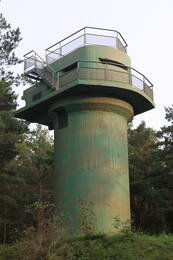
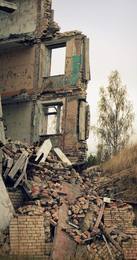
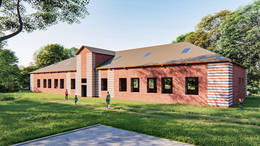
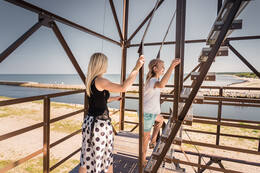
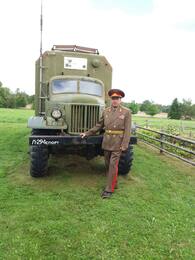
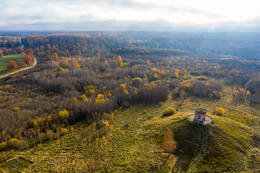
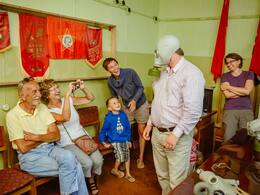
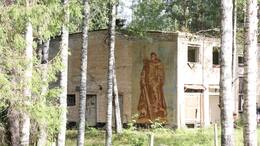
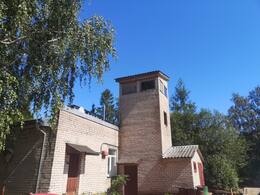

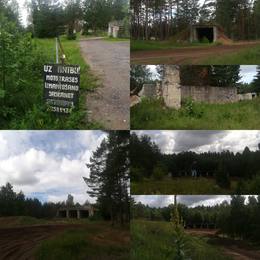
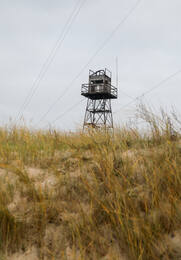
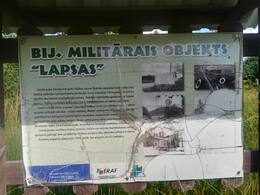
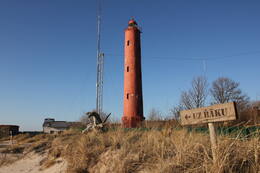
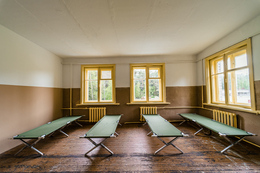
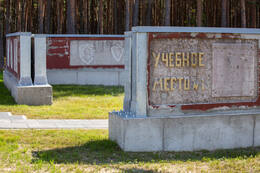
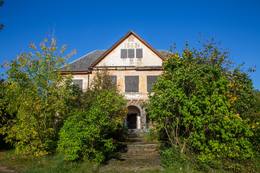
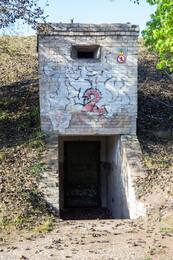
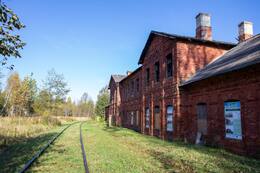
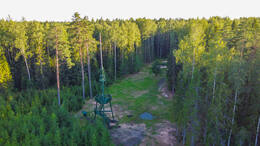
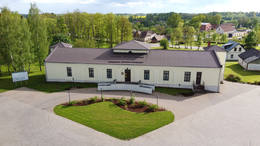
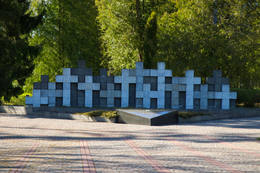
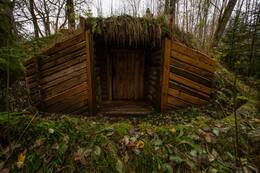
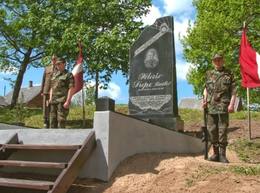
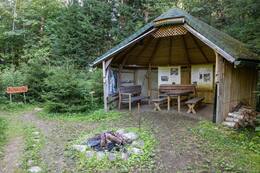
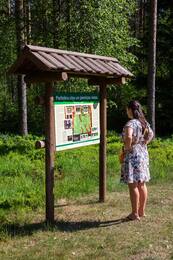
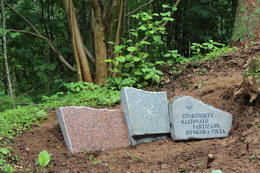
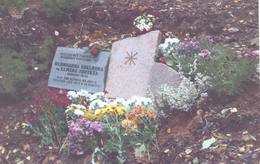
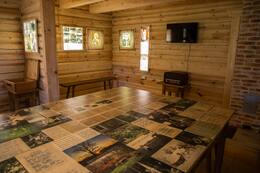
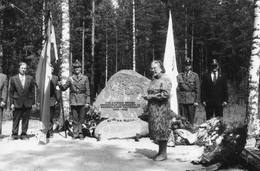
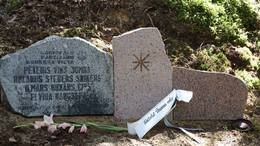
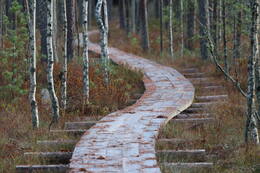
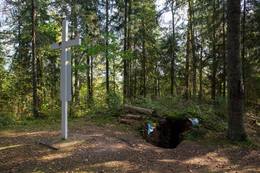
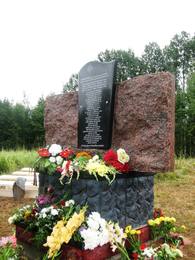
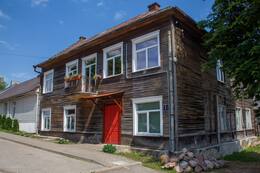
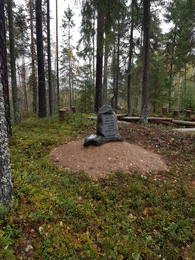
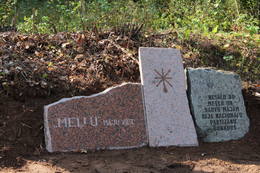
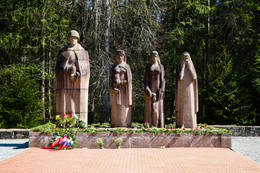
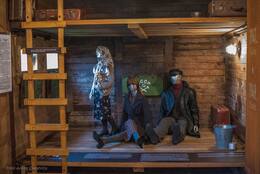
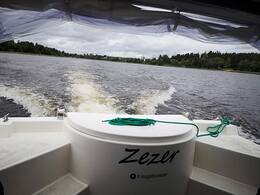
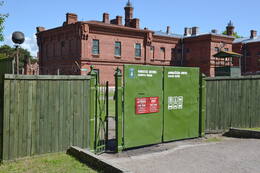
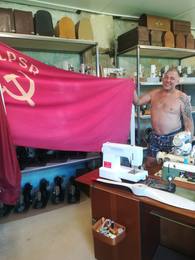
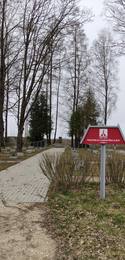
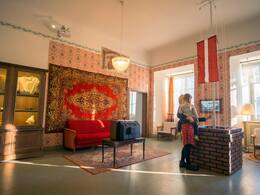
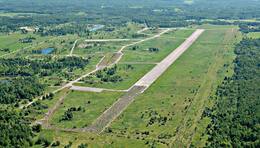
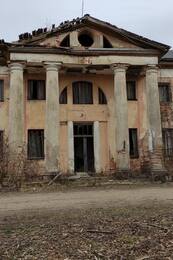
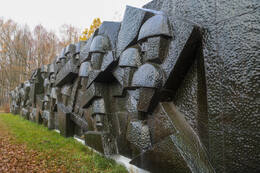
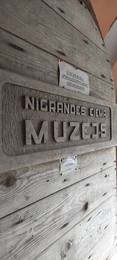
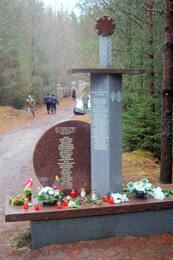
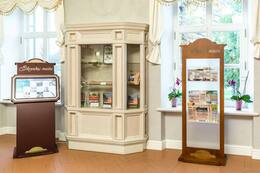

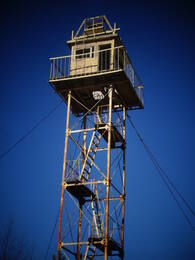
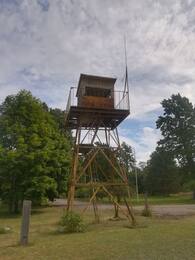
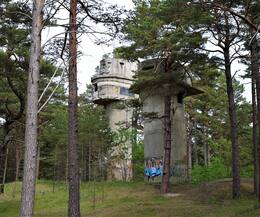
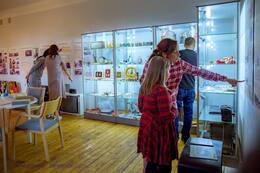

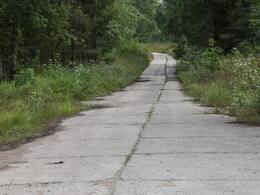
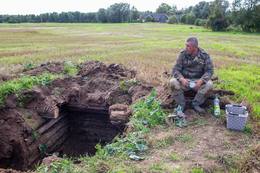
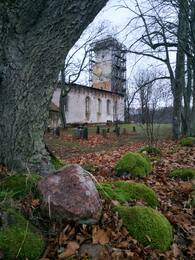
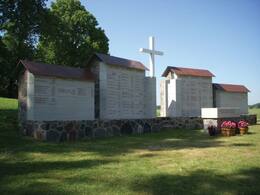
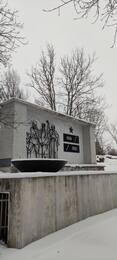
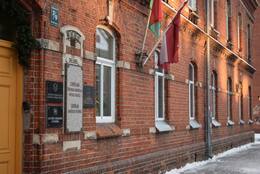
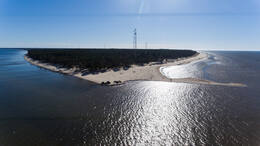
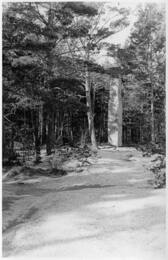
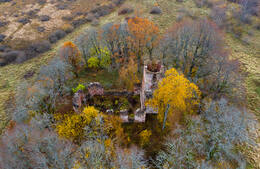
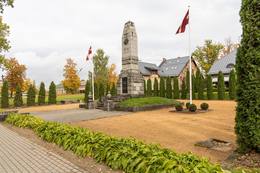
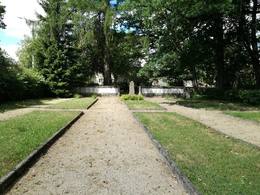
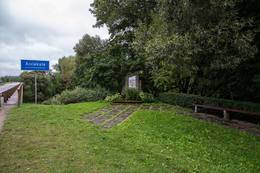
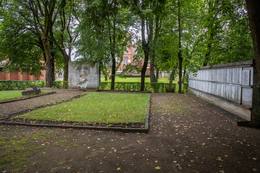
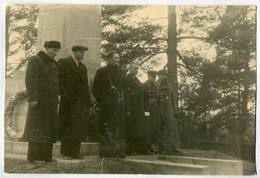
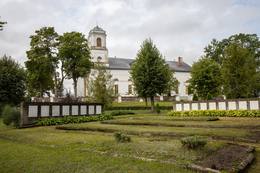
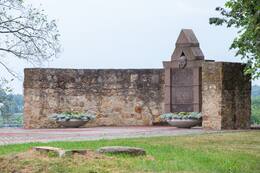
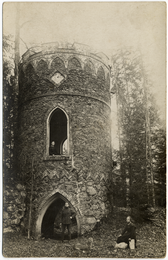
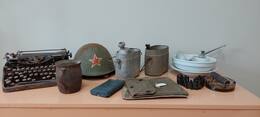
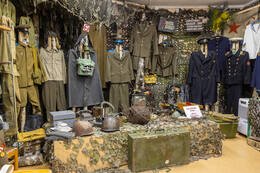
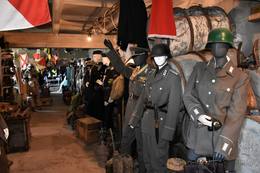
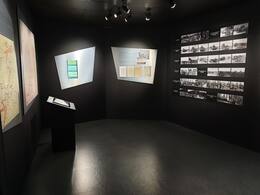
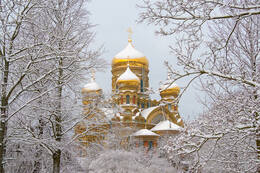

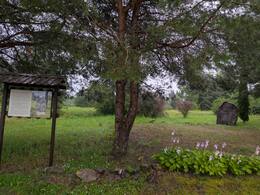
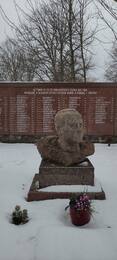
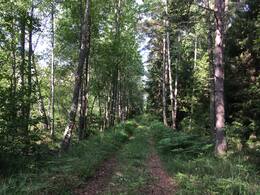
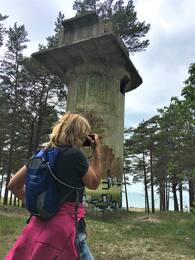

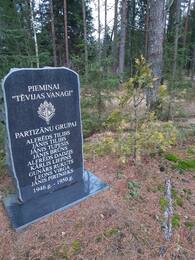
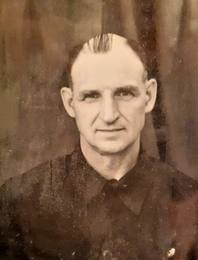
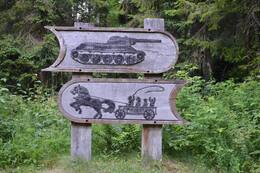
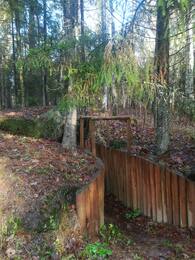
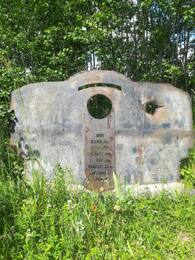
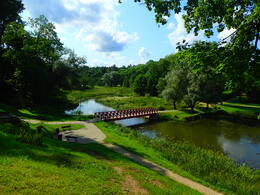
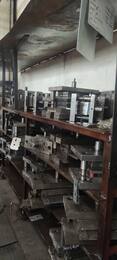
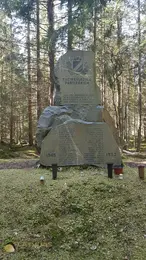
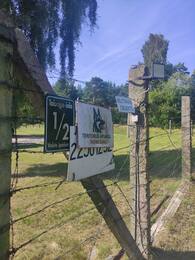
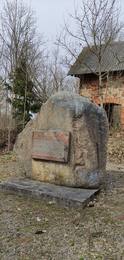
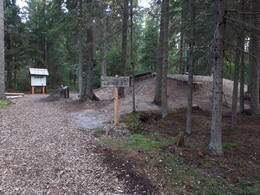
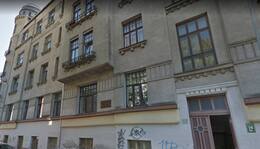
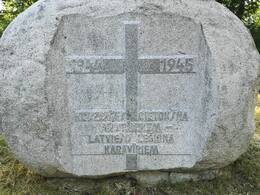
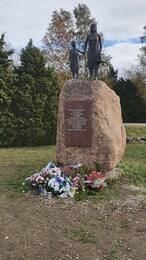
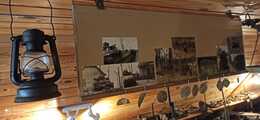
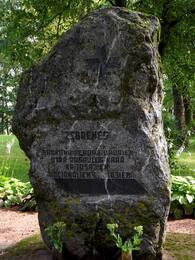
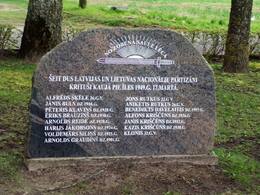
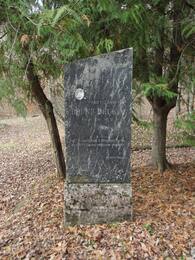
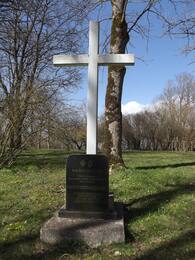
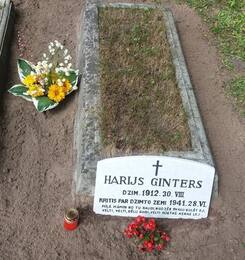
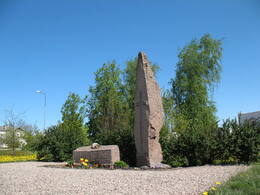
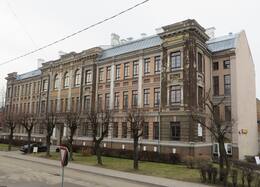
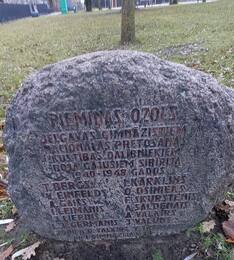
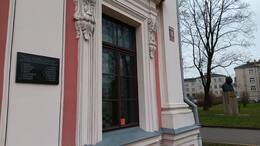
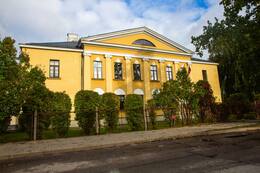
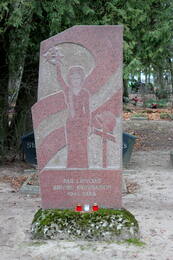
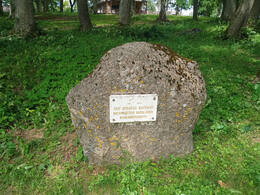
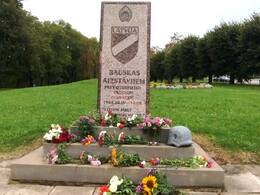
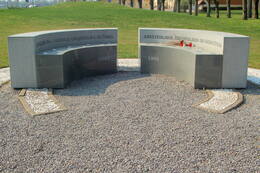
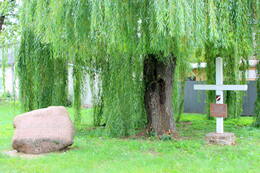
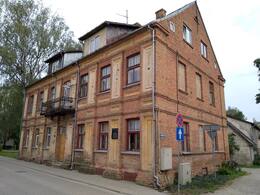
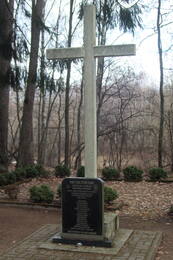
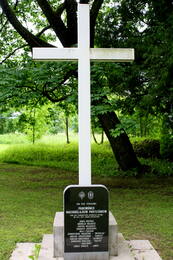
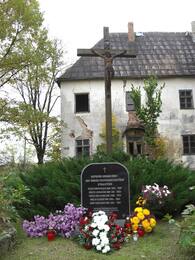
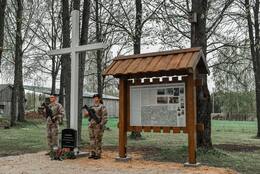
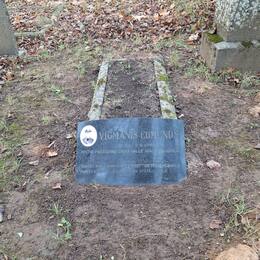
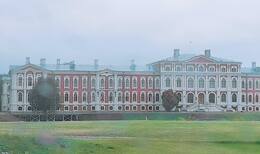
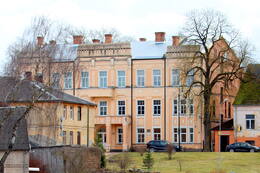
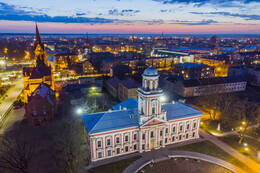
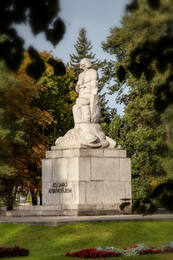
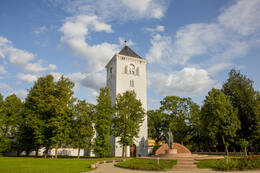
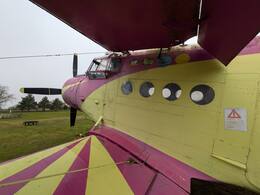
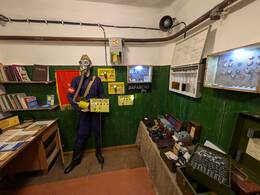

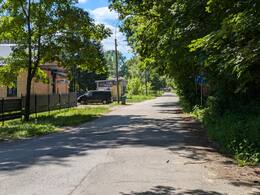
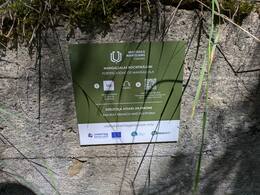
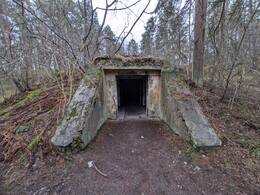
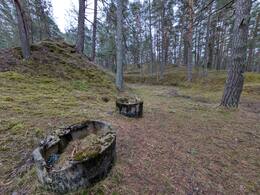
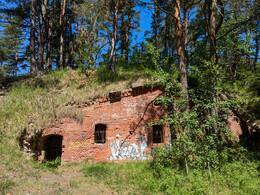
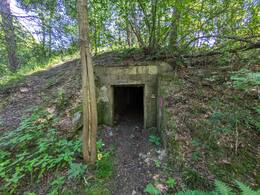
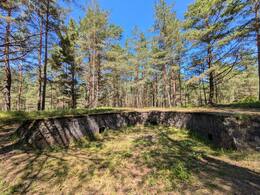
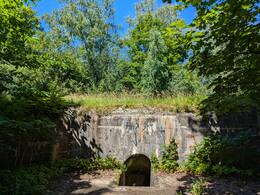
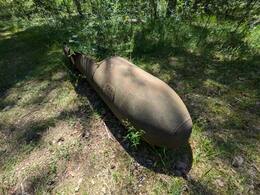
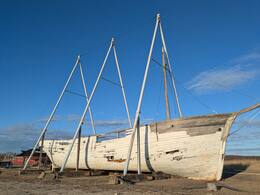
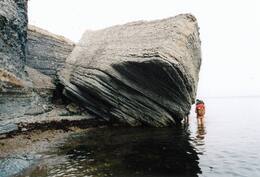
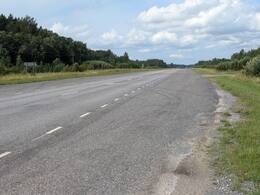
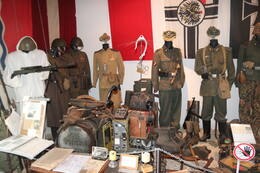
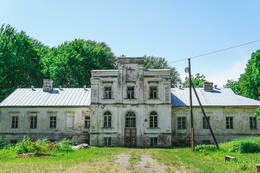
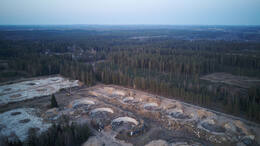
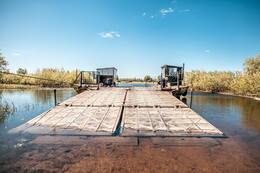

Sovietinė okupacija truko iki 1991. Sveiki. kodėl 1991 m., jei kariuomenė paliko poligoną 1993 m.